Early Views of Hollywood (1920 +)
Historical Photos of Early Hollywood |
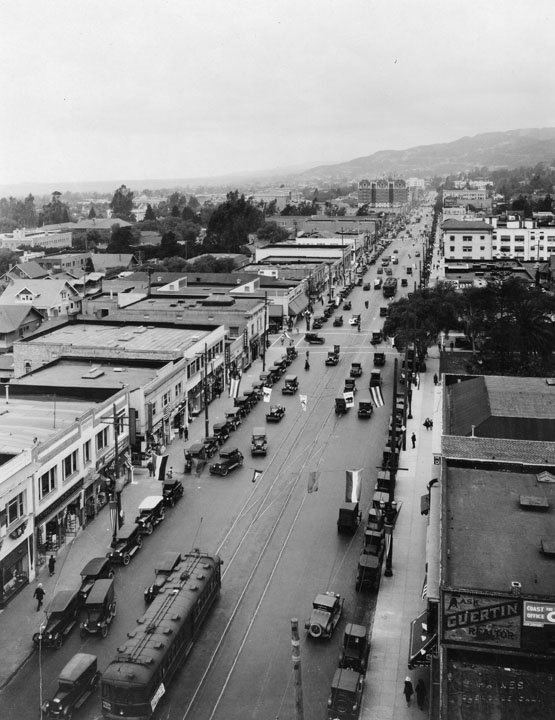 |
|
| (ca. 1923)* - Bird's eye view looking west on Hollywood Boulevard from the top of the Guaranty Building on the NE corner of Hollywood and Ivar. The Hollywood Public Market can be seen in the top center of photo at the corner of Wilcox. In the distance can be seen the three-towered Christie Hotel. |
Historical Notes The eight-story Christie Hotel was considered Hollywood's first skyscraper when it opened in 1922. |
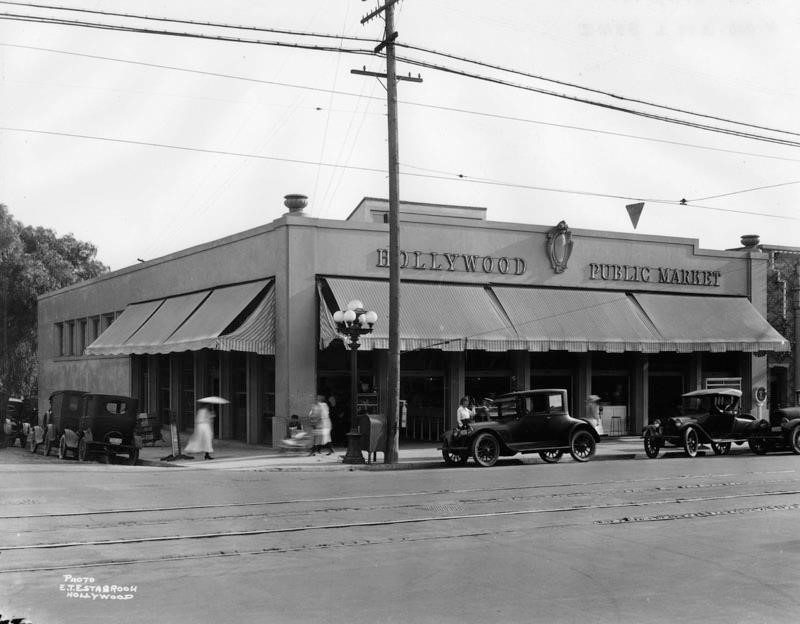 |
|
| (1922)* - View of the Hollywood Public Market located on the southwest corner of Hollywood Blvd. and Wilcox Ave. |
Historical Notes The Hollywood Public Market catered to automobile-driving customers when it opened in 1920. Located on Hollywood Boulevard (foreground) at Wilcox Street, it had eight departments and 5,000 square feet, which was large for the time. Soon, however, larger markets were built nearby.* |
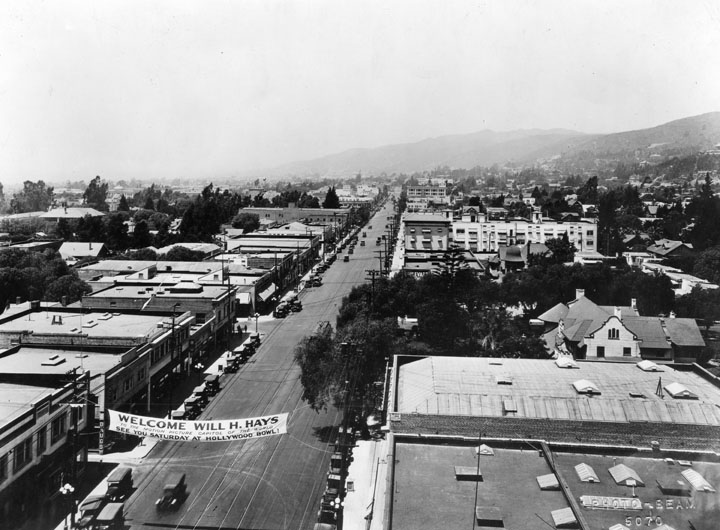 |
|
| (1923)* - Looking west down Hollywood Boulevard, a banner hangs over the street with the message "Welcome Will H. Hayes ... See you Saturday at Hollywood Bowl". |
Historical Notes Will H. Hays left President Harding's cabinet to clean up movie morals in the roaring '20s and in the film industry itself. He was best known as the author of Hollywood self-censorship with the Hays Code. While some industry heavyweights objected to Hays as the moral arbiter, he was recognized for guarding filmmakers' right to self-regulate at a time when seven states already had provisions for government censorship. Hays became president of the newly formed Motion Picture Assn. at a time when scandals in Hollywood had brought sharp public reactions. He retired in 1945, with his Hays Office the recognized arbiter of good taste in an industry that had accepted the principle of self- regulation.^^# |
Hollywood and Vine
 |
|
| (1920)*# - Aerial view looking northwest showing the intersection of Hollywood and Vine. On the southeast corner stands the Hollywood Methodist Episcopal Church, future home of the Taft Building. The very large lot at center-left is Jacob Stern’s estate. Jacob Stern had been selling off his land for over a decade by the time this photo was taken in 1920, but even so, his property still takes up ALL the land between Hollywood Blvd and Selma Ave on Vine! Three major buildings would occupy the Vine Street edge of Stern's property: B. H. Dyas Building (later Broadway-Hollywood), Hollywood Plaza Hotel, and the Vine Street Theatre. |
Historical Notes “Hollywood & Vine” became famous because of the 4 buildings that were built at that intersection between 1923 and 1930, the biggest ones in town at the time. Before that, real estate developer Jacob Stern owned a lot of the land around it, with his estate taking up the entire BLOCK from Hollywood to Selma! In 1913 he rented the Barn (on the SE corner of Vine/Selma) to Cecil B. DeMille which evolved into Paramount. The Taft building was first up, built in 1923 (they dismantled the church on the SE corner and reconstructed it down Vine below Santa Monica Blvd., then the Plaza Hotel (1925), with Dyas Dept Store (1927) which later became the Hollywood-Broadway Store on the SW corner, and finally the Equitable Building in 1930 (same time as The Pantages Theatre) on the NE corner. |
Jacob Stern Estate
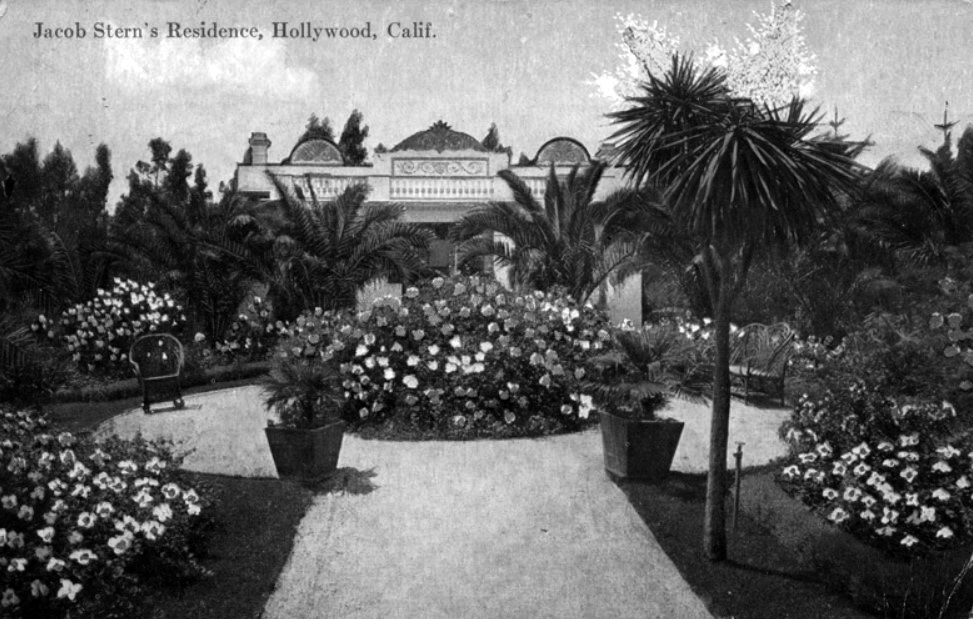 |
|
| (1920)^^ - Postcard view showing the Jacob Stern’s Residence located on center of block at southwest corner of Hollywood Blvd. and Vine Street, where now stand the Broadway-Hollywood, Plaza Hotel and other buildings in the block from Vine to Ivar and Hollywood Blvd. to Selma. |
Historical Notes German-born Jacob Stern was one of the most powerful movers and shakers in the village of Hollywood. In the early 1900s, Stern bought a five-acre tract at Hollywood and Vine for $30,000. Confident in Hollywood’s future, he told friends that his land would one day be worth $1 million. The Sterns lived in a grand home at Selma and Vine, and grew citrus trees and planted gardens on the remaining acres. Stern leased an old horse Barn (now the Hollywood Heritage Museum) to Jesse Lasky, the future founder of Paramount Pictures, officially bringing the movie industry to Hollywood. The Sterns were active in Hollywood’s genteel social life (in 1913 Mrs. Stern won first prize at the Hollywood Chrysanthemum Show for best display). When Stern sold his estate in the 1920s, it was worth not $1 million—but $3 million.^ |
* * * * * |
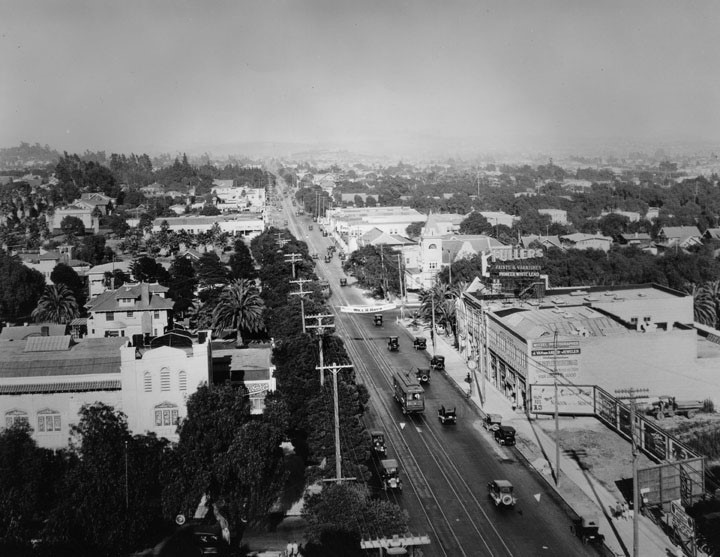 |
|
| (1921)*# – View looking east on Hollywood Boulevard toward Vine Street. The Hollywood Methodist Episcopal Church on the southeast corner (to the right of the banner) was built in 1903 and remained until 1923 when it was replaced by the Taft Building. |
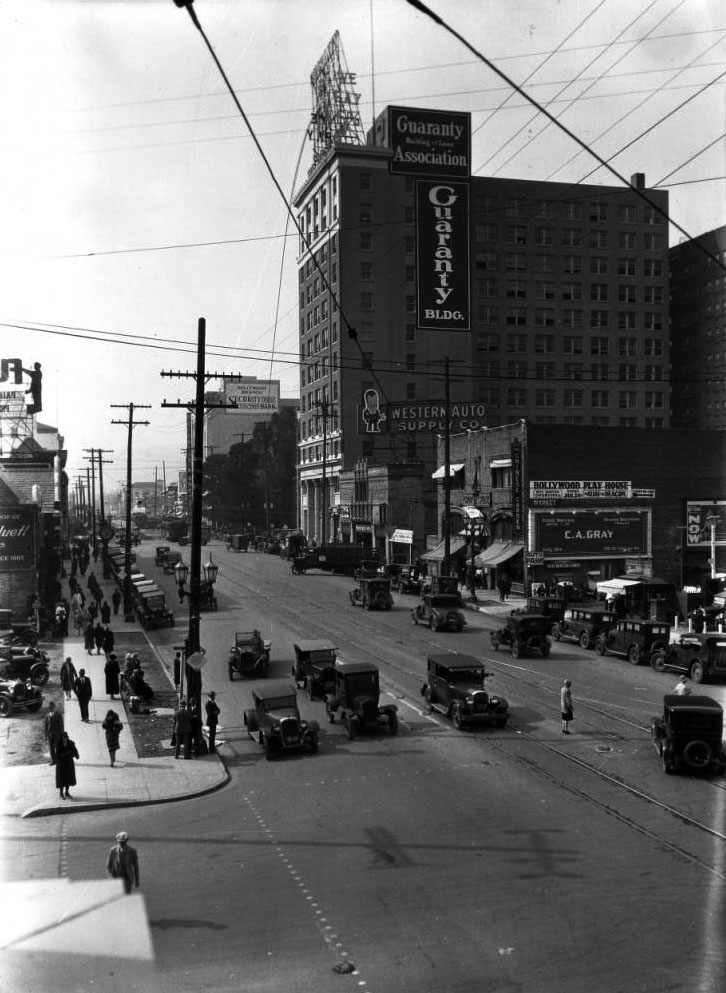 |
|
| (ca. 1923)^^ - View looking west on Hollywood Boulevard at Vine Street. Two-story buildings can be seen on both sides of Hollywood Boulevard, and the very tall, rectangular Guaranty Building can be seen at right at the northeast corner of Hollywood and Ivar. |
Historical Notes The 12-story Guaranty Building is a Beaux Arts office building built in 1923. It's currently owned by the Church of Scientology.*^ |
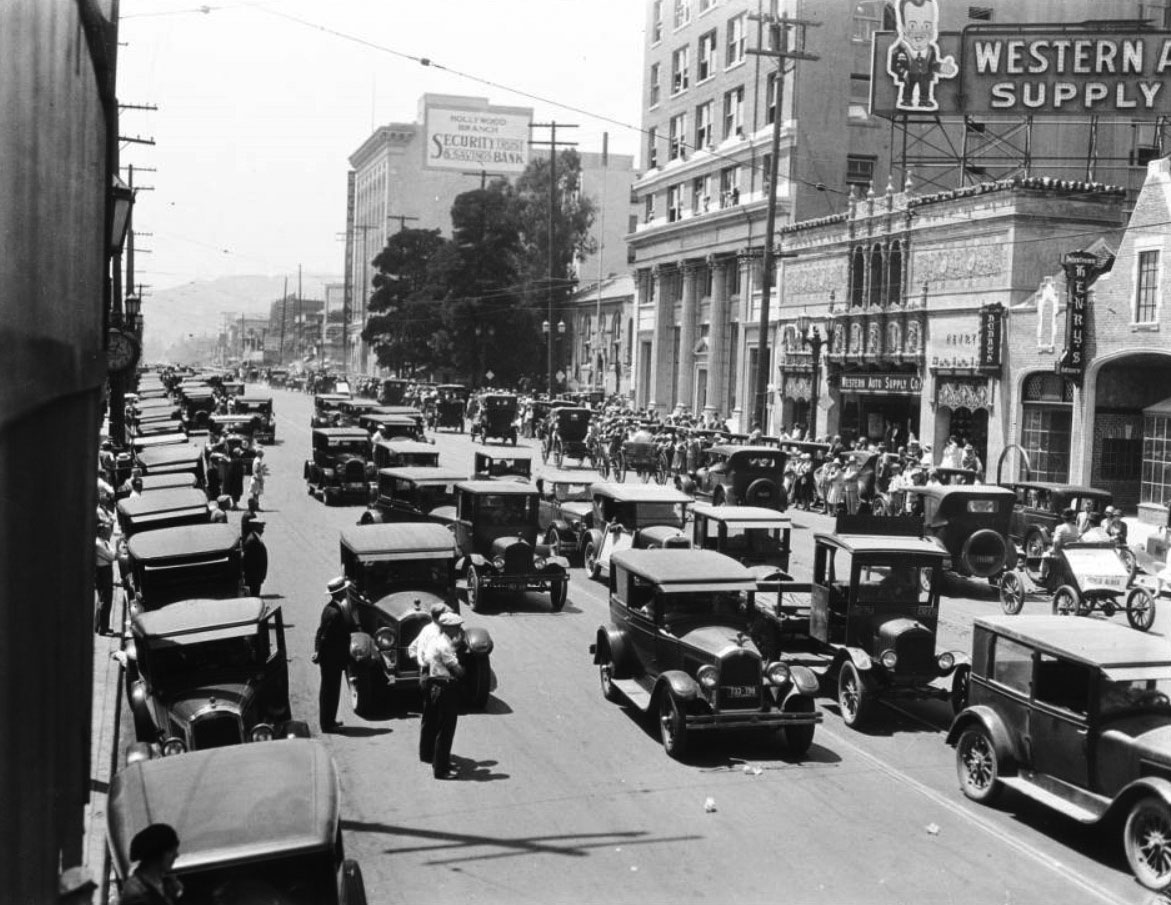 |
|
| (ca. 1923)^^ - View looking west on Hollywood Boulevard from Vine Street. A crowd of people appear to be watching some type of parade along the Boulevard. The tall building with the columns (center) is the Guaranty Building. The multi-story building in the distance is the Security Trust and Savings Bank located on the northeast corner of Hollywood and Cahuenga. |
.jpg) |
|
| (1923)* - View looking east on Hollywood Boulevard at Cahuenga showing traffic and pedestrians waiting to cross. The Security Trust and Savings Bank is on the left side of the photograph. In the distance is the Guaranty Building flying an American Flag. |
 |
|
| (1923)^##* – Close-up street view looking east on Hollywood Boulevard at Cahuenga with the Majestic Bowling and Billiard Academy at 6830 Hollywood Boulevard on the southeast corner. |
Historical Notes Down the street is Western Union, Dairy Lunch and John's Café one of the first (if not 'the' first) celebrity restaurants. This corner building was Wilcox Hall and housed the early Hollywood Civic Center (municipal offices). It was be torn down in 1934.^##* |
Hollywood Branch Library
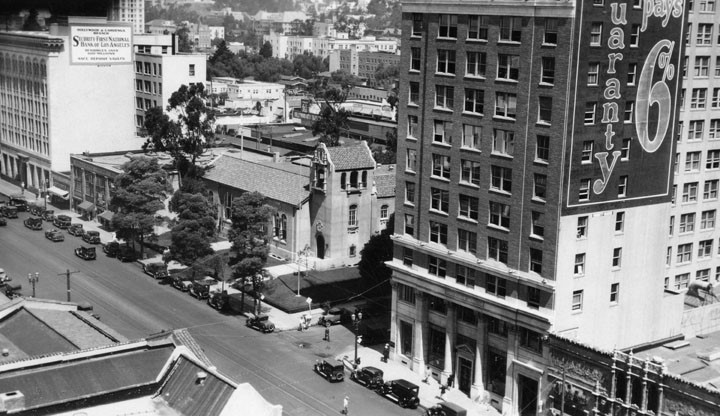 |
|
| (1929)* - View from the top of the Dyas Building showing the Hollywood Branch Library (center-left), located on the NW corner of Hollywood and Ivar. The 12-story Guaranty Building can be seen on the NE corner (on the right). |
Historical Notes The original Hollywood library, a project of the Women’s Club of Hollywood, opened on Feb. 3, 1906, in two rented rooms in the Van Scycle Building on Prospect Avenue (now Hollywood Boulevard). The library’s first permanent home was a structure built in 1907 by Andrew Carnegie at Ivar and Prospect avenues. When Hollywood was annexed to Los Angeles on Feb. 10, 1910, it became a branch of the Los Angeles Public Library. By 1923, Hollywood’s library had outgrown its Carnegie quarters and a new building was constructed at 6357 Hollywood Blvd. Seventeen years later, the Hollywood library moved to its present location at 1623 Ivar Ave. |
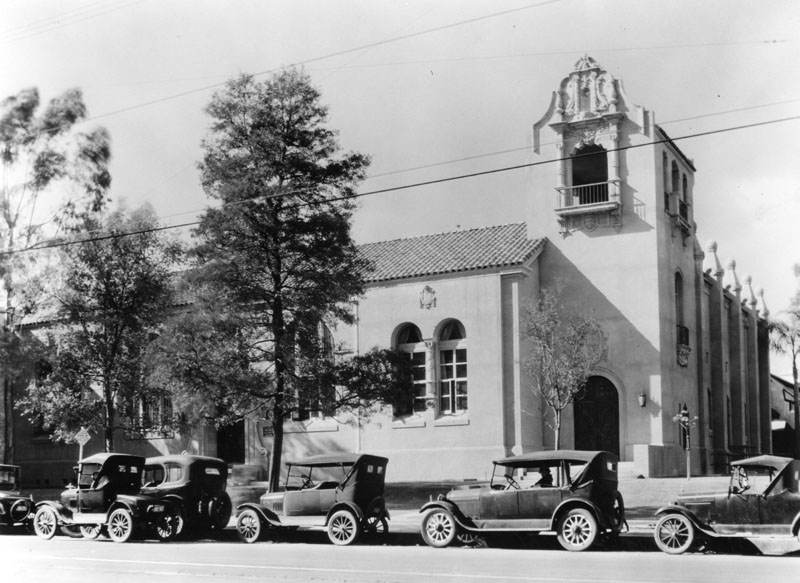 |
|
| (1923)* - Exterior view of Hollywood Branch Library at 6357 Hollywood Boulevard, northwest corner of Hollywood Boulevard and Ivar Avenue*. Designed by Dodd & Richards, the Spanish style building housed the Hollywood Branch of LAPL from 1923-1939. |
Historical Notes *Ivar Avenue was named after Ivar Weid, owner of Weid Ranch. |
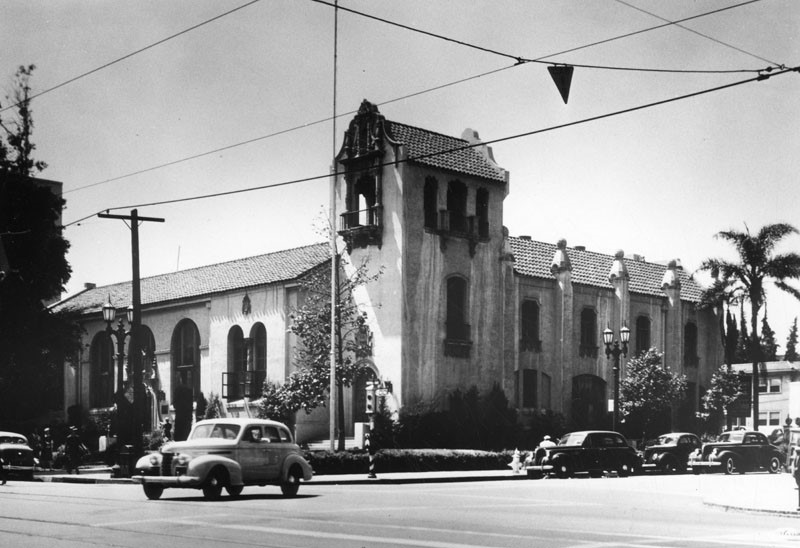 |
|
| (ca. 1939)* - View looking at the northwest corner of Hollywood Boulevard and Ivar Ave showing the Hollywood Branch Library. Click HERE for contemporary view of the corner. |
.jpg) |
|
| (ca. 1939)* - View looking at the Ivar Avenue side of the Hollywood Branch Library at 6357 Hollywood Boulevard. |
Historical Notes In 1939, this Spanish style building was cut into two sections and moved to a new location at Ivar near Selma Avenues. The building would be destroyed by an arson fire in 1982. In 1986, a new Frank Gehry-design library was built at 1623 N. Ivar Ave which still stands today. The new building was 100% funded by the Samuel Goldwyn Foundation. Click HERE to see the current Hollywood Branch Library. |
* * * * * |
William Fox Studios
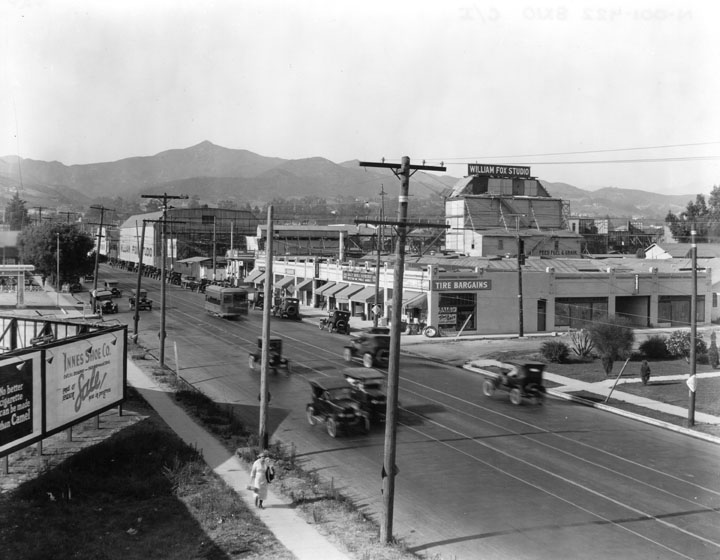 |
|
| (ca. 1923)* - Looking north at the intersection of Western and Fernwood avenues (just south of Sunset Boulevard), The William Fox Studios operated out of Hollywood from 1917-1924 before moving west to what is now Century City. |
Historical Notes The Fox Film Corporation was formed in 1915 by the theater chain pioneer William Fox, who merged two companies he had established just two years earlier in 1913: Greater New York Film Rental, a distribution firm, which was part of the Independents; and Fox (or Box, depending on the source) Office Attractions Company, a production company. Fox concentrated on acquiring and building theaters; pictures were secondary. The company's first film studios were set up in Fort Lee, New Jersey where it and many other early film studios in America's first motion picture industry were based at the beginning of the 20th century. William Fox sent Sol M. Wurtzel to Hollywood to oversee the studio's West Coast production facilities where a more hospitable and cost-effective climate existed for filmmaking. Fox had purchased the Edendale studio of the failing Selig Polyscope Company, which had been making films in Los Angeles since 1909 and was the first motion picture studio in Los Angeles. 20th Century Fox was founded on May 31, 1935, as the result of the merger of Fox Film Corporation, founded by William Fox in 1915, and Twentieth Century Pictures, founded in 1933 by Darryl F. Zanuck, Joseph Schenck, Raymond Griffith and William Goetz.*^ |
* * * * * |
Pickford-Fairbanks Studios (later United Artists Studios)
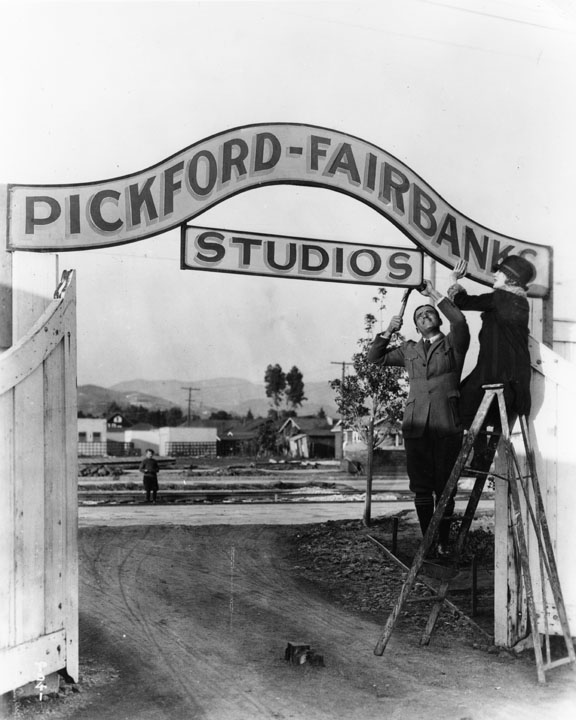 |
|
| (1922)^ - Mary Pickford and Douglas Fairbanks hang the entrance signs for their Pickford-Fairbanks Studios near the corner of Santa Monica Boulevard and Formosa Avenue in West Hollywood. |
Historical Notes When United Artists was formed in 1919 by Charlie Chaplin, Mary Pickford, Douglas Fairbanks, and D. W. Griffith, the founders never intended the company to be like a regular Hollywood studio. It started solely as a distribution company. Its mission was to release films made by independent producers, therefore it had no studio lot. However, many of the independent producers owned their own property, like the Charlie Chaplin Studio on Sunset Boulevard. The closest thing to a studio lot was the property owned by Pickford and Fairbanks on the corner of Santa Monica Boulevard and Formosa Avenue in Hollywood. The studio lot's address is now 1041 North Formosa Avenue. |
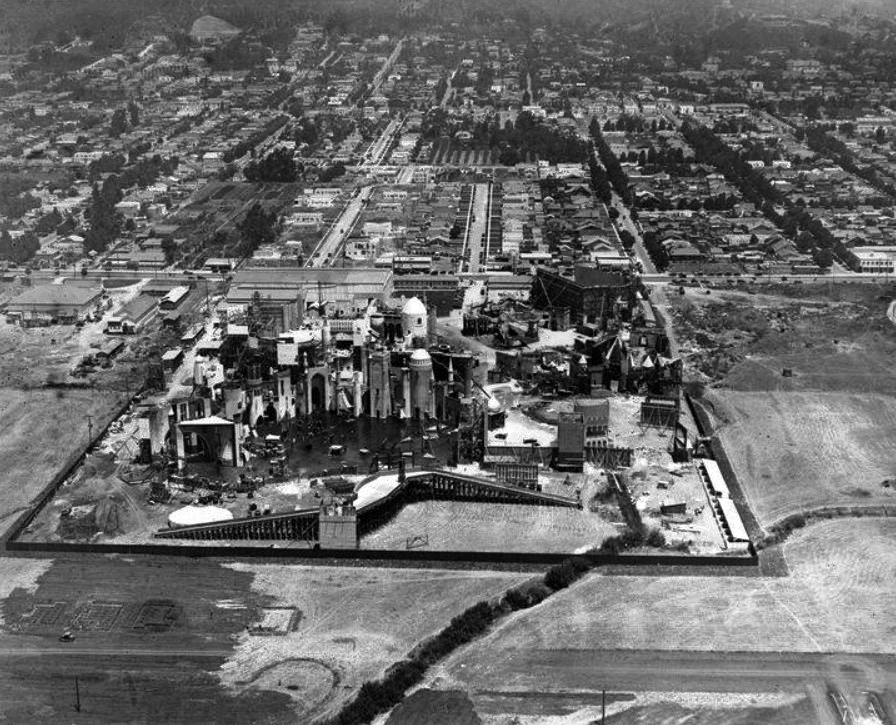 |
|
| (1923)* - Aerial view of the Pickford-Fairbanks Studios located at the corner Santa Monica Boulevard and Formosa Avenue, showing the amazing set for Douglas Fairbanks’ “Thief of Bagdad”. Note all the open land surrounding the studio. |
Historical Notes The 18-acre property on the corner of Santa Monica Boulevard and Formosa Avenue was originally owned by Jesse Durham Hampton, and then became known as the Pickford-Fairbanks Studio. As United Artists began to lure independent producers away from the major studios, many of the producers like Samuel Goldwyn and Joseph Schenck rented offices and stages on the property. In the early 1920s, the lot was renamed the United Artists Studio, though it was operated as a separate entity from United Artists the distribution company.* |
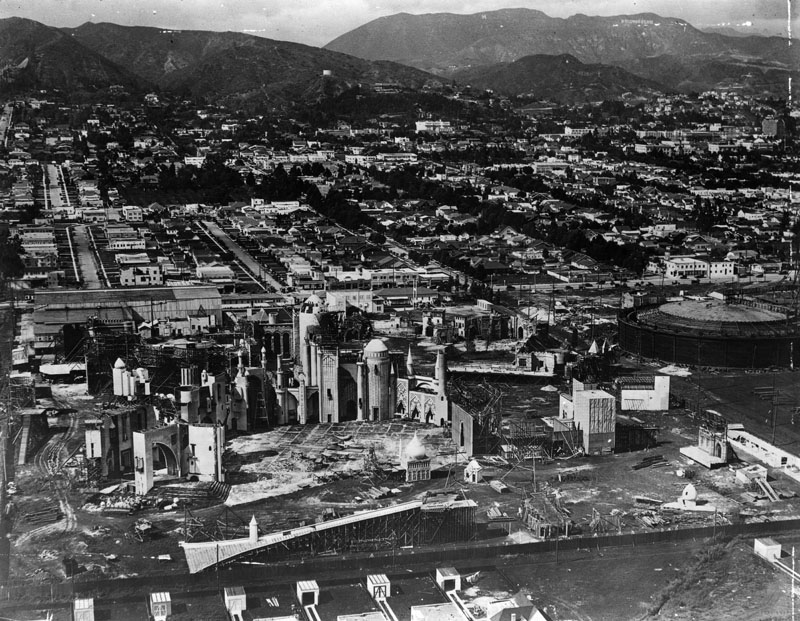 |
|
| (ca. 1924)* - Aerial view of the Thief of Bagdad set at the Pickford-Fairbanks Studios. The Studio was located at Santa Monica Blvd. and Formosa. The Hollywoodland Sign is seen in the distance (upper-right). Note the large circular structure at center-right. It is a gas holder (or Gasometer) which holds natural gas. |
Historical Notes Goldwyn and Schenck financed the expansion of the studio, creating an awkward ownership structure. Pickford and Fairbanks controlled the deed to the land, but Goldwyn and Schenck owned the actual facilities on the lot. In 1935 when Scheck left United Artists, Goldwyn took over his share. After Douglas Fairbanks died in 1939, leaving his share of the deed to Mary Pickford, Goldwyn sought to rename the lot "Samuel Goldwyn Studio." Pickford and Goldwyn fought over the name and ownership of the property until a court ordered that the lot be auctioned in 1955. James Mulvey, Goldwyn's most trusted business confidant and president of Samuel Goldwyn Inc., outbid Pickford for the property. The lot officially became Samuel Goldwyn Studio and remained so until Warner Brothers purchased the site in 1980.^ |
 |
|
| (1926)*# - View of the Pickford-Fairbanks Studios lot on Santa Monica Boulevard in West Hollywood, showing the nearby Gasometer towering in the background. |
Historical Notes Warner Bros. sold the studio lot in 1999 and the name of this studio lot was changed to "The Lot." Across the street is the Formosa Cafe, a legendary Hollywood hangout. |
* * * * * |
Grauman's Egyptian Theatre
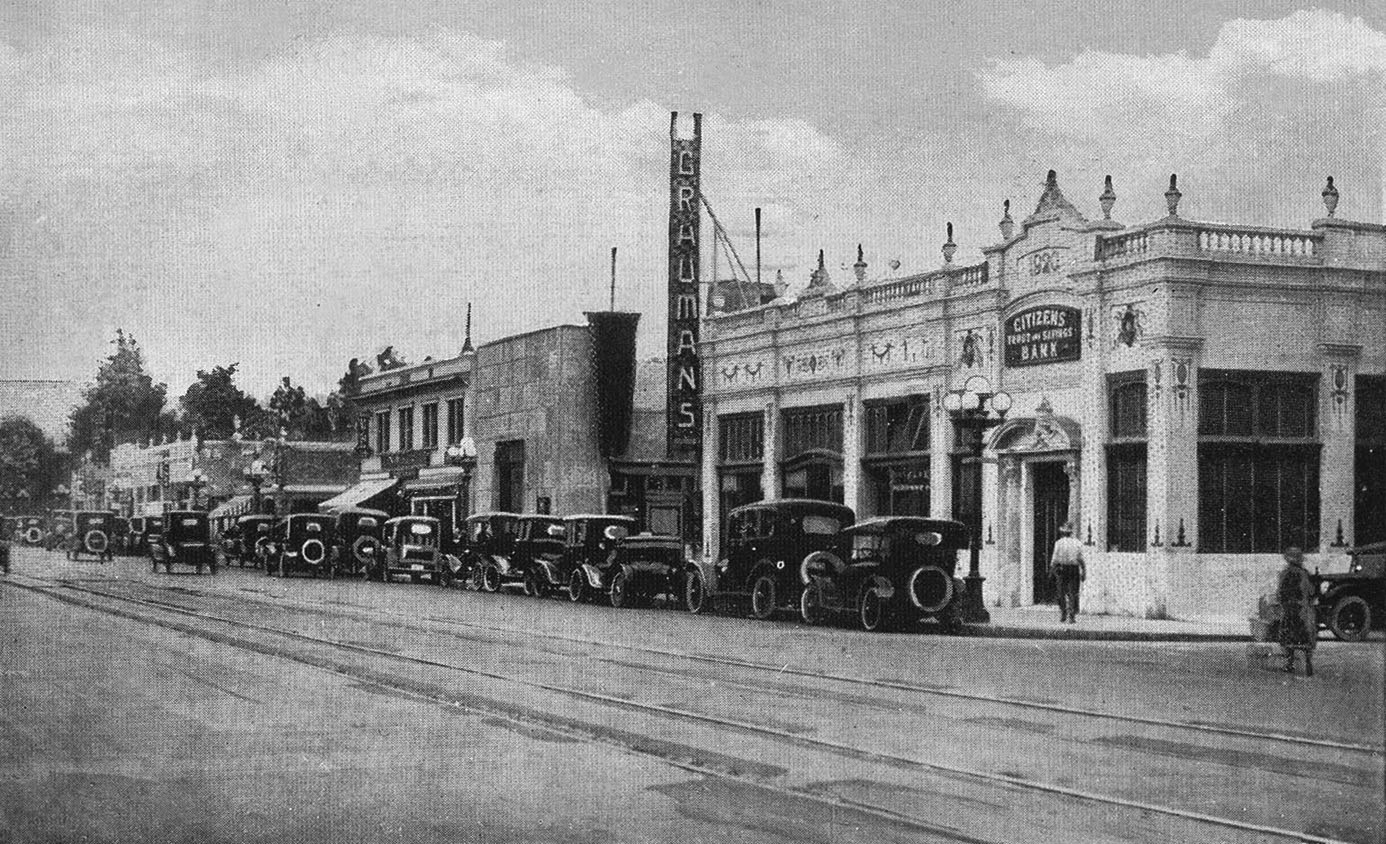 |
|
| (1922)^ - View looking east on Hollywood Boulevard at McCadden Place showing the newly opened Grauman's Egyptian Theater. |
Historical Notes The Egyptian Theatre was built by showman Sid Grauman and real estate developer Charles E. Toberman, who subsequently built the nearby El Capitan Theatre and Chinese Theatre on Hollywood Boulevard. Grauman had previously opened one of the United States' first movie palaces, the Million Dollar Theatre, on Broadway in Downtown Los Angeles in 1918. The Egyptian Theatre cost $800,000 to build and took eighteen months to construct.* McCadden Place was named after developer and subdivider W. C. McCadden. |
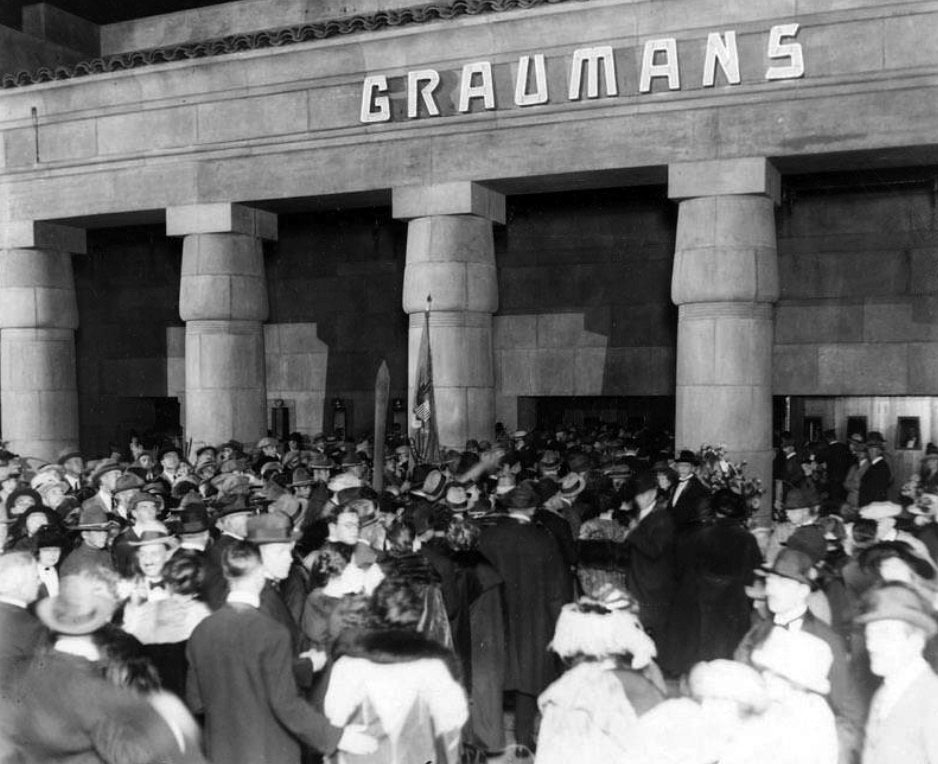 |
|
| (1922)^*^# - The Grauman's Egyptian Theatre on opening night. The film was Douglas Fairbanks' "Robin Hood," which was the first-ever Hollywood premiere. |
Historical Notes The Egyptian Theatre was the venue for the first-ever Hollywood premiere, Robin Hood, starring Douglas Fairbanks, on Wednesday, October 18, 1922. As the film reportedly cost over $1 million to produce, the admission price to the premiere was $5.00. One could reserve a seat up to two weeks in advance for the daily performances. Evening admission was 75¢, $1.00 or $1.50. The film was not shown in any other Los Angeles theater during that year.* The address 6712 Hollywood Boulevard, now the site of the Egyptian Theatre, was once the address of Gilbert F. Stevenson and his wife. In 1903, Stevenson, the Secretary and General Manager of the Western Masons Mutual Life Insurance Association, moved from downtown Los Angeles to a five acre lemon ranch on the corner of Prospect (now Hollywood Boulevard) and Dakota (now McCadden Place) Avenues.^#** |
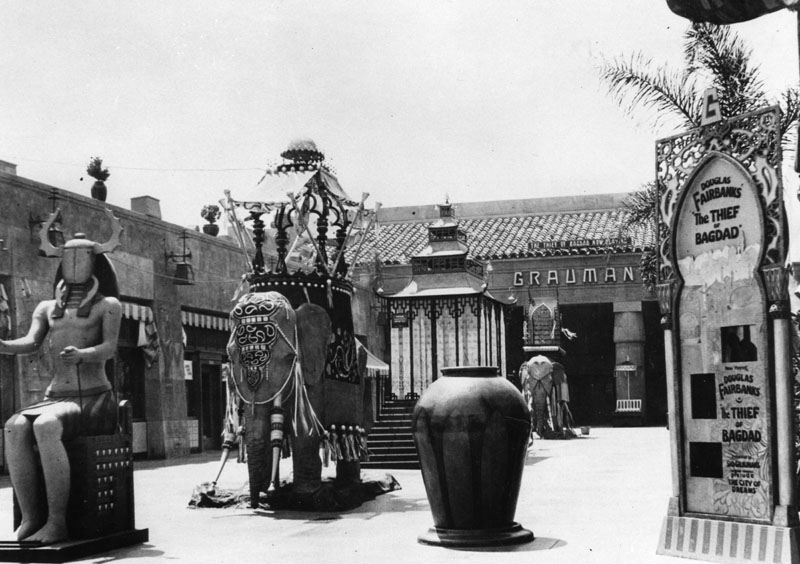 |
|
| (ca. 1923)* - A view of the courtyard of Grauman's Egyptian Theatre with statues of an Egyptian king, Indian elephants. Billboard advertising for Douglas Fairbanks "The Thief of Bagdad." |
Historical Notes King Tutankhamen’s tomb was discovered in Egypt on November 26, 1922 and an Egyptian craze swept the nation. |
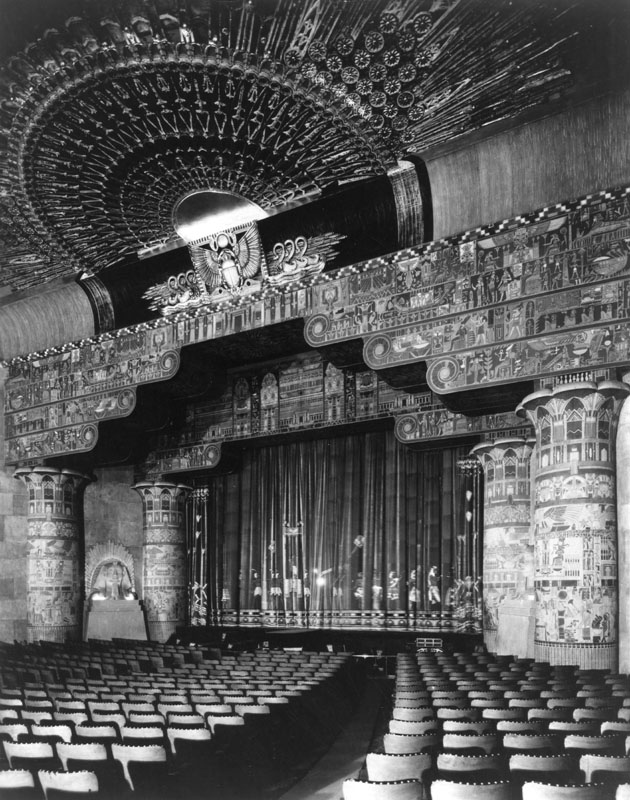 |
|
| (1922)* - Looking toward the stage across the seats in the auditorium, you can see the delicately carved arches around the stage as well as the ornate ceiling above it. |
Historical Notes Architects Meyer & Holler designed the Egyptian Theatre. The Milwaukee Building Company built it. |
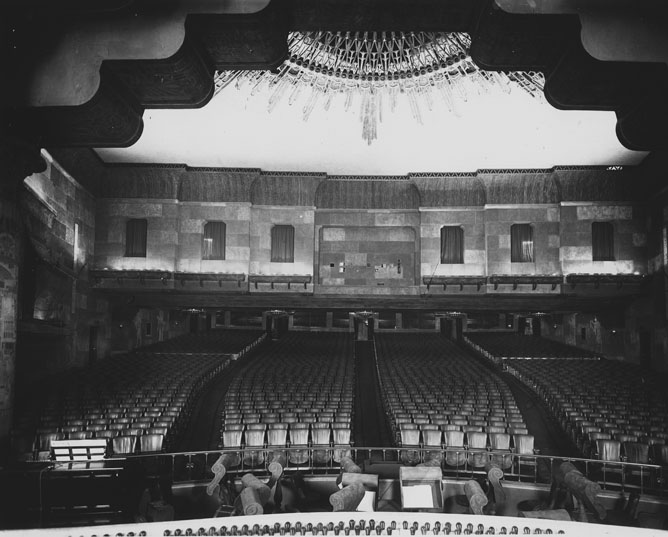 |
|
| (1924)* - Interior view of the Egyptian Theatre as seen from the stage. |
Historical Notes The original seating capacity of the theatre was close to 2,071 in a 115 by 125 foot auditorium. |
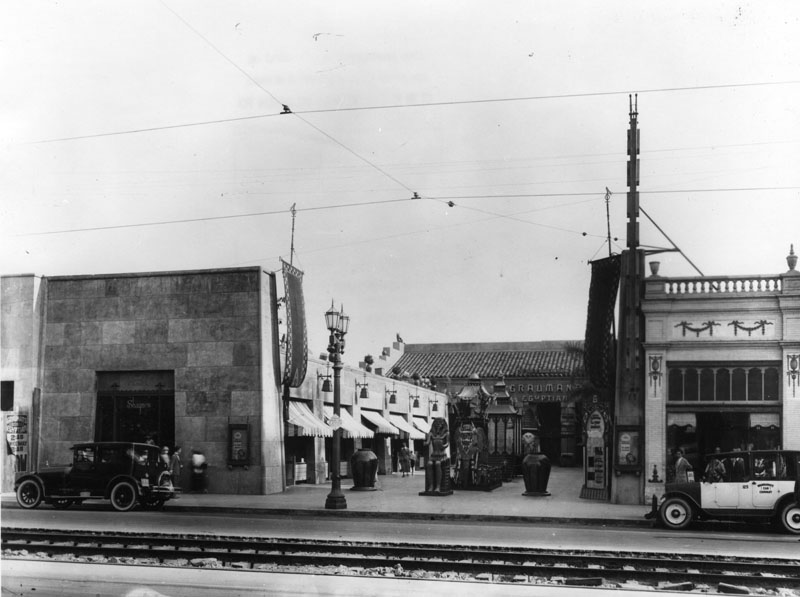 |
|
| (1924)* - View of the Grauman's Egyptian Theatre in 1924. Railroad tracks can be seen on Hollywood Boulevard in front of the theatre. |
Historical Notes The courtyard of the Egyptian is 45 feet wide and 150 feet long. The store fronts along the east side of the courtyard were described as having an "Oriental motif" and apparently sold imports. On the west side, the Pig ‘n Whistle restaurant, which opened on July 22, 1927 and operated until the late 1940s, had a side entrance onto the Egyptian Theatre courtyard. A small tiled area featuring the "pig ‘n whistle" motif still exists in the courtyard on the west wall near the fountain.^#** |
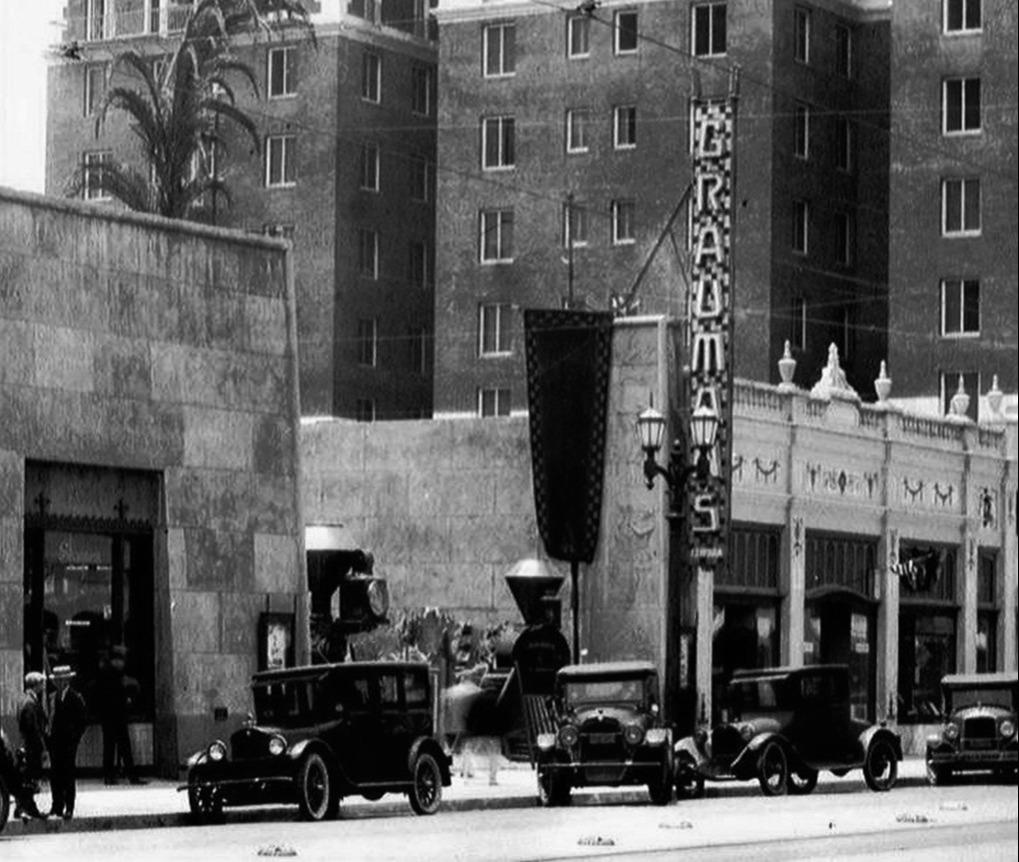 |
|
| (ca. 1924)* – Cars parked in front of Grauman’s Egyptian Theatre with the 1922-built Hotel Christie seen in the background. |
Historical Notes In 1927, Grauman would open a second movie theater further west on Hollywood Boulevard. In keeping with the public fascination in that era with international themes, he named his new theater the Chinese Theatre. Its popularity eventually rivaled and surpassed the Egyptian because of its numerous celebrity handprints, footprints and signatures in the cement of its forecourt.* |
 |
|
| (1932)*^#* – Postcard view of the front entrance to the Egyptian Theatre on Hollywood Boulevard. Now Playing: “Back Street” starring Irene Dunne and John Boles. |
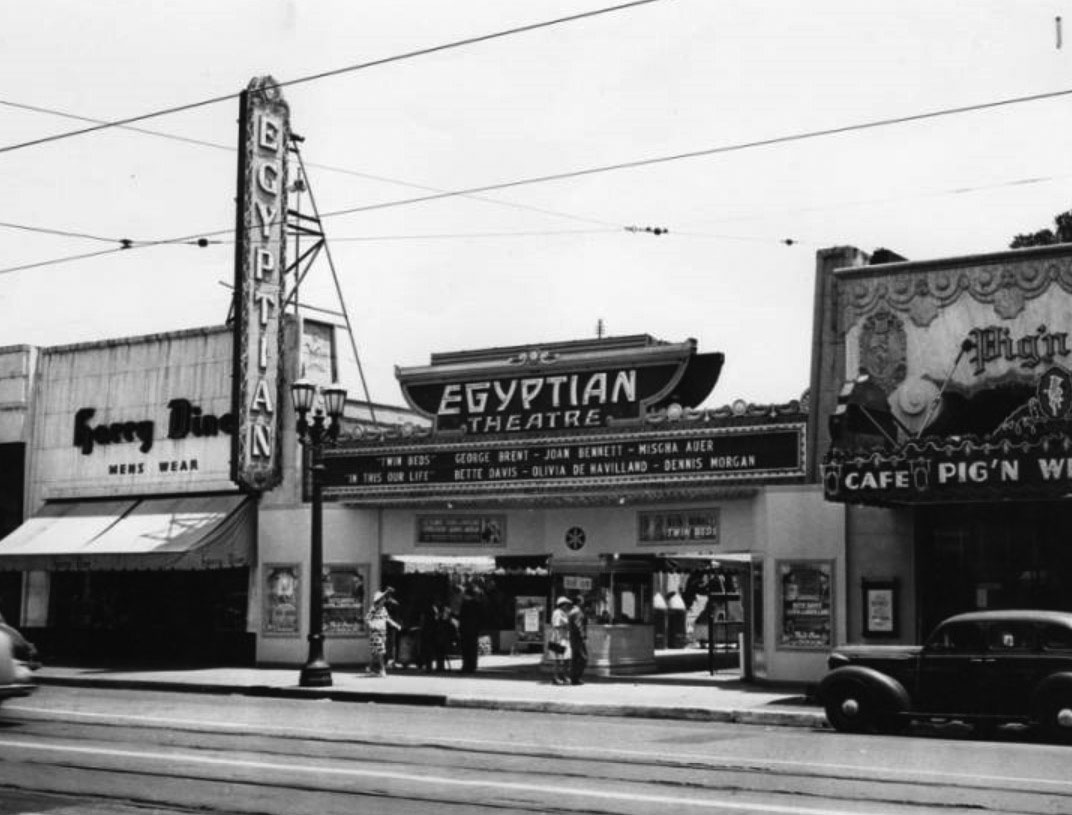 |
|
| (1942)* - View showing the entrance to the Egyptian Theatre with the Pig 'N Whistle Café seen on the right. The marquee reads: Twin Beds with George Brent, Joan Bennet, and Mischa Auer; and In This Our Life with Bette Davis, Olivia de Havilland, and Dennis Morgan. |
Then and Now
 |
|
| (1922 vs 2020)* - Looking east on Hollywood Boulevard at McCadden Place showing the 1922-built Grauman’s Egyptian Theatre. |
* * * * * |
Pig 'N Whistle Café
 |
|
| (1932)^.^ – View showing the Pig ‘N Whistle Café located at 6714 Hollywood Boulevard. The Egyptian Theatre is to the left (out of view). |
Historical Notes The Pig 'n Whistle was originally a chain of restaurants and candy shops, founded by John Gage in 1908. He opened his first location in Downtown Los Angeles, next to the now-demolished third city hall in the 200 block of South Broadway. The Hollywood location of the Pig 'N Whistle (seen above) was first opened in 1927 next to The Egyptian Theatre. The building housing the new restaurant cost $225,000 and featured "carved oak rafters, imported tiles, artistically wrought grilles and balcony and great paneled fresco paintings from Don Quixote."^ |
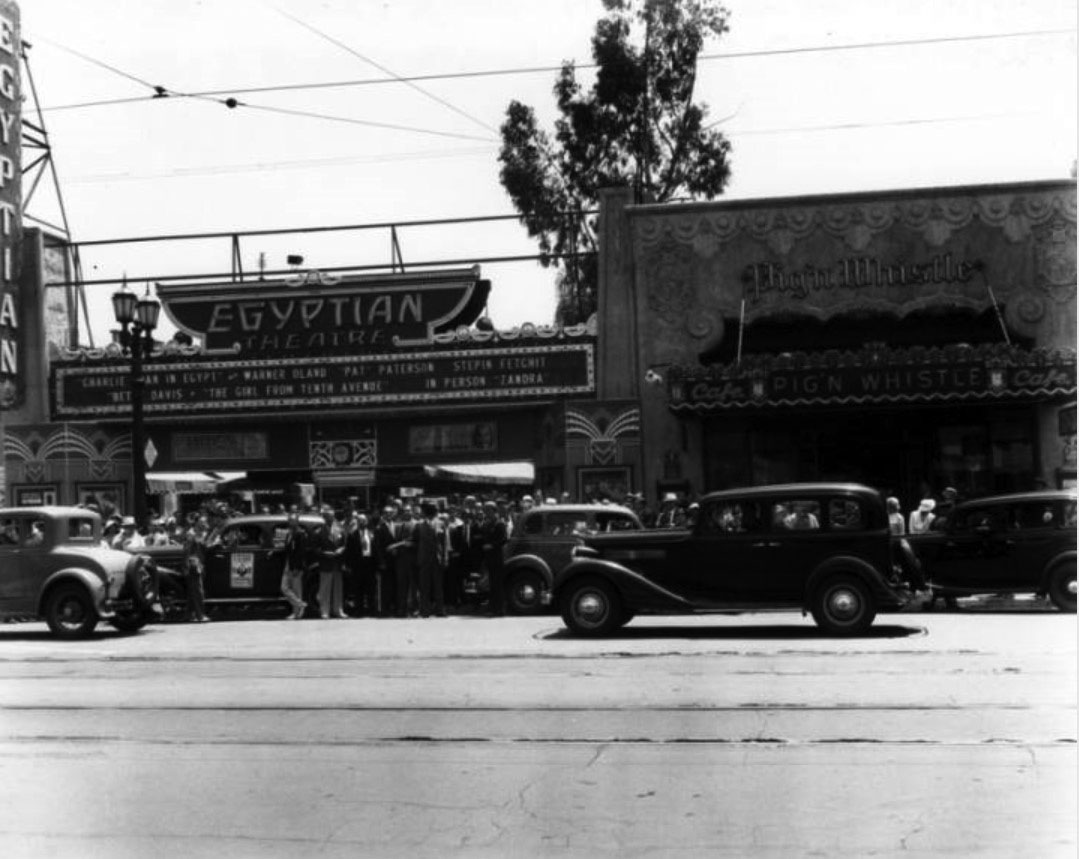 |
|
| (ca. 1933)* - Exterior view of Pig ‘N Whistle Café (right) and the Egyptian Theatre (left) on Hollywood Boulevard. The theater is showing "Charlie Chan in Egypt" with Warner Oland, Pat Paterson and Stepin Fetchit, and Bette Davis in "The Girl from Tenth Avenue." |
Historical Notes Pig ‘N Whistle Café was frequented by such celebrities as Spencer Tracy, Shirley Temple and Howard Hughes. By 1929, there were two other Pig ‘N Whistles in Hollywood, a tea and pastry shop near Highland and a restaurant in the Plaza Hotel known as the Plaza Pig. The corporate general manager, Sidney Hoedemaker, remained one of Los Angele’s top restaurateurs for the next three decades.^ |
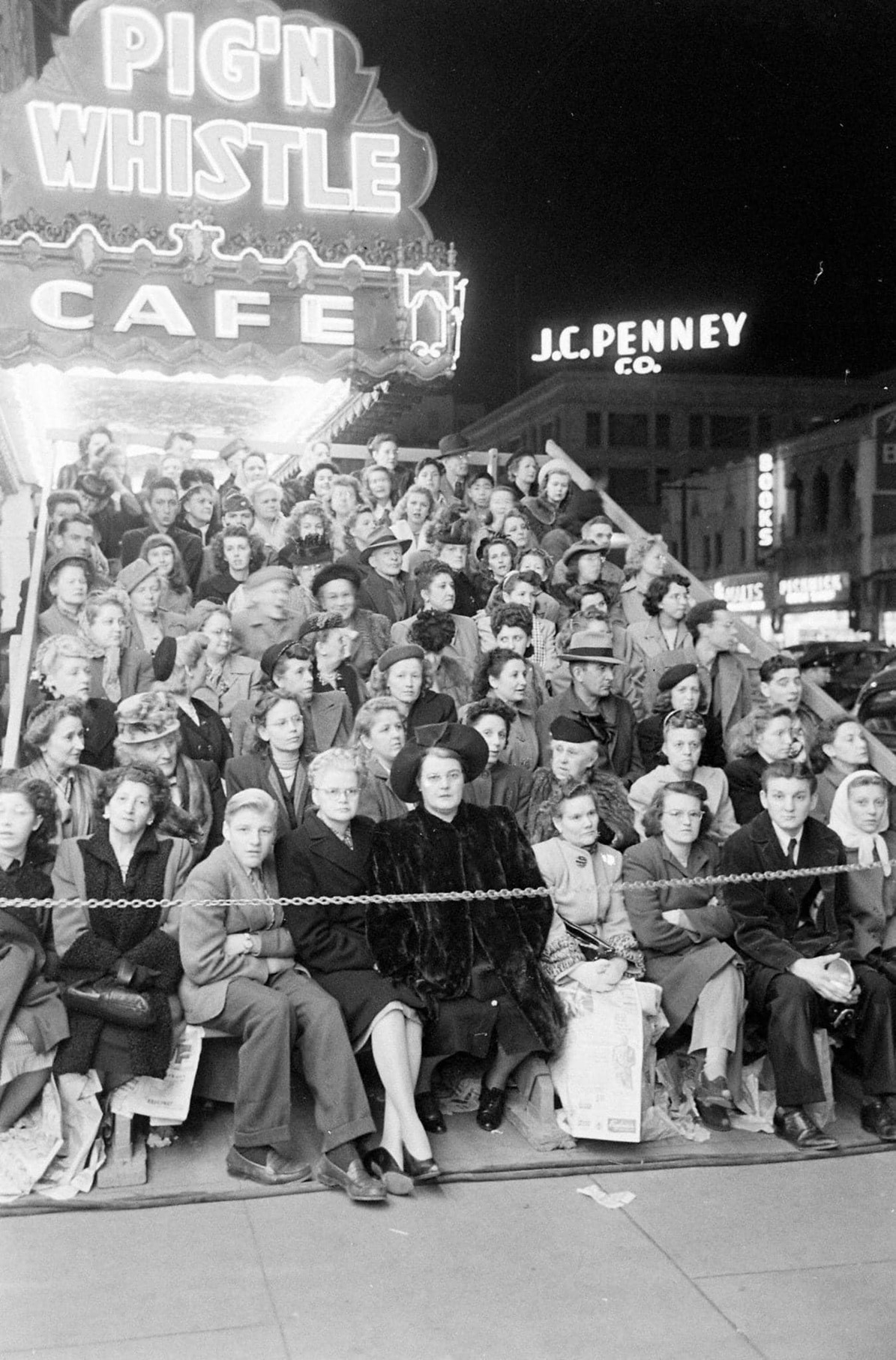 |
|
| (1948)* - A Hollywood movie premiere at the Egyptian Theater with crowds sitting in stands in front of Pig’N Whistle. The movie was Cass Timberlane starring Spencer Tracy and Lana Turner. Photographer - Peter Stackpole of Life Magazine. |
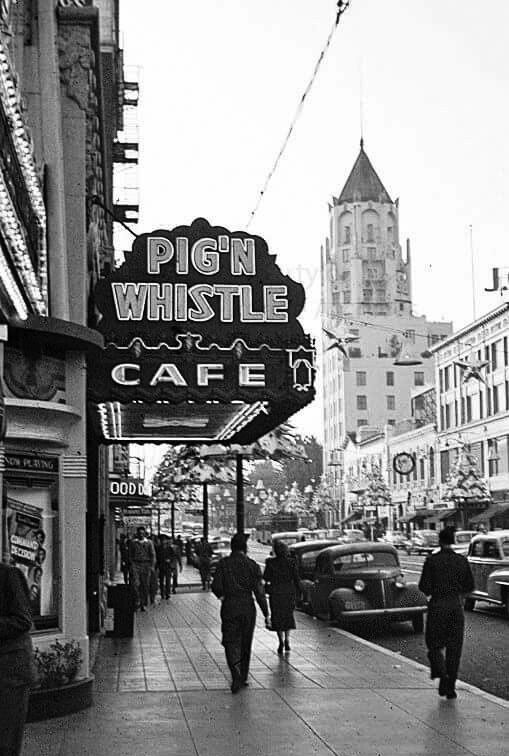 |
|
| (1948)^.^ – People are seen walking on the sidewalk in front of the Pig’N Whistle Cafe on Hollywood Boulevard. The The Hollywood First National Bank can be seen in the backgroud, on the northeast corner of Highland Avenue and Hollywood Boulevard. |
Historical Notes The original Hollywood location of Pig "N Whistle closed down after World War II and its distinctive wooden furniture, decorated with hand-carved whistle-playing pigs, was sold to Miceli's Italian Restaurant, located around the corner at 1646 Las Palmas Avenue, where it remains to the present day.^ |
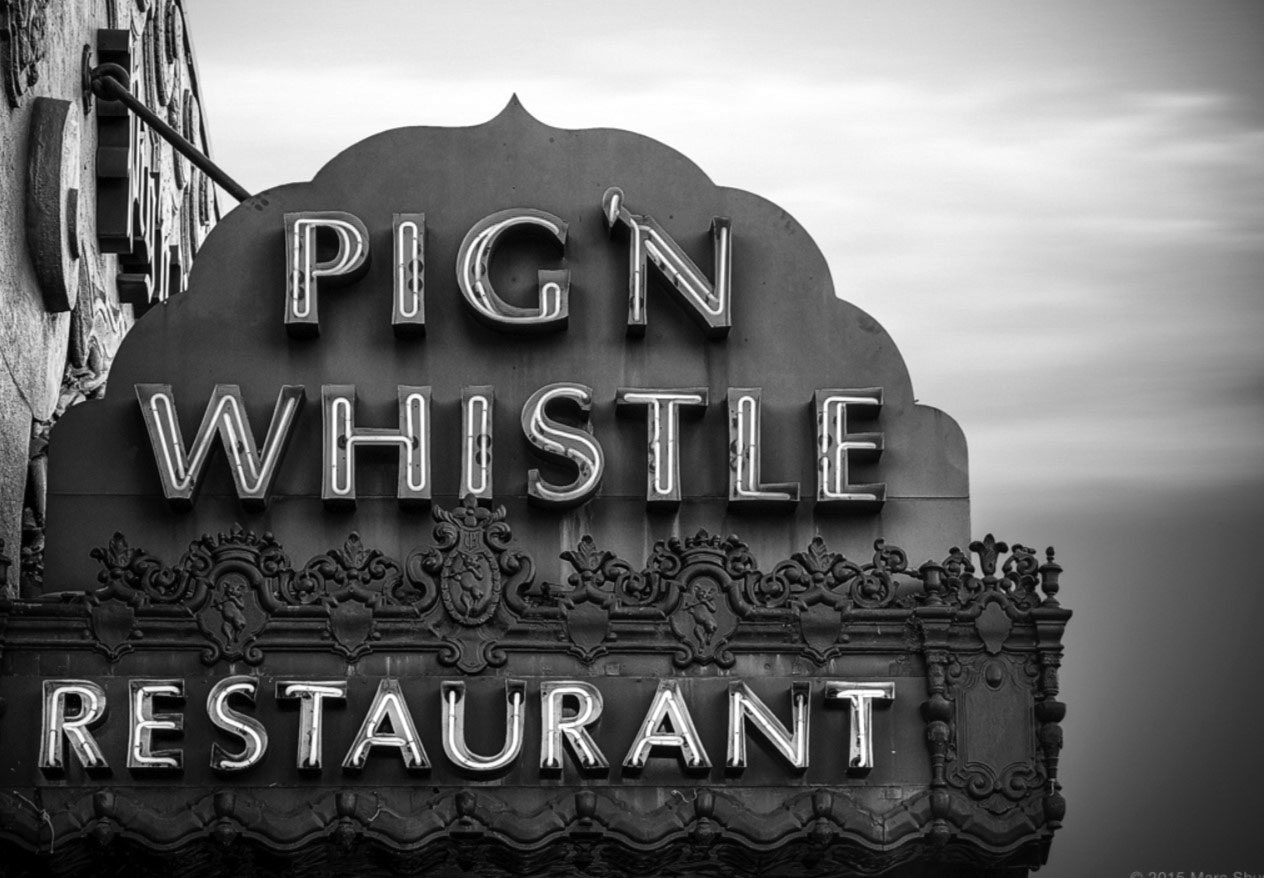 |
|
| (2014)^.^ - Pig ‘N Whistle, 6714 Hollywood Blvd. |
Historical Notes The restaurant name originates from two Old English words, piggin, a lead mug, and wassail, a wine drunk during yuletide.^ |
* * * * * |
Bard's Hollywood Theatre (later Vista Theatre)
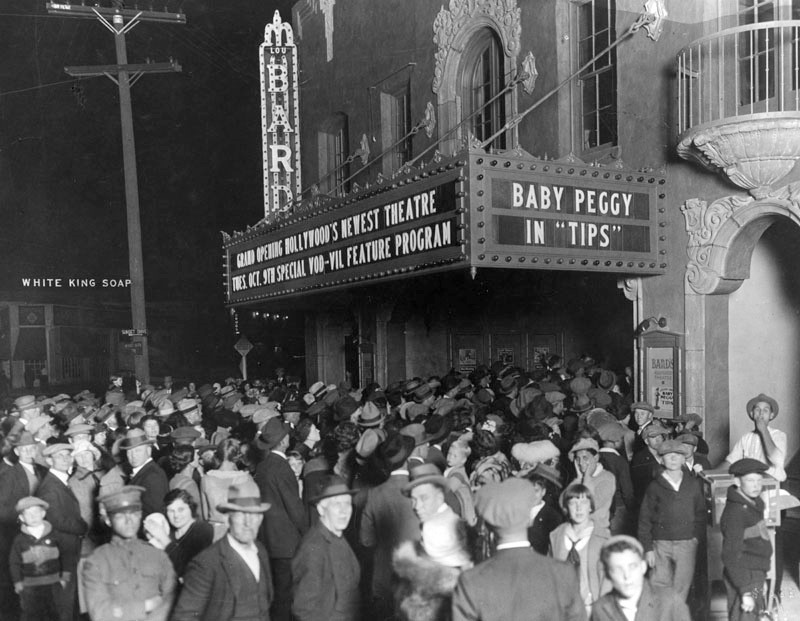 |
|
| (1923)* – View showing the opening of Bard’s Hollywood Theatre (later Vista Theatre), located at 4473 Sunset Drive in East Hollywood. Featuring Baby Peggy in "Tips". |
Historical Notes After the famous impresario Sid Grauman opened the Grauman's Egyptian Theatre in 1922, there appeared several movie palaces done in the Egyptian Revival Style in Los Angeles, Bard's Hollywood being one of the first; this wave of interest in Egyptian antiquities corresponded with the discovery of the tomb of King Tutankhamen in November 1922 by Howard Carter and the Earl of Carnarvon in the Valley of the Tombs near Luxor; their expedition electrified the world having recovered over 5000 relics, many composed of gold and alabaster; the theatre's exterior, done in the Spanish Colonial Revival Style, clashed notably with its Egyptian interior.**^*^ |
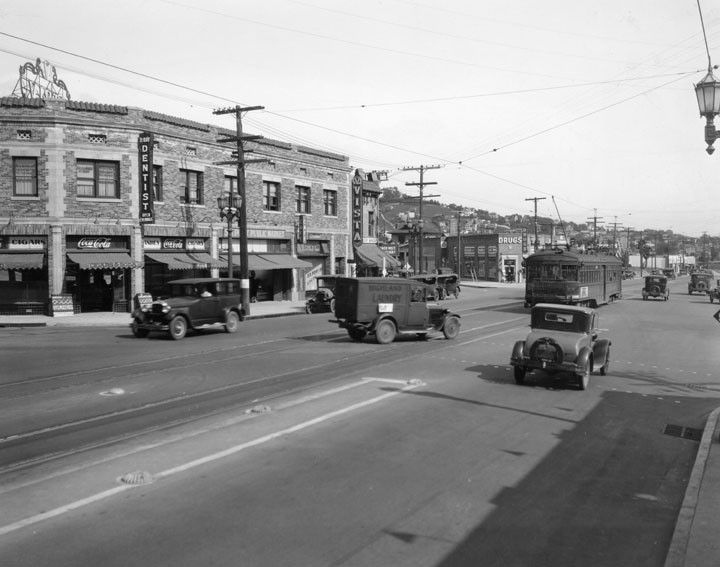 |
|
| (1930)* – View looking east showing the junction of Hollywood and Sunset. The marquee of the Vista Theatre (previously the Bard) is visible at top center. |
Historical Notes By the late 1920s, Bard's Hollywood Theatre became known as the "Vista." |
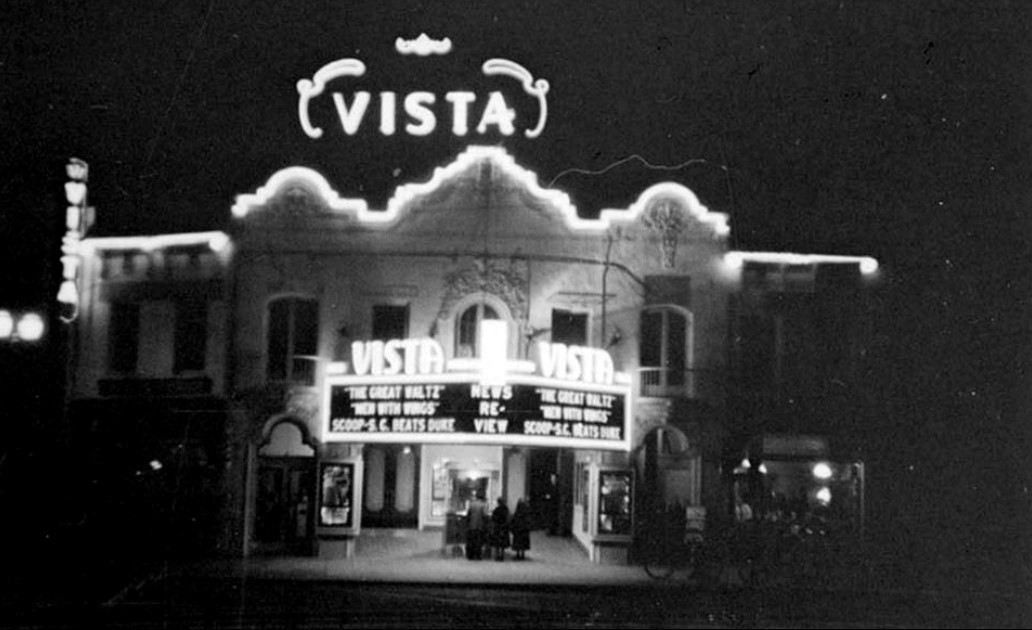 |
|
| (ca. 1938)* - Nighttime view of the Vista Theatre (previously Bard's Hollywood Theatre) with its new neon marquee, erected in 1938 for $1,000. |
Historical Notes The Vista also features a variety of hand and foot prints in cement that commemorate some of the cast and crew members of films screened at the theatre. |
* * * * * |
Garden Court Apartments
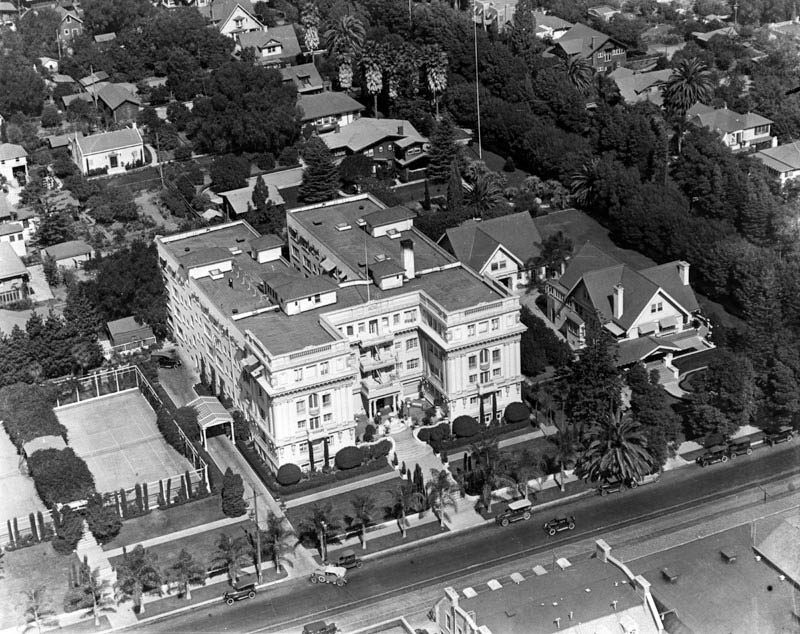 |
|
| (1924)* - Aerial view of the Garden Court Apartments located at 7021 Hollywood Blvd. |
Historical Notes Built in 1917, the Garden Court Apartments were designed by architect Frank S. Meline in Beaux Arts style. They were built to accommodate the movie industry. Among its residents were Louis B. Mayer, Mae Murray, and John Gilbert.* |
Bernheimer Estate and Gardens (currently Yamashiro Restaurant)
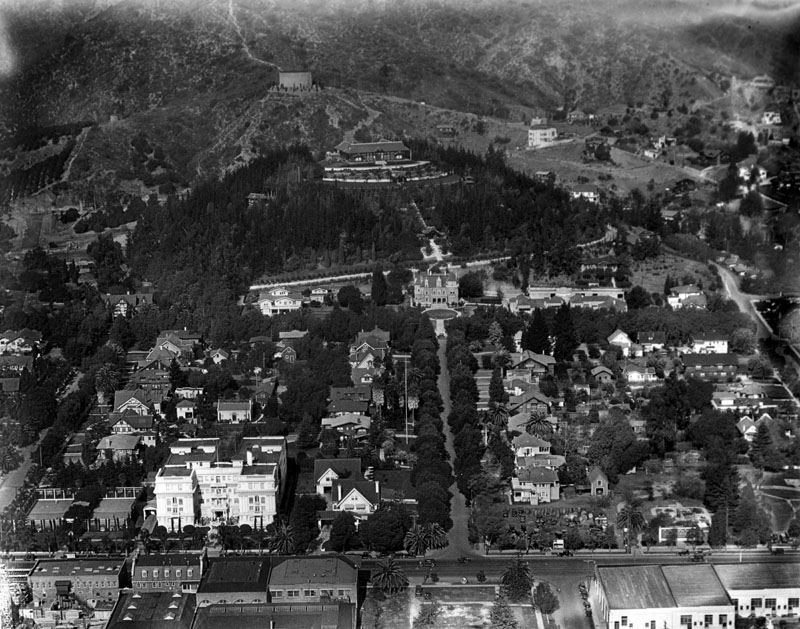 |
|
| (ca. 1924)* - Aerial view looking north on Orange Drive toward Franklin Avenue. On top of the hill (top-center) sits the Japanese estate and gardens of Charles and Adolph Bernheimer. |
Historical Notes This 1914 hilltop estate was built to house the Bernheimers' priceless collection of Asian treasures. In order to have an authentic Japanese design, hundreds of skilled craftsmen were brought from Asia to recreate an exact replica of a palace located in the Yamashiro mountains near Kyoto, Japan. The original Bernheimer structure included a 10-room teak and cedar mansion, where carved rafters were lacquered in gold and tipped with bronze dragons.* Also seen in photo are two other famous early Hollywood buildings. The Lane Mansion (now Magic Castle) is directly below the Bermheimer Estate at the T-intersection of Orange and Franklin. Also, the white building at lower-left is the Garden Court Apartments. |
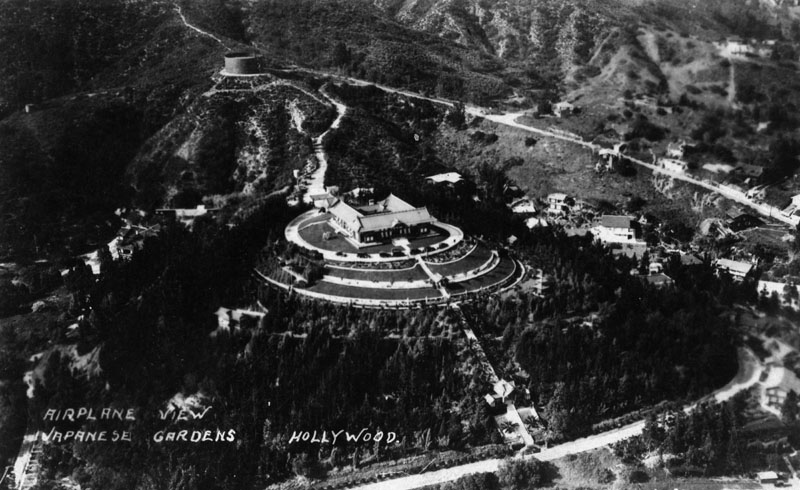 |
|
| (ca. 1924)* - Aerial postcard view of the Japanese estate and gardens of brothers Charles and Adolph Bernheimer located in the Hollywood Hills. |
Historical Notes In an act of bad timing, Adolph Bernheimer, a multi-millionaire silk importer, and his brother built a replica of a Japanese palace and garden on a hill overlooking Hollywood. Not only was the Bernheimer’s Teutonic name very suspicious, but so was their fluency in foreign languages. The new home’s large concrete retaining walls led some locals to suspect an armory or wireless station in the bowels. Under constant observation from a group of patriotic citizens, the brothers pacified neighbors by buying a $5,000 war bond. They spent little time in Hollywood after that.*** |
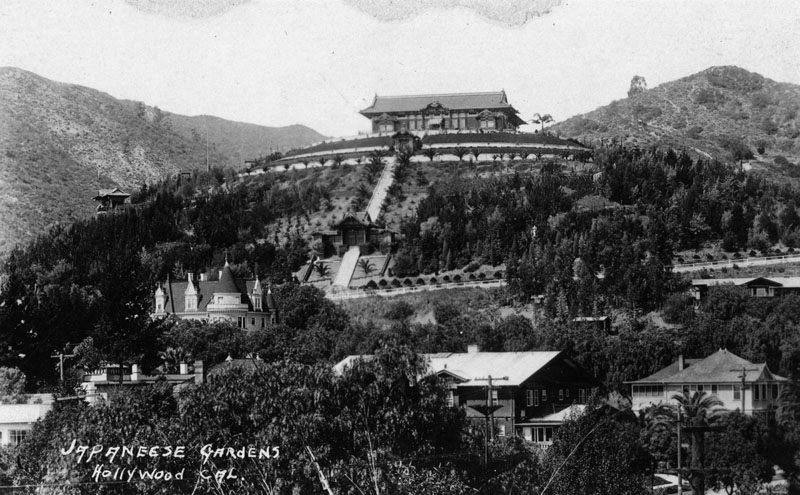 |
|
| (ca. 1920s)* - Postcard view of the hilltop Japanese estate and gardens of brothers Charles and Adolph Bernheimer. |
Historical Notes After the death of one of the brothers in 1922, the art collections were auctioned off. A few years later, the estate served as headquarters for the exclusive Hollywood "400 Club," an organization for the elite of the motion picture industry.* |
 |
|
| (ca. 1925)* - Closer aerial view of the Japanese estate and gardens showing the hillside terraces. |
Historical Notes The hillside terraces included 30,000 varieties of trees, shrubs, waterfalls, hundreds of goldfish, and even exotic birds and monkeys.* |
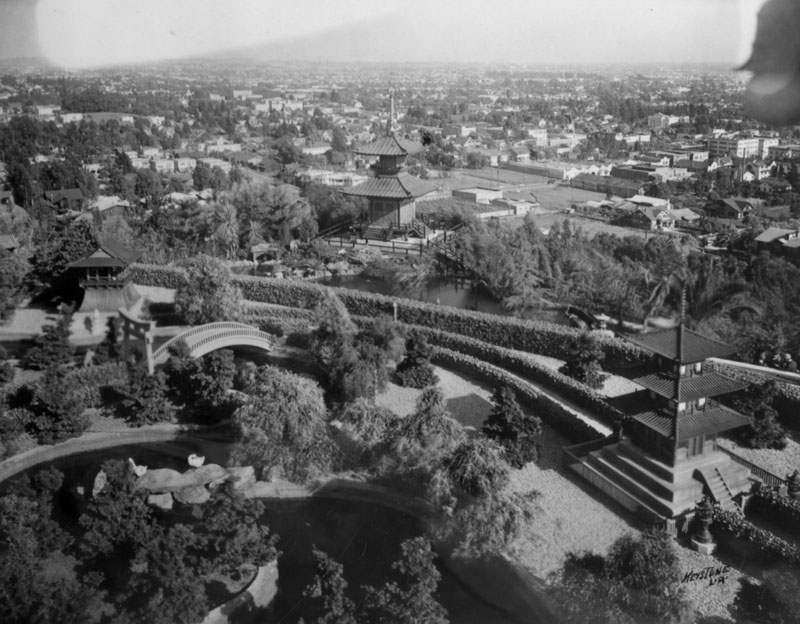 |
|
| (1920s)* - View of the miniature Japanese village on the grounds of the estate of brothers Charles and Adolph Bernheimer, located at 1999 N. Sycamore Avenue in Hollywood. |
Historical Notes Surrounding the village are canals, in which small bronze houseboats float. Below the miniature village are a small lake and a 600 year old pagoda from Japan.* |
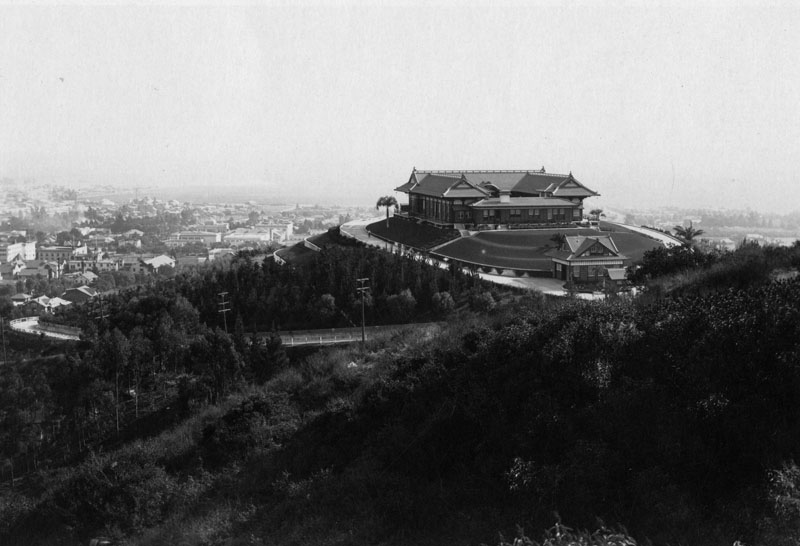 |
|
| (ca. 1920s)* - Hillside view from the northwest looking down upon the Japanese estate, gardens and carriage house (smaller structure closer to the hillside). |
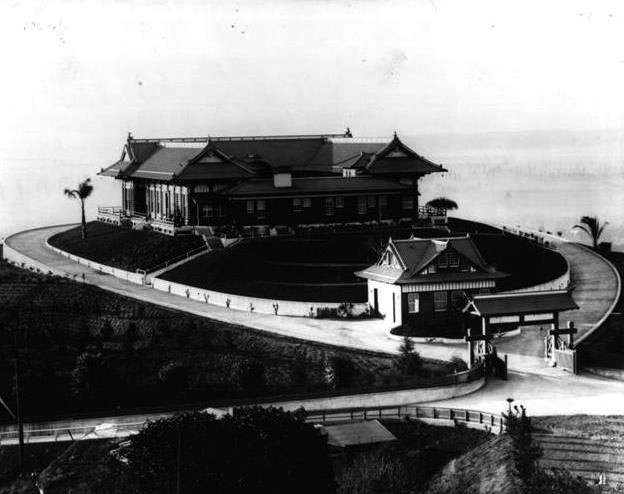 |
|
| (1914)* - Close-up view of the Bernheimer Brother's Japanese Palace the year it was built. Photo: Vintage Los Angeles. |
 |
|
| (ca. 1937)* - Bernheimer residence in background with part of the garden and statue of Ten-Jin on his ox in foreground. |
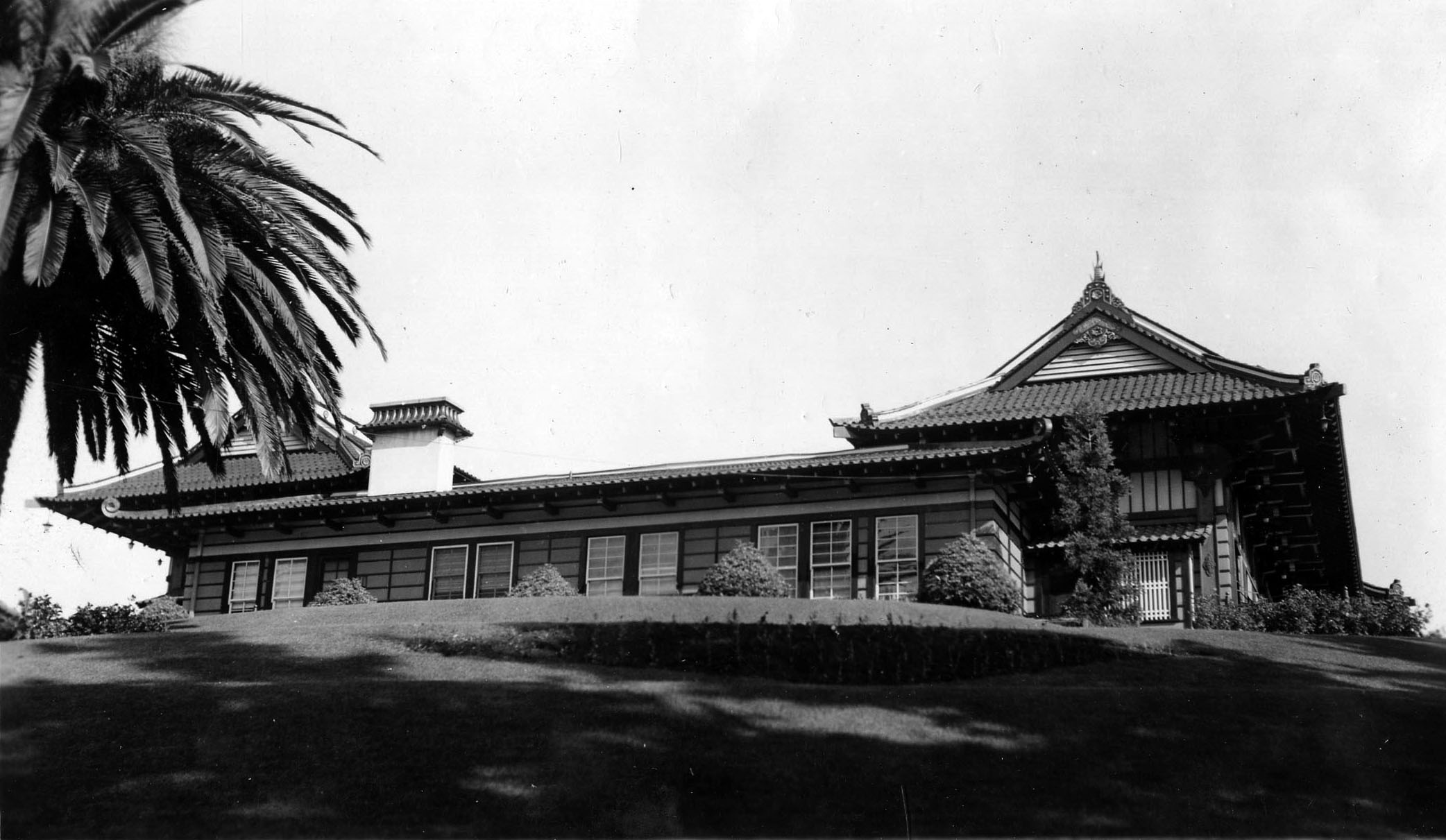 |
|
| (1934)#*^ – Looking up showing a side view of the Bernheimer Mansion as it appeared in the 1930s. |
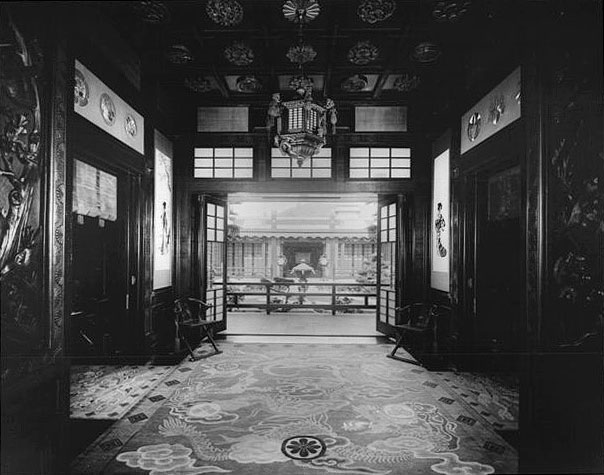 |
|
| (ca. 1930s)^v^ - Interior view of the Bernheimer Mansion showing the teak and cedar carved rafters and antique tapestries covering the walls. |
Historical Notes The Bernheimer Mansion was accessed by 300 steps that led up the hillside through landscaped Japanese gardens. Inside the 10-room teak and cedar mansion, carved rafters were lacquered in gold and tipped with bronze dragons. The walls were covered with lustrous silks and antique tapestries. |
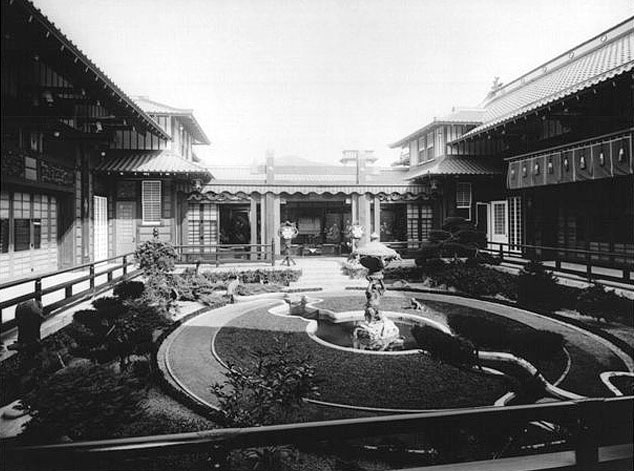 |
|
| (ca. 1930s)^v^ – View showing the inner courtyard, with a garden in the center filled with sculpted plants, stone-hewn pools, and rare fish. |
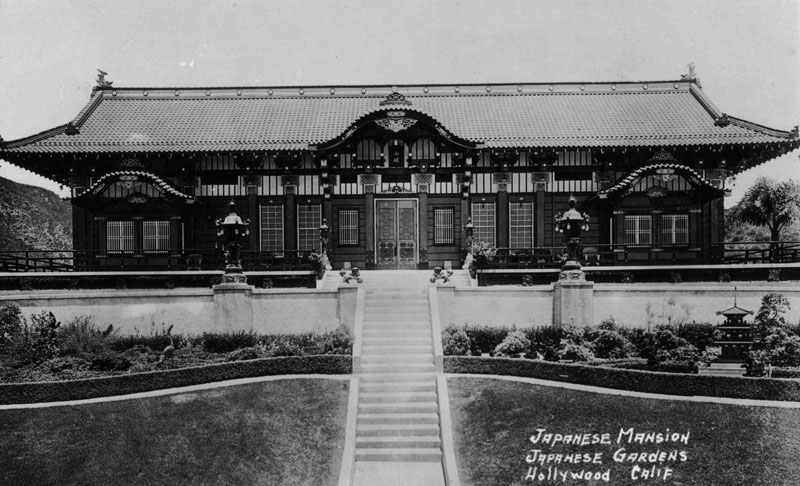 |
|
| (ca. 1920s)* - Postcard front view of the Japanese estate and gardens of brothers Charles and Adolph Bernheimer. |
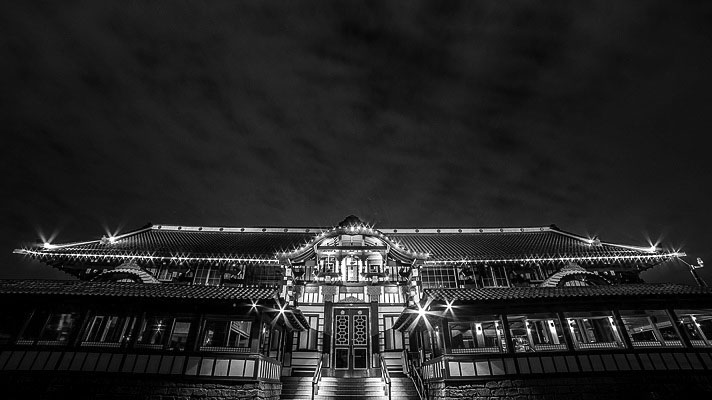 |
|
| (2017)^v^ - Night view Bernheimer Mansion, now the Yamashiro Restaurant, as it appears today. Photo courtesy of Yamashiro |
Historical Notes After WWII, the Bernheimer home was remodeled and converted into apartments. Soon thereafter, Thomas O. Glover purchased the property and began the restoration of what was to become the Yamashiro Restaurant.* |
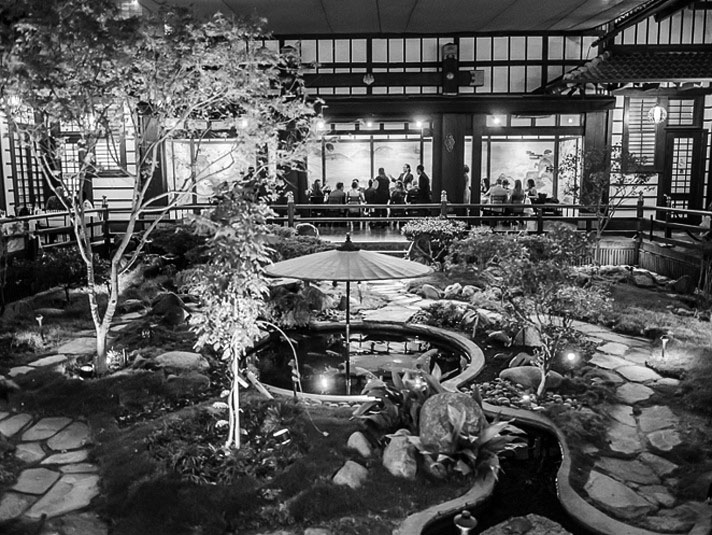 |
|
| (2017)^v^ - Yamashiro's courtyard as it appears today with dining area seen in the background. Photo courtesy of Yamashiro |
Historical Notes In 2012, the Yamashiro Historic District was added to the National Register of Historic Places. According to the National Park Service, the Yamashiro Historic District includes "nine contributing buildings, sites, and structures on the estate property." |
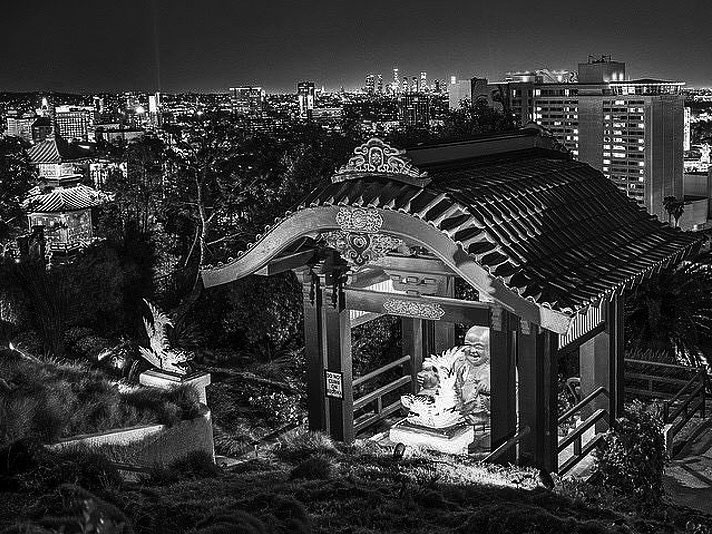 |
|
| (2017)^v^ - View showing the Summer House with seated Buddha, used as a resting place when climbing the stairs up to the original mansion. Photo courtesy of Yamashiro |
Historical Notes The ceremonial Summer House was placed just below the top of the hill as a resting place for guests who were climbing the stairs. The antique Buddha seated there became so popular with guests, a sign hangs from a post to warn visitors, "Do Not Climb On Buddha." The Yamashiro Buddha now faces west as a sign of good luck and prosperity. |
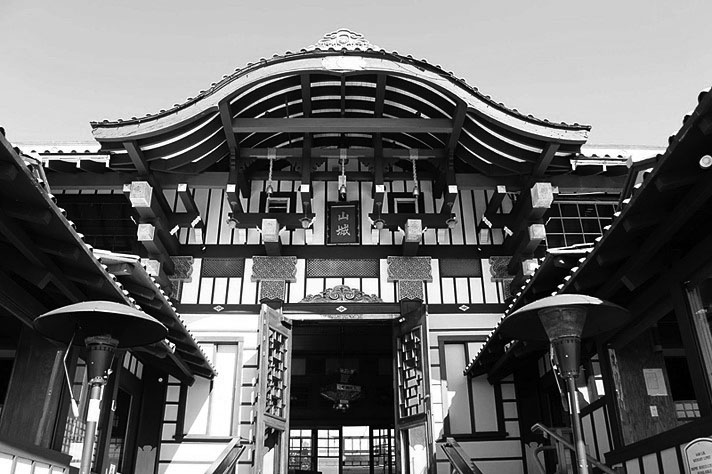 |
|
| (2017)^v^ - Detailed view showing the Pagoda-style architecture. Photo courtesy of Yamashiro |
Historical Notes In 2016, the property that contains Yamashiro was sold to JE Group, a Beijing-based hotel operator. The restaurant is operated by the BNG Group and Sugar Factory. |
* * * * * |
Hollywood and Highland
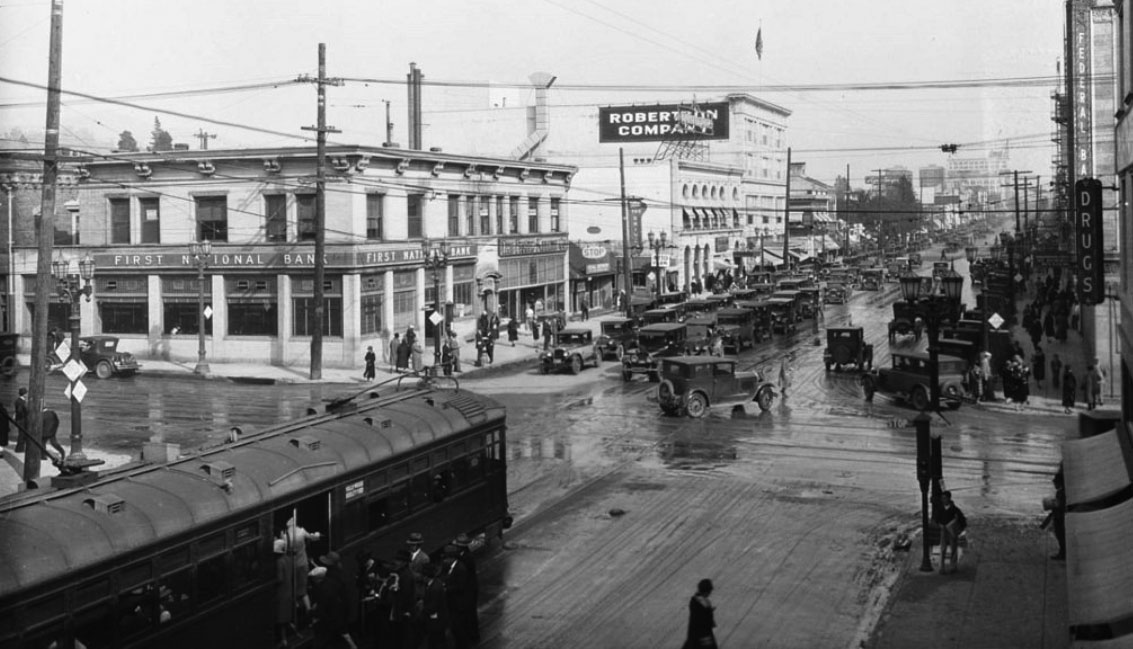 |
|
| (ca. 1924)^^ - View looking east showing the flooded dirt intersection of Hollywood Boulevard and Highland Avenue. The First National Bank Building stands on the northeast corner (future location of the iconic 13-story Hollywood First National Bank Building which still stands today). The Hollywood Hotel is just out-of-frame to the left. The two story building with the arched windows just beyond the intersection is still there, 6757-6763 Hollywood Boulevard. |
 |
|
| (1924)^^ - View showing First National Bank and The Frank Meline Co. on the northeast corner of Hollywood Boulevard and Highland Avenue. A Hollywood Storage Co. truck is seen backed-up against the curb in front of the building. A man is standing in front of the bank entrance while a woman appears to be crossing the street. |
Historical Notes This would be the site of the iconic 13-story Hollywood First National Bank Building, built in 1927. |
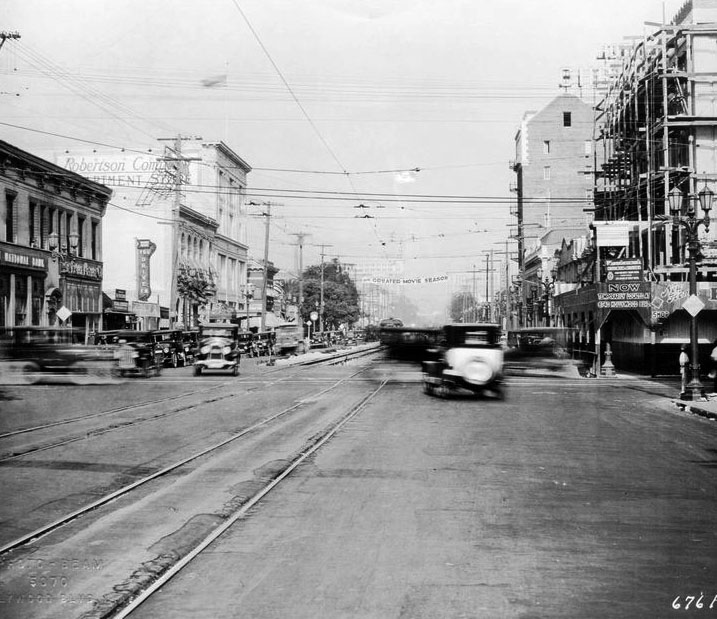 |
|
| (1924)#^* – View looking east on Hollywood Boulevard at Highland Avenue showing a busy intersection. The Hollywood branch of the First National Bank stands on the northeast corner (left). This would be the future home of the thirteen story Art Deco First National Bank Building (built in 1927). The 8-story Hotel Christie (built in 1922) can be seen in the distance on the right. On the right can also be seen the construction of the Bank of America Building, located on the southeast corner of Hollywood and Highland. |
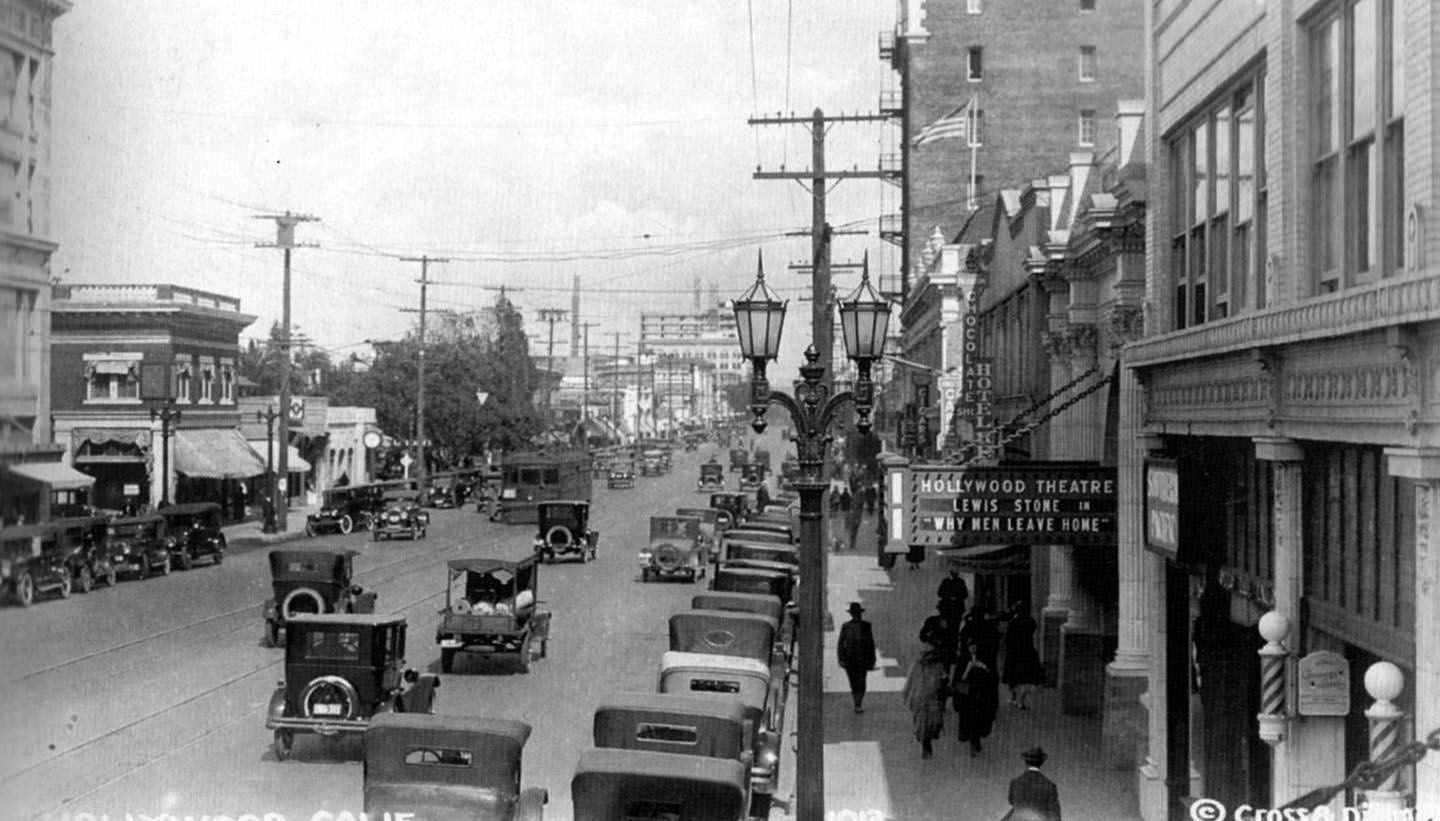 |
|
| (1924)^.^ - Hollywood Boulevard looking east from near Highland. A movie called “Why Men Leave Home” is playing at the Hollywood Theatre at 6764 Hollywood Blvd. It was a Louis B. Mayer Productions movie that came out in March 1924 (and starred Lewis Stone who would later play Mickey Rooney’s father in MGM’s Andy Hardy series.) The theater is still around...sort of. In the 1990s it became the venue for the Guinness Book of World Records. |
Historical Notes In 1936 the Hollywood Theatre got a renovation and redesign by S. Charles Lee where the original white brick façade was replaced with a deco version (Click HERE to see more). Note the beautiful two-lamp ornate streetlight in front of the theater. These were, and still are, called ‘Metropolitan’ streetlights. They were developed especially for Hollywood, but ultimately found their way onto the "best" streets of surrounding communities. The ‘Metropolitan’ is still quite common in Hollywood almost a century after they first appeared (Click HERE to see more). |
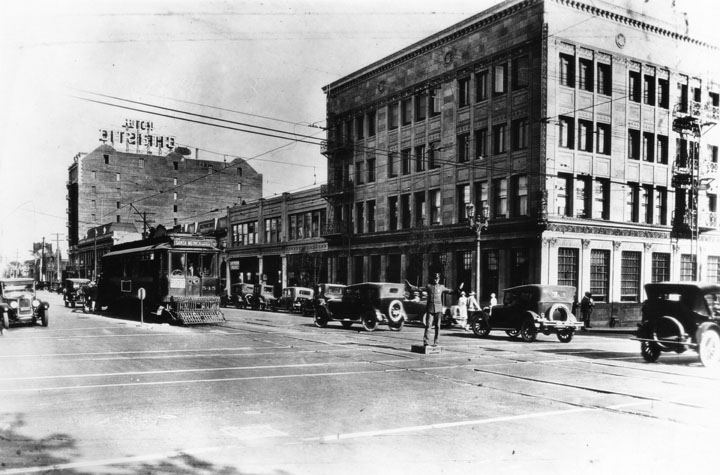 |
|
| (1920s)* - A policeman stands on a low box in the middle of the intersection at Hollywood and Highland, directing traffic, including a streetcar with a sign on the front for Santa Monica. View is looking east on Hollywood Boulevard. In the background can be seen the back of the Hotel Christie. On the right (SE corner of Hollywood and Highland) is the Bank of America Building. |
Bank of America Building
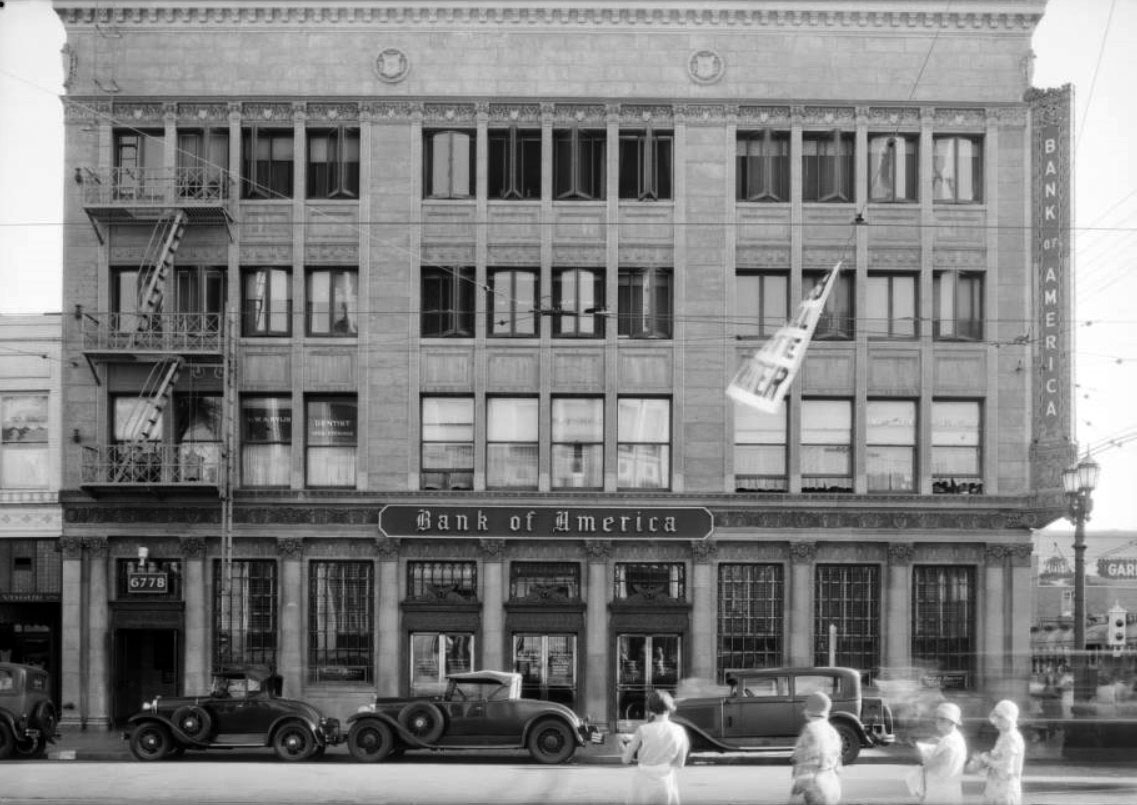 |
|
| (1931)^^ - View looking south across Hollywood Boulevard showing the Bank of America Building located on the southeast corner of Hollywood and Highland. The first floor of this building still stands today and is occupied by Ripley’s Believe It or Not. |
Historical Notes Originally a four-story apartment building, in 1935 the owner removed the top three stories in order to rid the building of shabby apartments with struggling tenants. After the remodel, Bank of America became the building’s sole tenant. The exterior of today’s building appears much as it did following the remodel.^ Click HERE for contemporary view. |
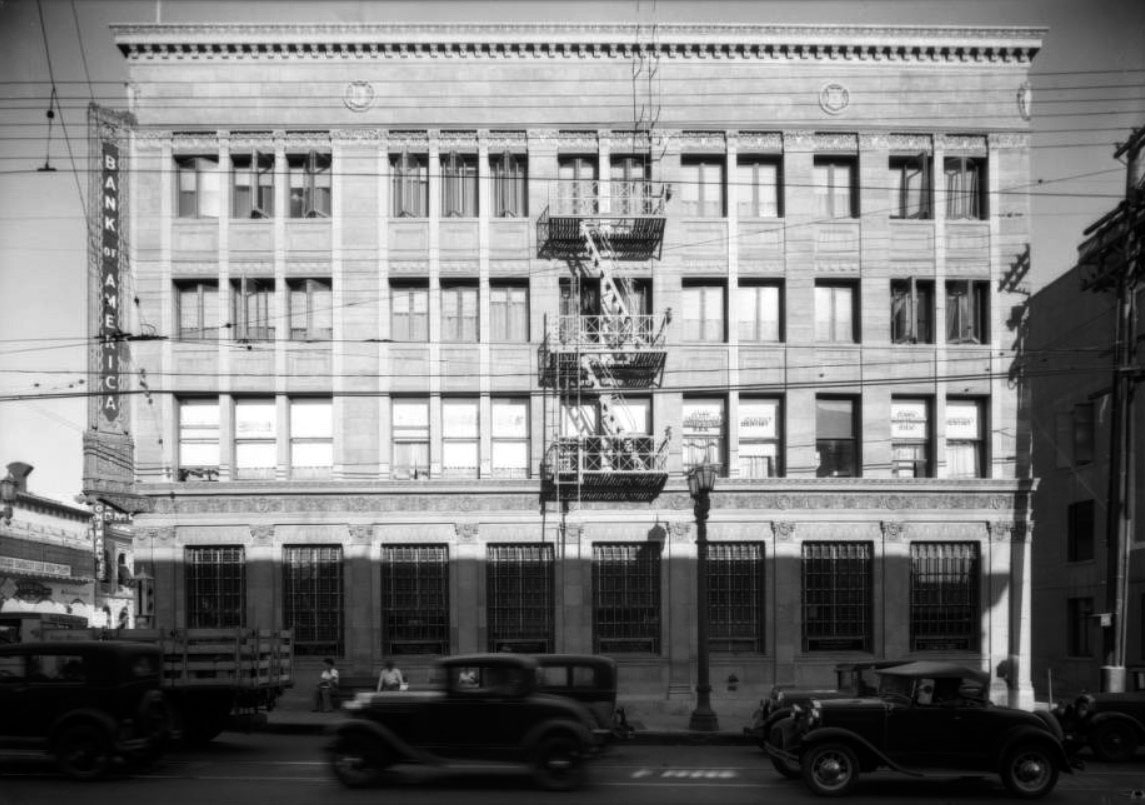 |
|
| (1931)^^ – Looking east across Highland Avenue showing the Bank of America Building, 6780 Hollywood Blvd, on the southeast corner of Hollywood and Highland. The top three floors were later removed and today the building is occupied by Ripley’s Believe It or Not. The Max Factor Building (out of view) is the next building to the south on the right. Click HERE for contemporary view. |
Hollywood Boulevard
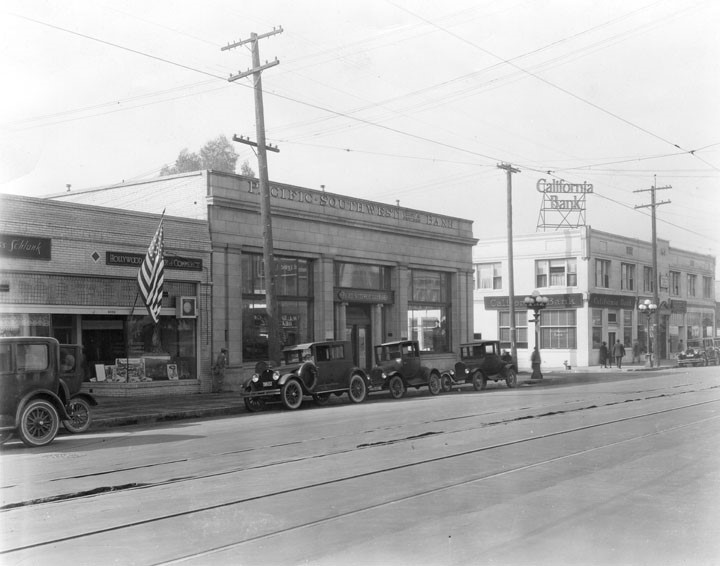 |
|
| (1920s)* - From across Hollywood Blvd. two banks are seen at the corner of Hollywood and Hudson*. On the left the Pacific-Southwest Bank and across the street the California Bank. Also located on the street to the left of the Pacific-Southwest is the Hollywood Chamber of Commerce with a flag mounted out front. |
Historical Notes *Hudson Avenue was named for Thomas Hudson, a rancher in the 1880s. |
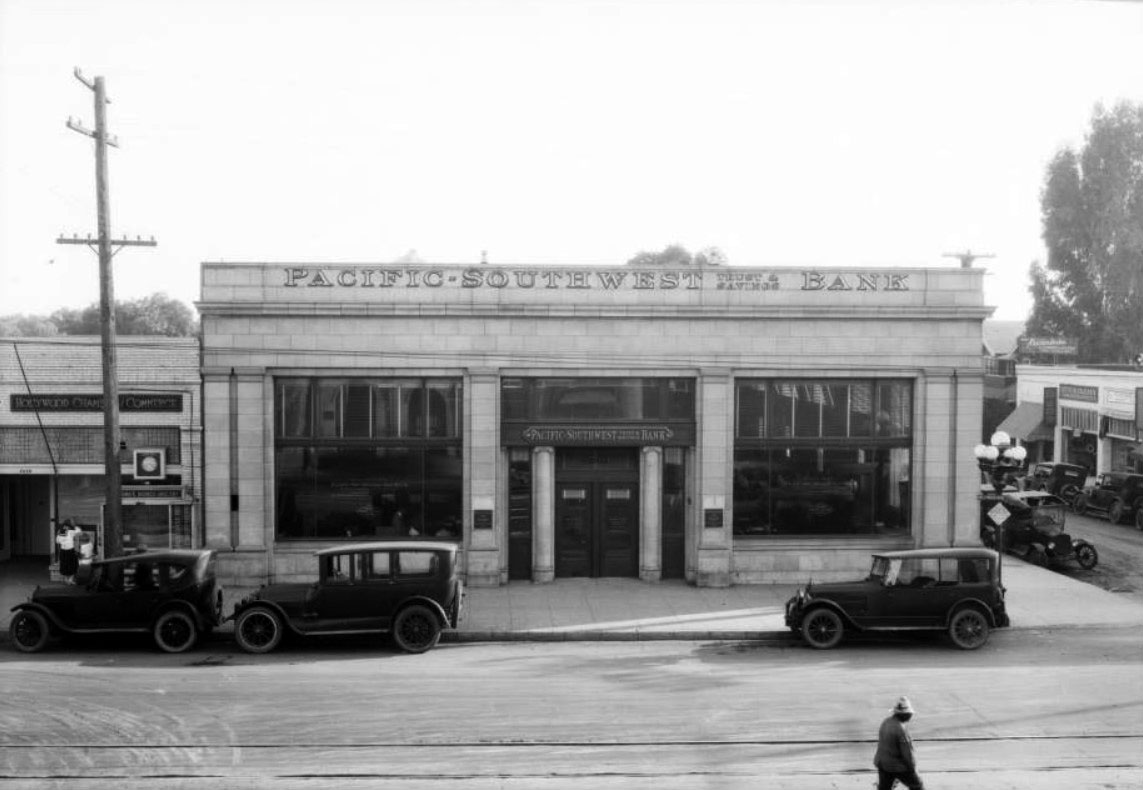 |
|
| (1924)^^ - View showing the Pacific Southwest Bank, located on the corner of Hudson Avenue and Hollywood Boulevard. |
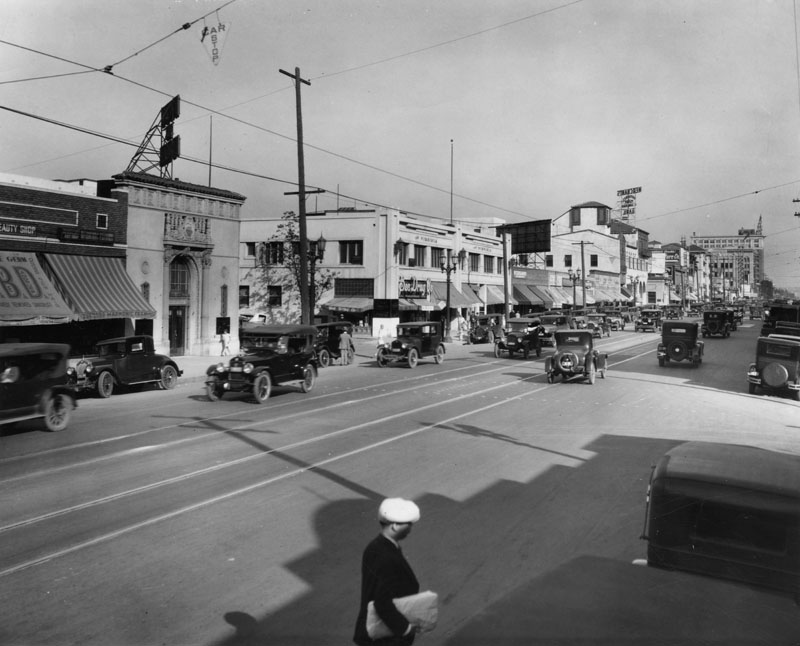 |
|
| (1925)* - View looking east on Hollywood Boulevard from Cherokee Avenue. |
* * * * * |
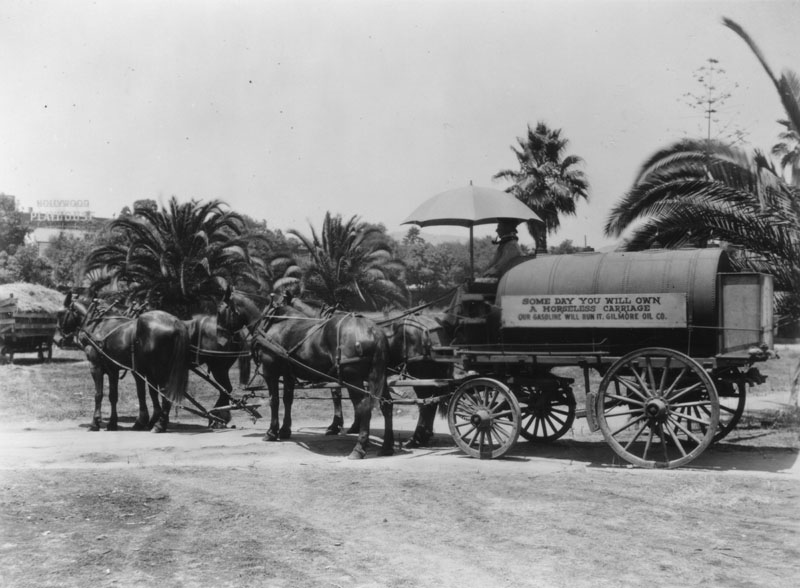 |
|
| (ca. 1925)* - The Gilmore Oil Co. entry in the Hollywood Old Settlers Parade is a horse-drawn wagon bearing an oil drum and bearing a sign, "Some Day You Will Own a Horseless Carriage. Our Gasoline will Run it. Gilmore Oil Co." The driver is shielded from the sun by an umbrella. In the background is a sign for the Hollywood Playhouse. |
Historical Notes Earl Bell Gilmore (1887-1964), whose family had owned the land surrounding the corner of Third and Fairfax in Los Angeles since 1880, was a legendary entrepreneur who with his father (Arthur F. Gilmore) built Gilmore Oil Company, the largest distributor of petroleum products in the Western U.S. He is noted with having invented the self-serve gas station, the "gas-a-teria", where customers saved .05 cents per gallon by filling their own tanks. Gilmore also built Gilmore Field, and Gilmore Stadium, as well as turning the family dairy farm into one of the world's most beloved destinations, the original Farmers Market. In 1944, Gilmore's 1,200 filling stations became Mobil stations.* Click HERE to see Gilmore's Self-Serving Gas Station. |
* * * * * |
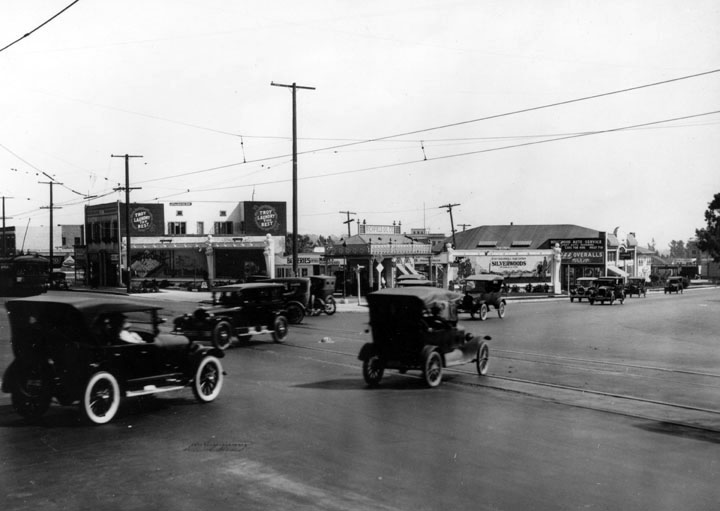 |
|
| (1925)* - Cars cross the street car tracks, a streetcar is seen on the far left. A row of businesses can be seen on the far side: Troy Laundry, Richfield Oil Co., Silverwoods Signboard, Hollywood Auto Service, etc |
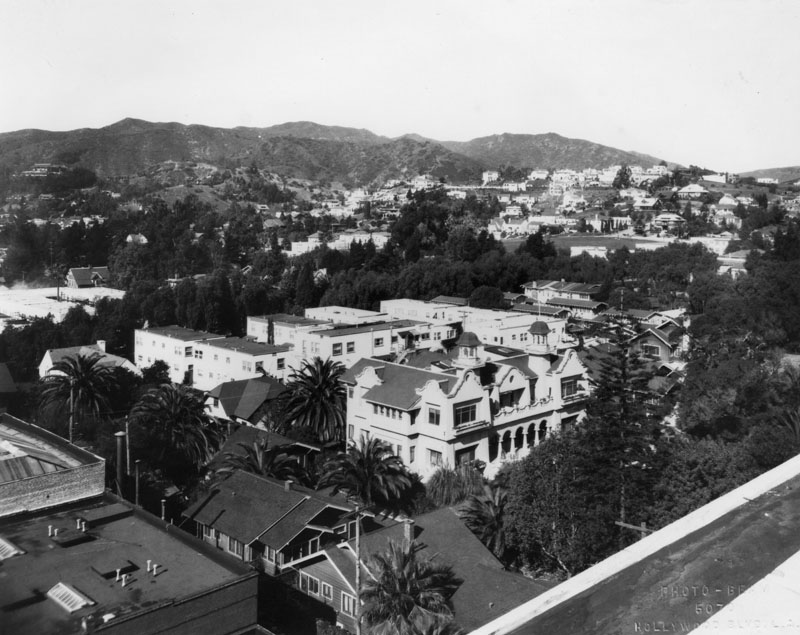 |
|
| (1925)* - View reveals numerous homes throughout Hollywood and the Hollywood Hills. Near the center of the image is the Mission Revival/Islamic style Hollywood residence and art gallery once owned by artist Paul de Longpré (1855-1911). |
Historical Notes The home, located on the west side of Cahuenga Blvd. at Hollywood Blvd., is on property Longpré obtained from Mrs. Wilcox Beveridge after he moved to Los Angeles in 1889. The once open areas and gardens around the residence were gradually filled in with homes and apartment buildings, as indicated by this photo. The residence was a popular tourist destination between the late 1890s and the late 1910s. It was demolished in 1927.* Click HERE to see more of the Paul de Longpre Residence. |
Vine Street
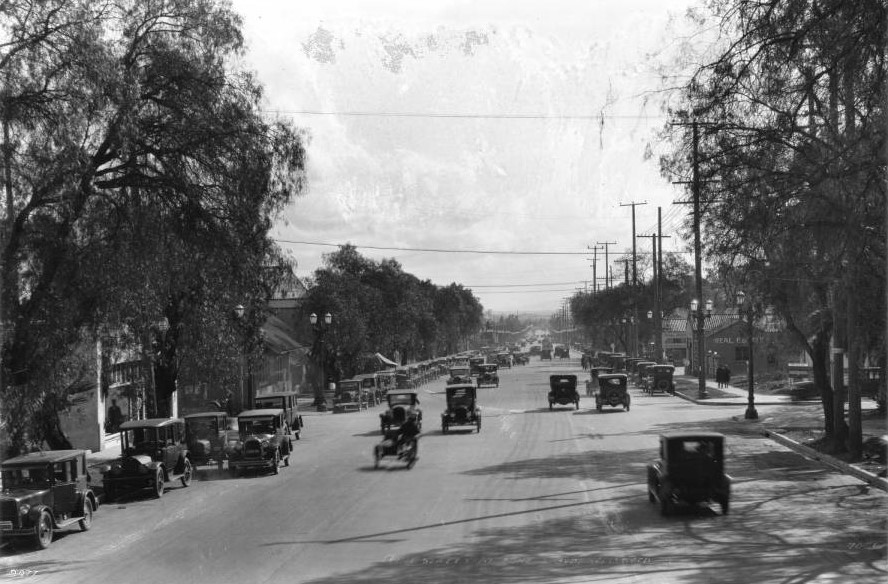 |
|
| (1925)^^ – View looking south on Vine Street toward Selma Avenue, showing the Famous Players Lasky Studio. Four lanes of automobiles make their way up and down the unlined street, while still others are visible parked along the sidewalks to the left and the right. Draping trees hang into the frame in the left and right foreground, obscuring the buildings behind them: to the left, a white two-story commercial building can be seen, while deeper into the frame, the overhung windows of the Famous Players Lasky Studio can be seen on the corner. |
Historical Notes The Famous Players Lasky Studio is most reknowned for its entanglement in antitrust investigations during the twenties, which scrutinized the studio for involvement in a monopoly involving domestic film distribution.^^ |
The Squaw Man (1st feature-length motion picture in Hollywood)
 |
|
| (1913)^*^ - On December 29, 1913, Cecil B. DeMille began Hollywood’s first feature film. The above panoramic photo was taken on the first day of filming. |
Historical Notes The building on the left is the old Lasky Barn (aka "The Old Barn"), once situated in a lemon and orange grove on Vine Street and Selma Avenue. Click HERE to see the above photo with almost every actor identified. DeMille had annotated it for his biographer on 5/21/1957. |
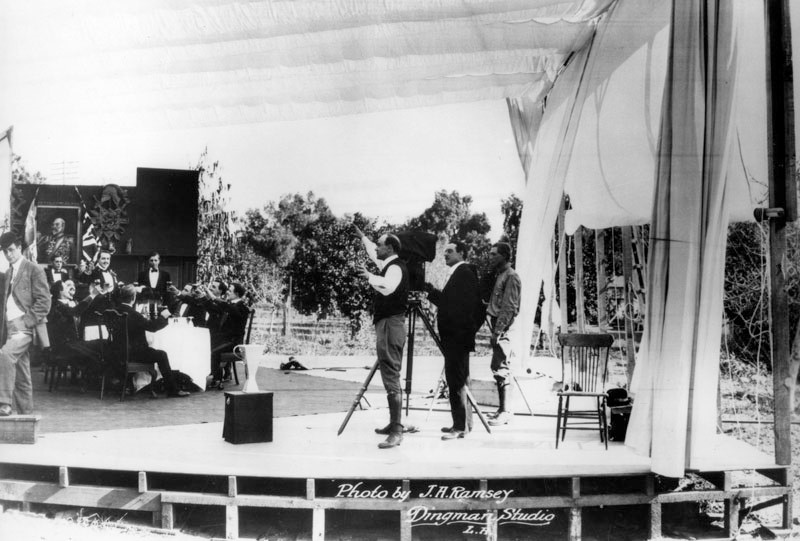 |
|
| (1913)* – View showing the filming of the first scene of "The Squaw Man" at Lasky Feature Play Company, which later combined with the Famous Players Co., later the Paramount Famous Lasky Corporation. The man near the camera with his arms up is Oscar Apfel (co-director of The Squaw Man). Apparently hired by DeMille to teach him how to direct since he hadn’t really directed before. The man behind him working the camera is cinematographer Al Gandolfi and behind him is someone that DeMille identified as “a boy named Kramer”. The film’s star, Dustin Farmum is in the shot, standing in the middle at the head of the table (under the flag) while the other actors raise their glasses in a toast to him. |
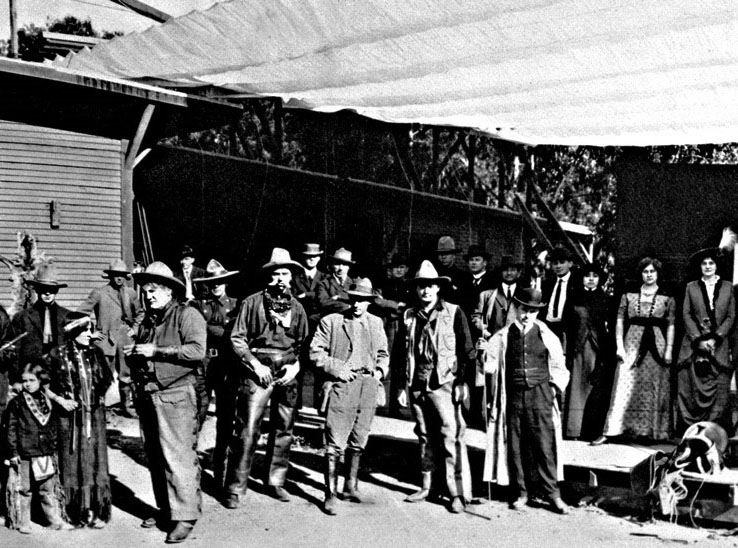 |
|
| (1913)^*^ - Cecil B. DeMille, director of the film, is in the center of the picture, wearing boots and a light suit. The building on the left is the old Lasky Barn (aka The "Old Barn"). |
Historical Notes The "Old Barn" occupied a place of honor on the new studio lot and is now open to the public at its new location on Highland Avenue across the street from the Hollywood Bowl. It has been converted into the Hollywood Heritage Museum.. |
The "Old Barn"
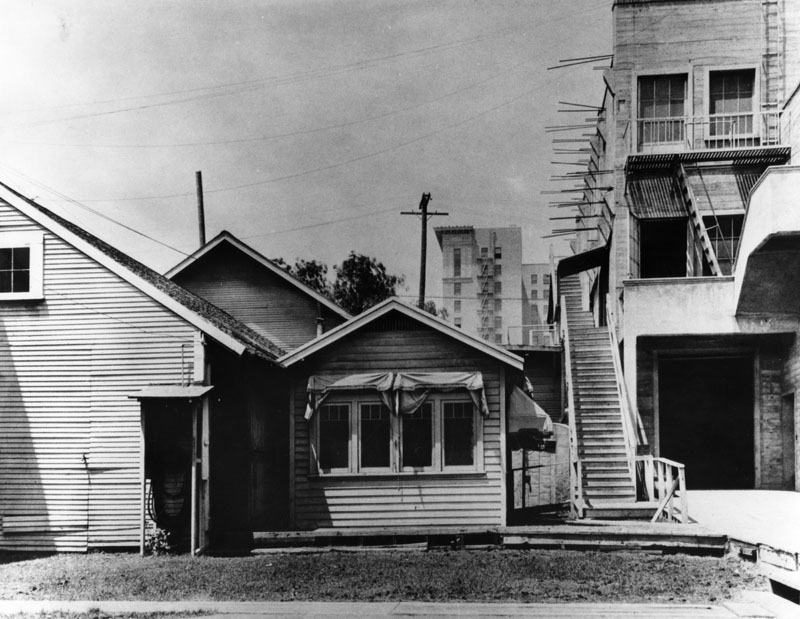 |
|
| (ca. 1920s)* – View looking north showing of the original barn leased in 1913 by Lasky Studio, on the corner of Selma and Vine. The tall building in the background is the Taft Building (built 1923) located on the SE corner of Hollywood and Vine. |
Historical Notes The barn was built in about 1895 on the Hollywood citrus ranch of Robert Northam. It housed horses, carriages, hay, and other farm supplies. It was sold in 1904 to Jacob Stern. The barn was at the southeast corner of Selma and Vine Streets. In March 1913, the Burns and Revier Studio and Laboratory was established in the barn. In December of that year, Cecil B. DeMille, in association with Jesse Lasky, leased the barn and studio facilities for $250.00 a month establishing the Jesse L. Lasky Feature Play Company and began production of The Squaw Man (1914), the first feature film to be produced in the Hollywood area.*^ |
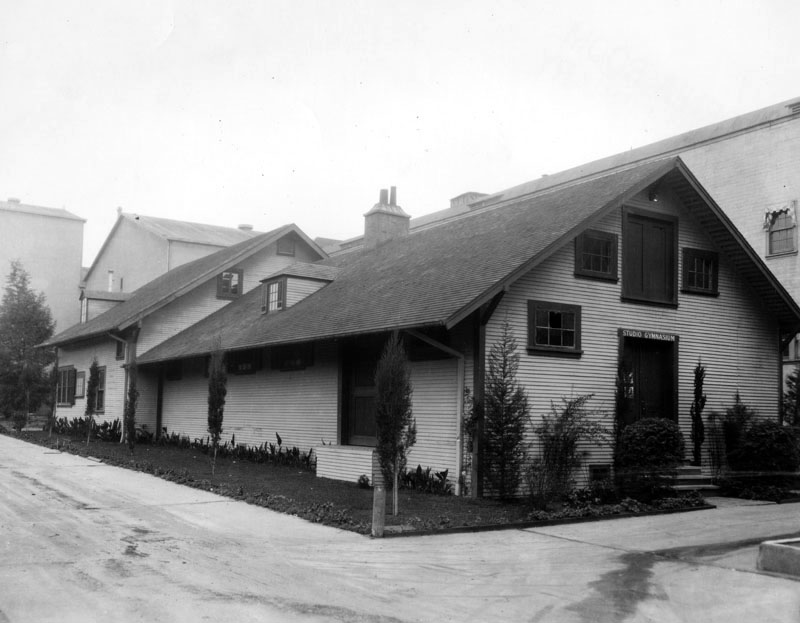 |
|
| (1938)* - View on Paramount Studios lot of "The Old Barn" also known as "Lasky's Barn" where Cecil B. DeMille and Jesse L. Lasky started the first picture studio. |
Historical Notes Cecil B. DeMille rented half of this structure, then used as a barn, as the studio in which was made the first feature-length motion picture in Hollywood-The Squaw Man-in 1913. Associated with Mr. DeMille in making The Squaw Man were Samuel Goldwyn and Jesse Lasky, Sr. Originally located at the corner of Selma and Vine Streets, in 1927 the barn was transferred to Paramount Studios.* |
.jpg) |
|
| (1956)* - View of celebrities standing on the porch of ‘The Old Barn’ during the California Historical Landmark plaque dedication. From left to right are: Samuel Goldwyn; Jesse Lasky; Cecil B. DeMille; Adolph Zukor; Leo Carrillo and Y. Frank Freeman. |
Historical Notes In a ceremony attended by its founders, the Lasky-DeMille Barn was dedicated on December 27, 1956, as "Hollywood's First Major Film Company Studio" and designated California State Historic Landmark No. 554, representing the birth of the Hollywood motion picture industry and becoming the first landmark associated with it.*^ (Click HERE to see more California Historical Landmarks in Los Angeles). |
 |
|
| (ca. 1979)#**# - View showing the Lasky-Demille Barn in a staging area adjacent to the Hollywood Palace Theatre with the Capitol Records Building seen in the background. |
Historical Notes In October 1979, the barn was moved off the Paramount lot to a vacant lot in Hollywood. It was then moved by the Hollywood Chamber of Commerce to the parking lot of The Hollywood Palace theater (aka Hollywood Playhouse), where it was boarded up and fenced in until a permanent site could be found.*^ |
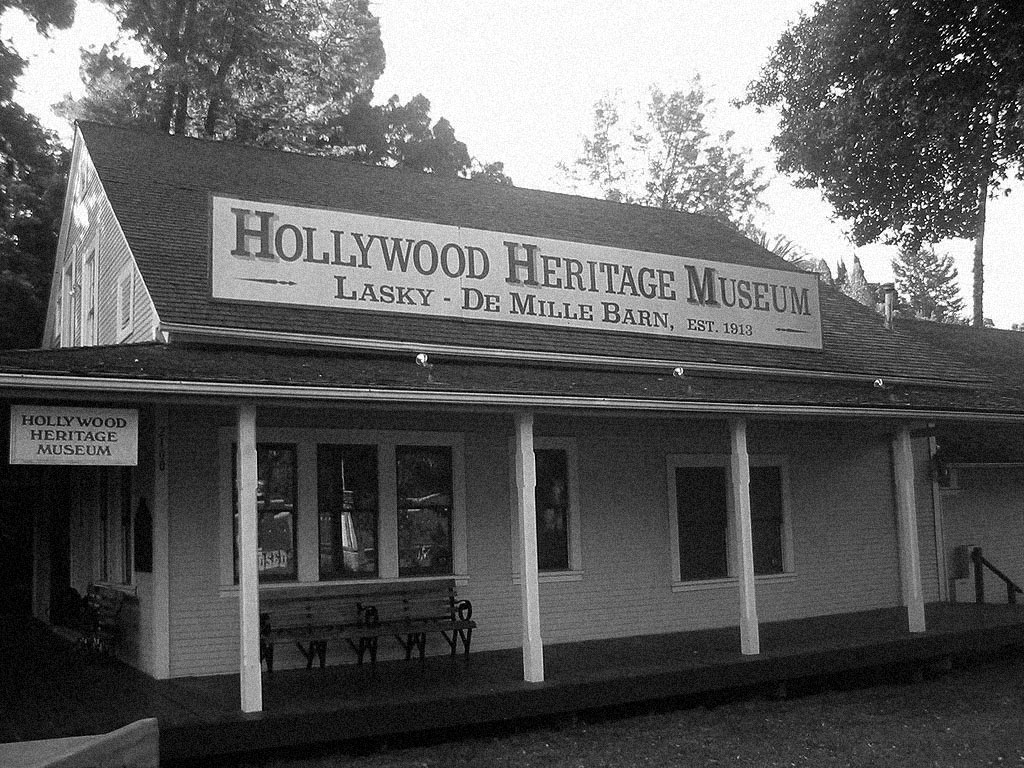 |
|
| (2007)*^ - View of The Lasky-DeMille Barn at its present day location, 2100 North Highland Avenue (Across from the Hollywood Bowl). |
Historical Notes The Lasky-DeMille Barn was acquired by Hollywood Heritage, Inc., in February 1983. It was then moved to its present site at the southern end of the parking lot of the Hollywood Bowl, where it was restored and made into the Hollywood Heritage Museum.*^ |
* * * * * |
Vine Street
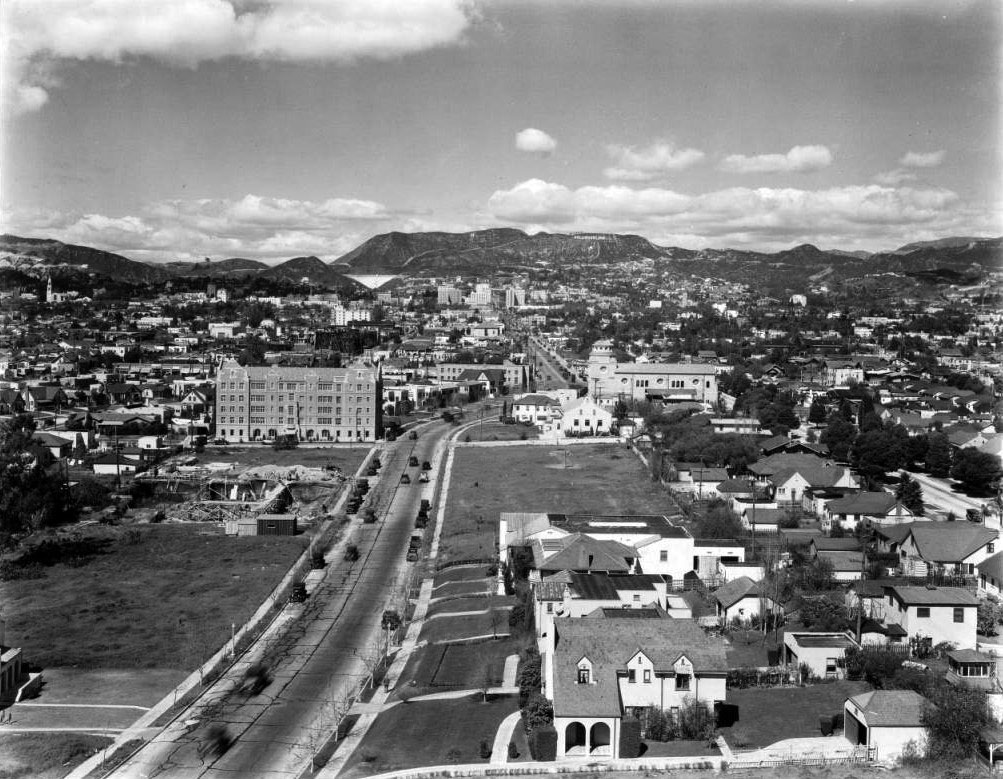 |
| (1925)^^ - View of Hollywood looking north from Rossmore and Rosewood avenues showing Vine Street from Rossmore's north turn near Melrose Avenue. In the distance is the “Hollywoodland” sign. At top center-left can be seen the Mulholland Dam shortly after it was completed (Dec. 1924). The empty lot at center of photo is where the Ravenswood Apartments would built in 1930. |
Historical Notes Rossmore turns into Vine Street north of Melrose Ave in Hollywood. Vine Street is so named because it went through the vineyard of 1880s US Senator Cornelius Cole. Rossmore was named after Miracle Mile's developer, A.W. Ross. |
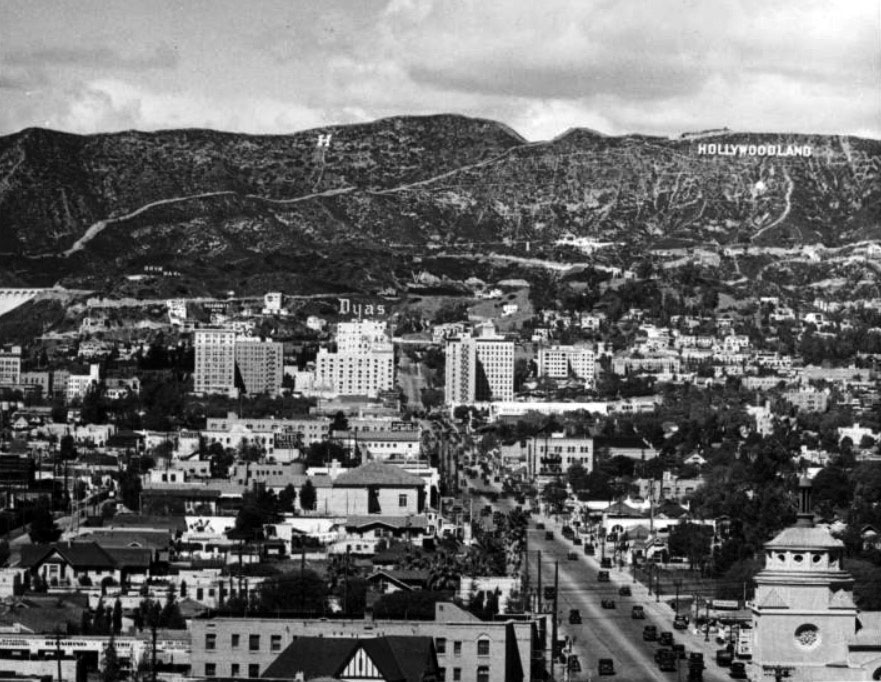 |
|
| (ca. 1925)^^ - Panoramic view of Hollywood looking north on Vine Street from Clinton Street. Residential blocks full of one-story houses fill the foreground, turning into high rise hotel buildings as Vine Street approaches the mountains. A single “H” as well as the “Hollywoodland” sign are visible. A small section of the Mulholland Dam is visible at left. |
Historical Notes The Mulholland Dam, built in 1924, can be seen at left-center. The dam still exists today but can no longer be seen from this view or from just about anywhere in Hollywood. Click HERE to see more in Mulholland Dam and Hollywood Reservoir. |
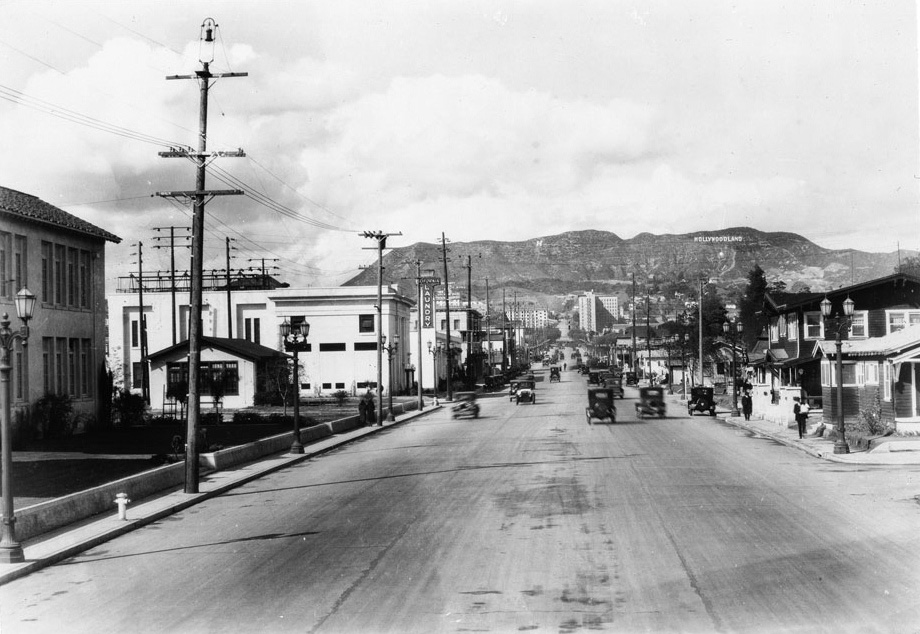 |
|
| (ca. 1925)^^ - View looking north on Vine Street from Barton Avenue* with the Hollywoodland Sign seen in the distance at the top of the Hollywood Hills. On the left is Vine Street Elementary School. Further up on the northwest corner of Vine and Romaine streets stands DWP's Power Distribution Station No. 6. (Click HERE to see more Early Power Distribution Stations). |
Historical Notes *Barton Avenue was named for Barton Jones, grandson of Cornelius Cole. Cornelius Cole owned one of the original Spanish/Mexican landgrants, what is now known as Hollywood, then was dubbed Colegrove after his wife, Olive Colegrove. There are several streets now named after the family; Cole St., Willoughby Ave., Eleanor St. and Seward St.*^ |
Then and Now
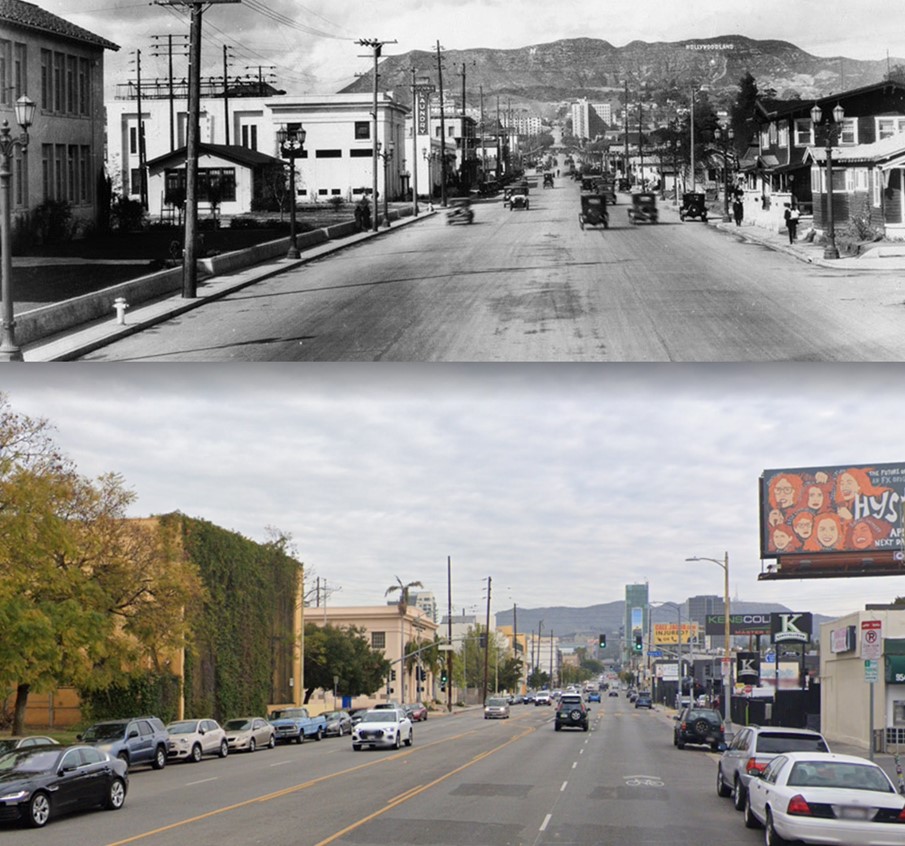 |
|
| (1925 vs. 2021)* - Looking north on Vine Street at Barton Avenue. |
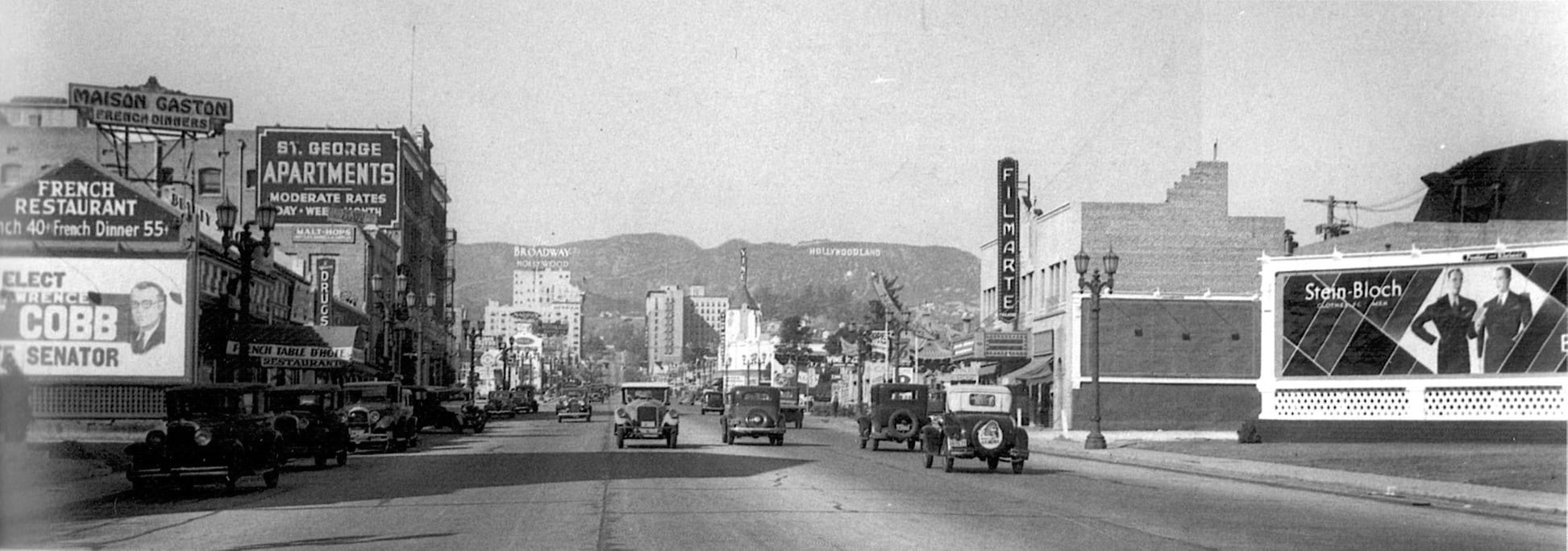 |
|
| (ca. 1931)* – Panoramic view of Vine Street looking north at Lexington Avenue. In the far background we can see the still-intact Hollywoodland sign on the hills. In the foreground, we can see the Maison Gaston French restaurant (at 1219 Vine) and on the right the Filmarte Theatre (1228 Vine) that in 1928 became a theater that showed “serious motion pictures” and in 1957 turned into the home of Art Linkletter's “People Are Funny.” Just to the north of the Filmarte Theatre, at La Mirada Avenue, can be seen a large sign in the form of an arrow pointint down to the old Mandarin Market which became Hollywood Ranch Market in 1932. |
Historical Notes The Filmarte Theatre has a long wonderful Hollywood history. The building opened in 1906 as the La Mirada Theatre. In 1929, as the Filmarte Theatre, it was a movie house showing only non-American films, catering to the "various foreign colonies in east Los Angeles. Russians from Boyle Heights were among its best customers." It is the theater where Bob Hope performed his first stand-up act. The People Are Funny television program starring Art Linkletter was filmed there in the 1950s. From 1962 to 1964 it was known as the Steve Allen Playhouse. Allen, in recreating what he invariably referred to as "The Old Tonight Show"—his 1954-57 stint as the first host of what NBC then referred to as Tonight! Starring Steve Allen—routinely used the street immediately to the north (La Mirada) and the adjacent Hollywood Ranch Market as extensions of the studio, and program, much in the way that David Letterman would later use various businesses around his CBS Late Night studio for comedic routines. When Allen and Westinghouse Broadcasting came to a sudden parting of the ways in 1964, the studio was used by the short-lived successor program, That Regis Philbin Show, Philbin's first national program. During a renovation in 1990 the entire interior of the building burned, and it was later demolished. The site is now occupied by a mental health clinic.^ |
Hollywood Hills
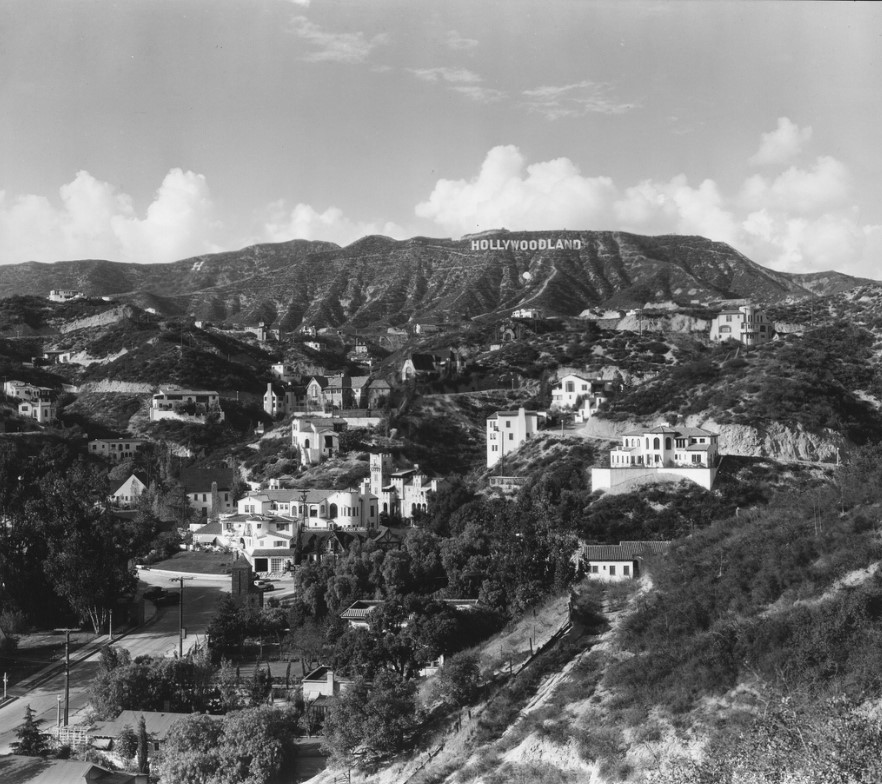 |
|
| (1926)^##* - View of the Hollywood Hills with the Hollywoodland Sign in the background. Note the large white dot directly below the Hollywoodland Sign. |
|
THE WHITE DOT - Contrary to what has been written before, the white dot, located below the Hollywoodland sign was not installed as an “eye catcher.” How that story got started is anyone’s guess. But it’s absurd! Why would an eye catcher be installed when there is a 543 foot long, 45 foot high white sign just above the dot? The real story is a bit more complicated. In 1920-21, the US Chamber of Commerce produced maps illustrating business conditions in areas of the country. Those shaded black were poor, white with black stripes (grey) were fair and white was good. Los Angeles was a “white spot” in a sea of black and grey on the map in the early 1920s. Los Angeles Times publisher, Harry Chandler adopted the catchprase, “White Spot Of America” as being a city free of crime, corruption and communism. Chandler, who was vehemently anti-union, was an influential proponent of developing a strong economic base in Los Angeles. It wasn’t long before the phrase “keep the white spot white” was being commonly used. The term “white spot” typically referred to LA”s relative prosperity and low unemployment, and was not intended to have racial overtones. So, for Los Angeles, the term, “keep the white spot white” meant keep L.A. prosperous. In late 1924, in order to demonstrate support for the “keep the white spot white”, campaign, Hollywoodland erected a 35 foot diameter “white dot” on the hillside, several feet below the Hollywoodland sign. The cost to erect the dot was $936.16. Contrary to popular belief, the white dot was not illuminated.* |
 |
|
| (ca. 1926)* – Homes fill the Hollywood Hills with the "Hollywoodland" Sign and "White Dot" seen in the distance. |
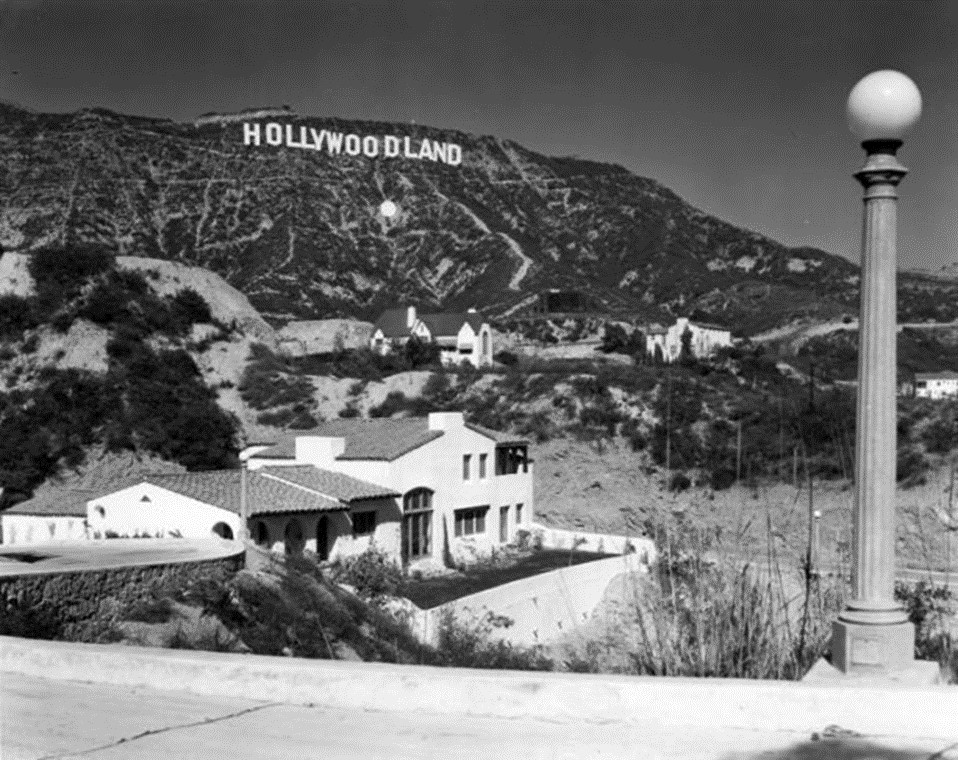 |
|
| (ca. 1926)* - Closer view of the Hollywoodland Sign with homes seen in the foothills. |
Historical Notes At night the Sign blinked into the Hollywood night: first “Holly” then “wood” and finally “land,” punctuated by a giant period. The effect was truly spectacular.^ |
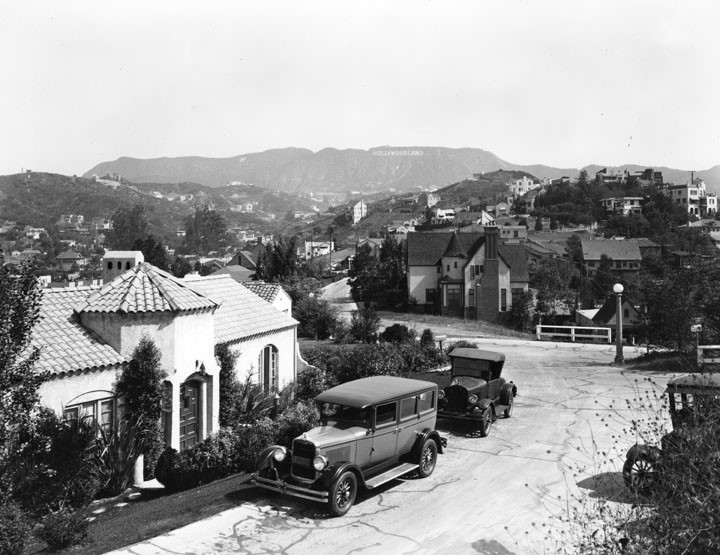 |
|
| (ca. 1926)* – View of various streets and homes in the Hollywood Hills. Three early-model automobiles are parked in the foreground and the "Hollywoodland" Sign is seen in the distance. |
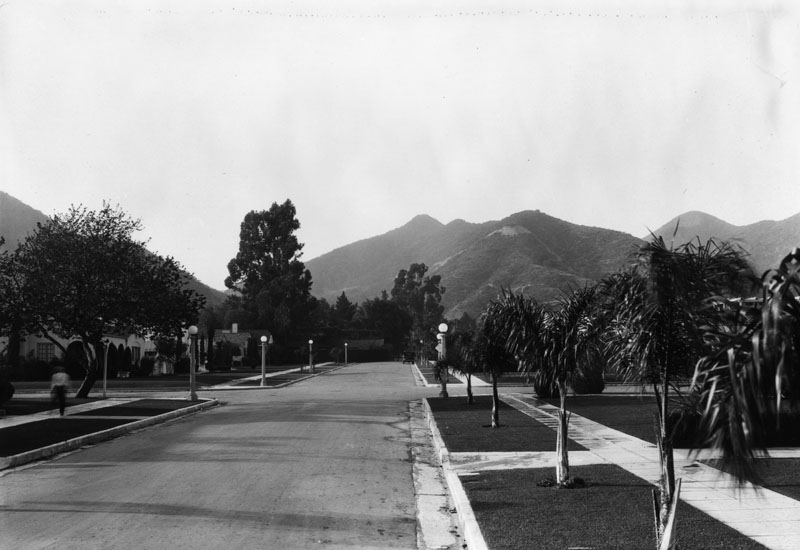 |
|
| (1926)* - Looking north towards the Hollywood Hills in the 1500 block of Genesee Street (now Genesee Avenue) just before the street dead-ends. Note the ornate single-lamp streetlights. Click HERE to see more in Early L.A. Street Lights. |
* * * * * |
First Presbyterian Church of Hollywood
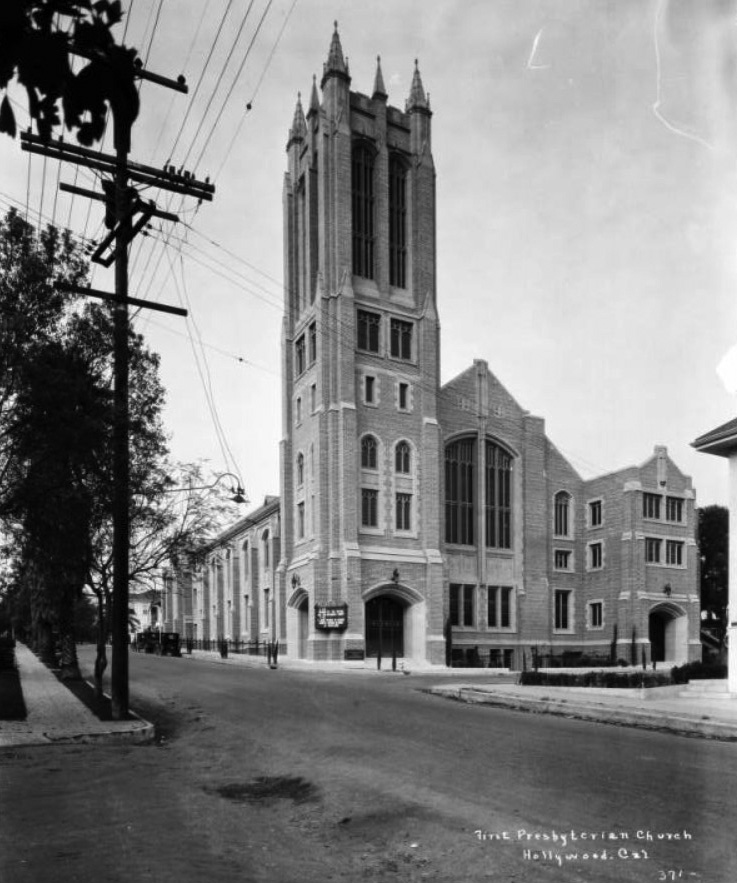 |
|
| (ca. 1926)^^- View looking north on an unpaved Gower Street showing the First Presbyterian Church of Hollywood located on the northeast corner of Gower and Carlos Ave. |
Historical Notes The First Presbyterian Church of Hollywood was found in 1903. A large brick gothic sanctuary was built in 1923. “Hollywood Pres," as it is informally known, grew to be the largest Presbyterian Church in the world during the 1950s. *^ Click HERE to see more on the First Presbyterian Church of Hollywood. |
* * * * * |
Hotel Iris (later Hotel El Dorado and St. Moritz Hotel)
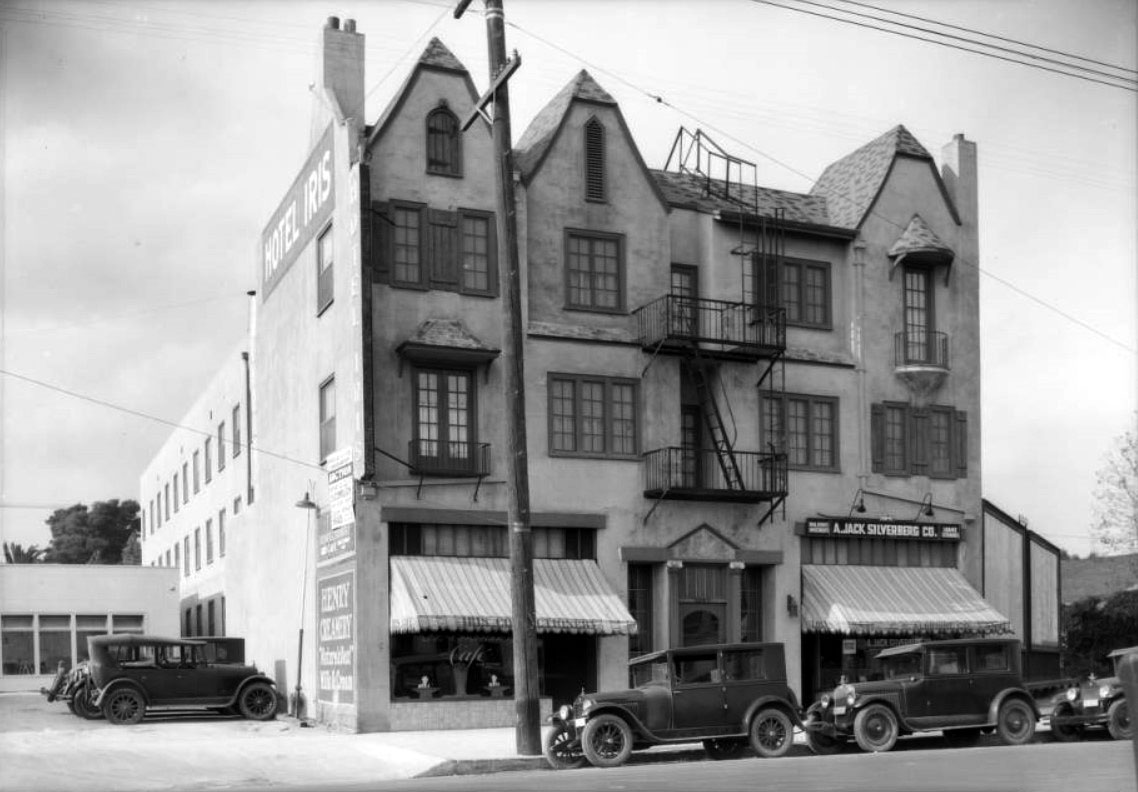 |
|
| (1923)^^ – View showing the Hotel Iris (later the Hotel El Dorado and the St. Moritz Hotel), located on the north side of Sunset Boulevard just east of Bronson Avenue. This is where Judy Garland once stayed. There are several stores on the ground floor with signs reading: C.H. Connor & Son; Henry Creamery; Iris Confectionery and Cafe; A. Jack Silverberg Co.; C.S. Albright Co. |
Historical Notes The Hotel Iris is where Judy Garland (back then her name was still Frances Gumm) and her family stayed on vacation in 1926. Judy’s very first performance in Los Angeles was at the Earlanger’s Mason Theatre on July 10, 1926 during an afternoon kidee’s matinee of Topsy and Eva with the Duncan sisters. It was during this trip that the Gumms decided to move to California, soon after settling in the town of Lancaster, north of Los Angeles.**## |
.jpg) |
|
| (2014)*### - Google street view showing theSt. Mortiz Hotel (Previously Hotel Iris and Hotel Eldorado), located at 5849 West Sunset Boulevard. |
Historical Notes The St. Moritz Hotel is located on Sunset Boulevard, across from the former Warner Bros West Coast Studios, site of the filming of the first talking film. |
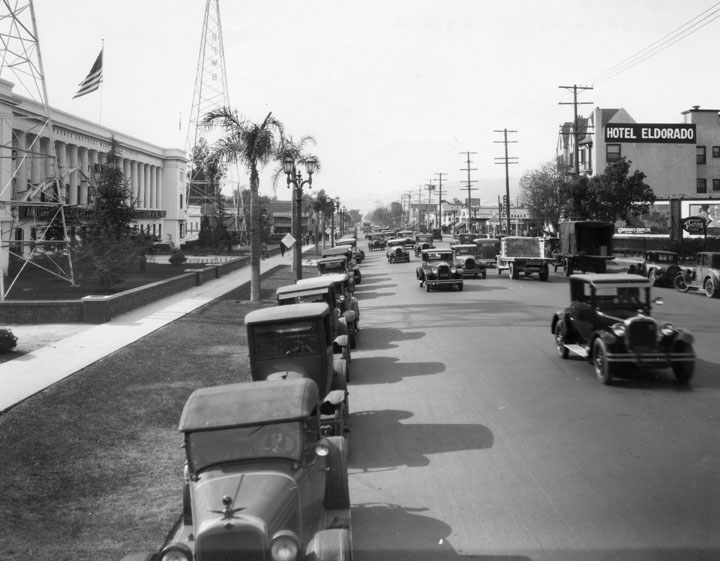 |
|
| (1930)* - Sunset Boulevard looking west from Van Ness. To the left is Warner Brothers West Coast Studios; to the right is the Hotel Eldorado, which was prviously the Hotel Iris . |
Warner Brothers West Coast Studios
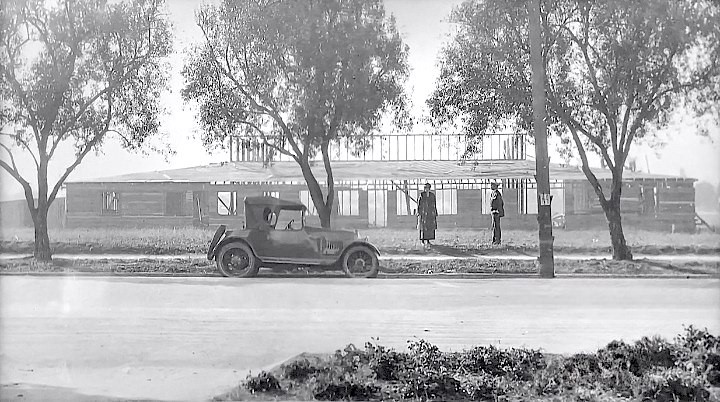 |
|
| (ca. 1919)* - View showing a man and woman standing on a lot at the 5800 Sunset Boulevard. Behind them is a structure under construction which became the birth of Warner Bros. west coast filming studios. The car parked in front happens to be a c1918 Scripps-Booth. |
Historical Notes In 1918, the Brothers Warner (Harry, Albert, Sam and Jack) bought 10.2-acres of land in Hollywood from the Beesmyer family at a cost of $25,000. In 1919 they built a giant stage nicknamed The Barn, which measured 50-feet wide by 100- feet long. This stage was torn down in 1923 and was replaced by a collection of smaller stages and buildings.* |
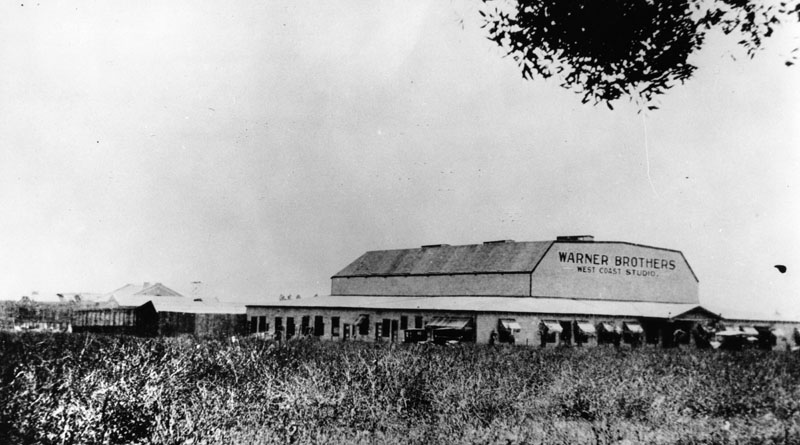 |
|
| (ca. 1918)* - View showing the original "Barn" filming stage at the Warner Brothers West Coast Studio at Sunset and Bronson in Hollywood. |
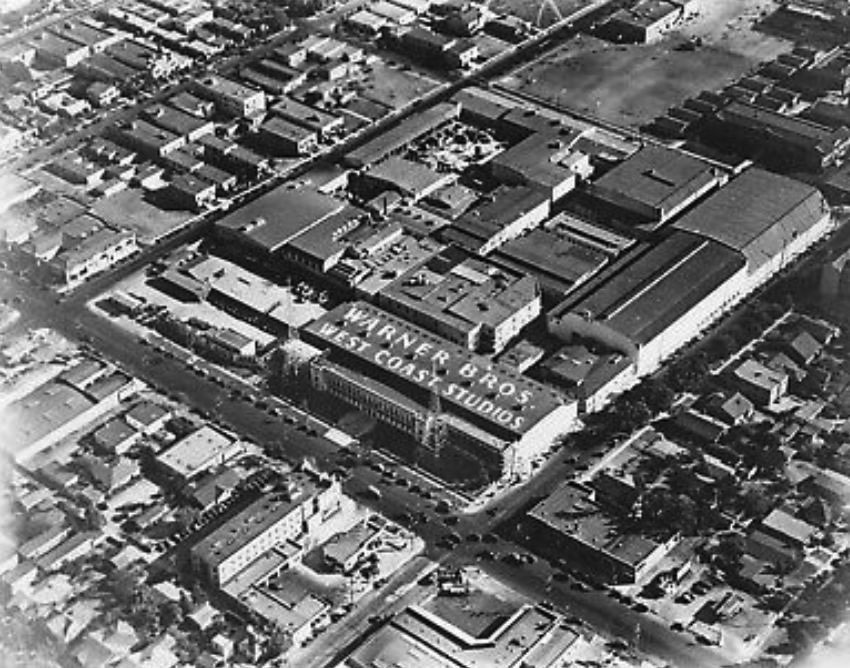 |
|
| (1920s)* – Aerial view looking down at Warner Bros. Studio located at 5800 Sunset Boulevard in Hollywood. The intersection of Sunset Boulevard and Bronson Avenue is seen in the foregournd. |
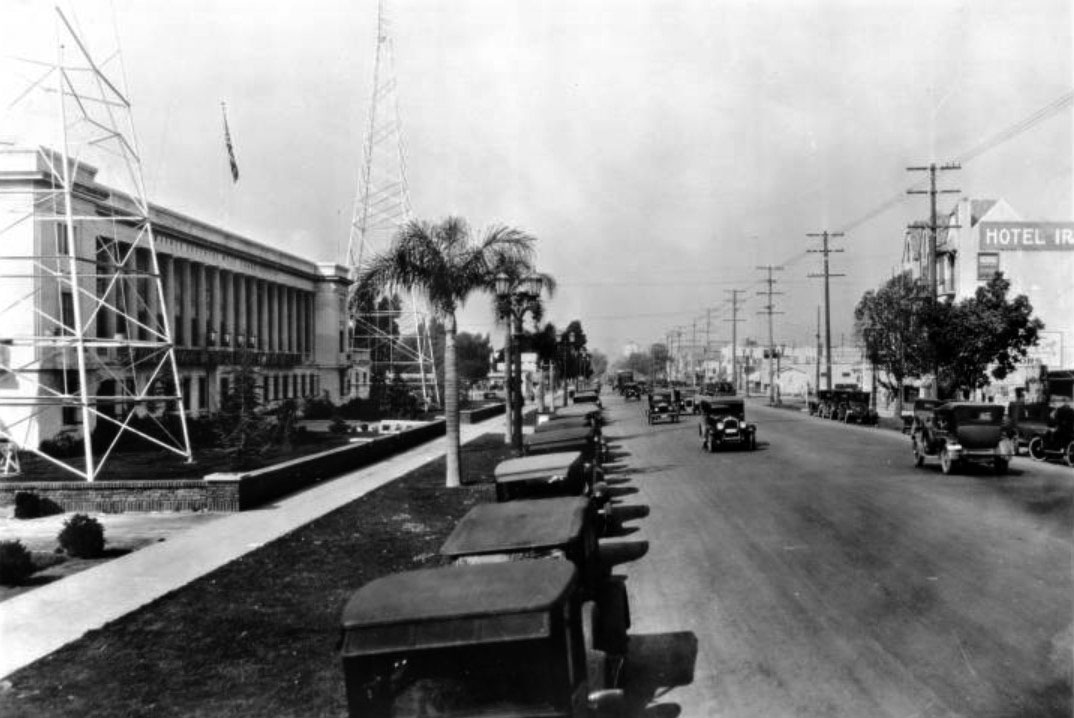 |
|
| (ca. 1926)^ - View of Sunset Boulevard looking west from near Van Ness Avenue showing the Warner Brothers Studio. Automobiles are parked along the left sidewalk while still others navigate the boulevard. To the left, the Romanesque architecture of the Warner Bros. West Coast Studio building can be seen flanked to either side by tall radio towers, with its entranceway supported by Doric columns. Hotel Iris can be seen across the street (This is where Judy Garland once stayed). |
Historical Notes The studio was the site where the first talking feature film, The Jazz Singer, was filmed in 1927.* |
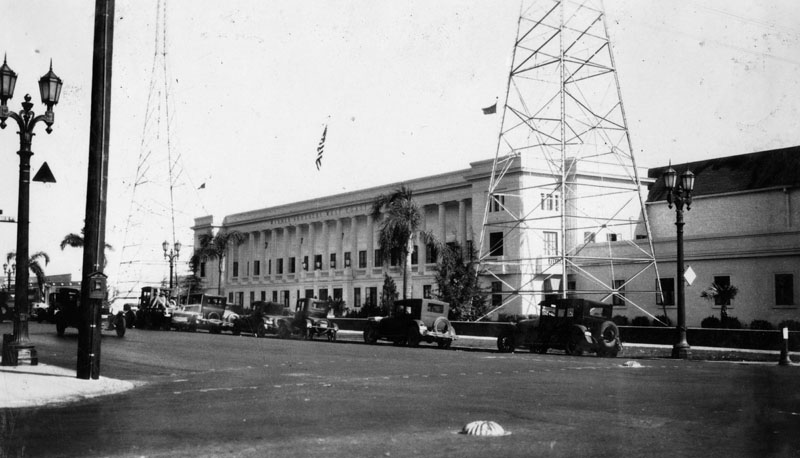 |
|
| (1927)* - View looking southeast from the intersection of Sunset and Bronson Ave showing the Warner Brothers West Coast Studios, located at 5858 Sunset Boulevard. |
Historical Notes In 1925, Sam Warner started KFWB radio station on the lot. Note the station’s two 150-foot towers in the above photo.* |
 |
|
| (1930)* - Sunset Boulevard looking west from Van Ness. To the left is Warner Brothers West Coast Studios; to the right is the Hotel Eldorado, which was prviously the Hotel Iris . |
Historical Notes Warner Bros bought a majority interest in First National Pictures in 1928, consolidating its executive offices into that company’s 1926 Burbank lot after a $500,000 building program was completed in January 1930. Production followed over the hills shortly thereafter. While filming primarily occurred at the Burbank location, some shooting and phonograph recording continued at the Hollywood lot. In the 1930s, Termite Terrace, the animation production unit behind the Merrie Melodies and Looney Tunes cartoons operated out of the Warner Bros Hollywood studio. By the end of 1937, the Warner Bros had vacated their Hollywood home.***# |
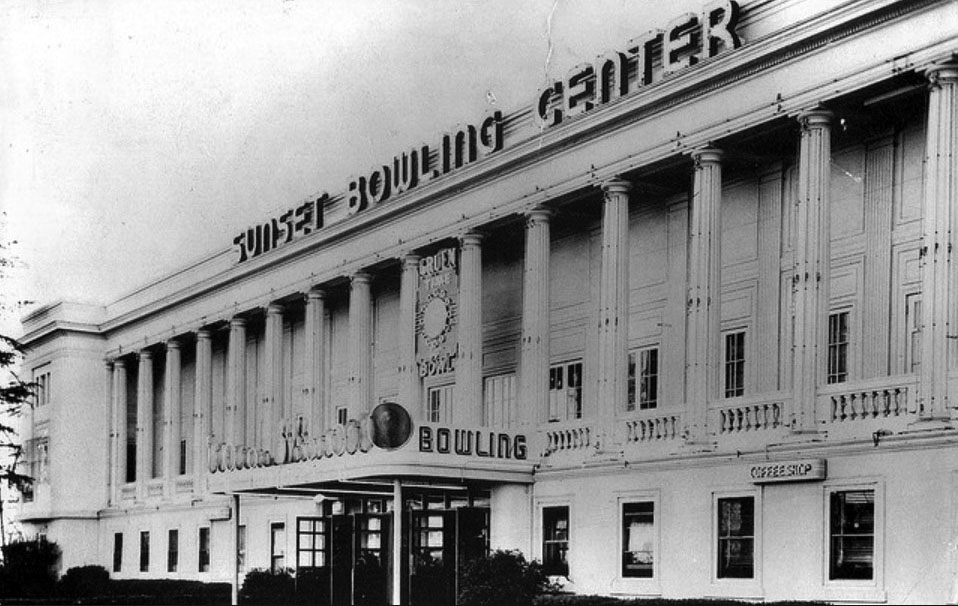 |
|
| (1937)^^** - View of the site of the filming of The Jazz Singer, the first feature film with synchronized sound. Converted to a bowling alley and sports center. |
Historical Notes In 1937, Sam Warner's brother-in-law, Harry Charnas, opened Sunset Bowling Center behind the old executive offices of Warner Bros. Studios. The Sunset Bowling Center was part of a "sports palace" that also contained badminton courts and a skating rink.* |
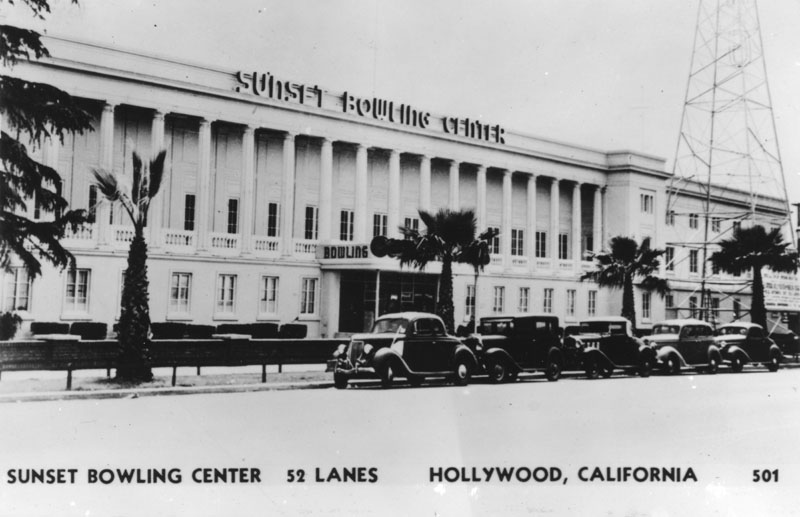 |
|
| (ca. 1941)* - Facade of the Sunset Bowling Center on Sunset Blvd. in Hollywood most likely taken during a bowling tournament held there in 1941. The 1922 building served as the West Coast headquarters of the Warner brothers, Harry, Albert, Sam, and Jack, until 1929. |
Historical Notes With 52 bowling lanes, the Sunset Bowling Center was the largest in the world at that time. Pin boys lived in the loft of the building. The bowling center operated for ten years.* |
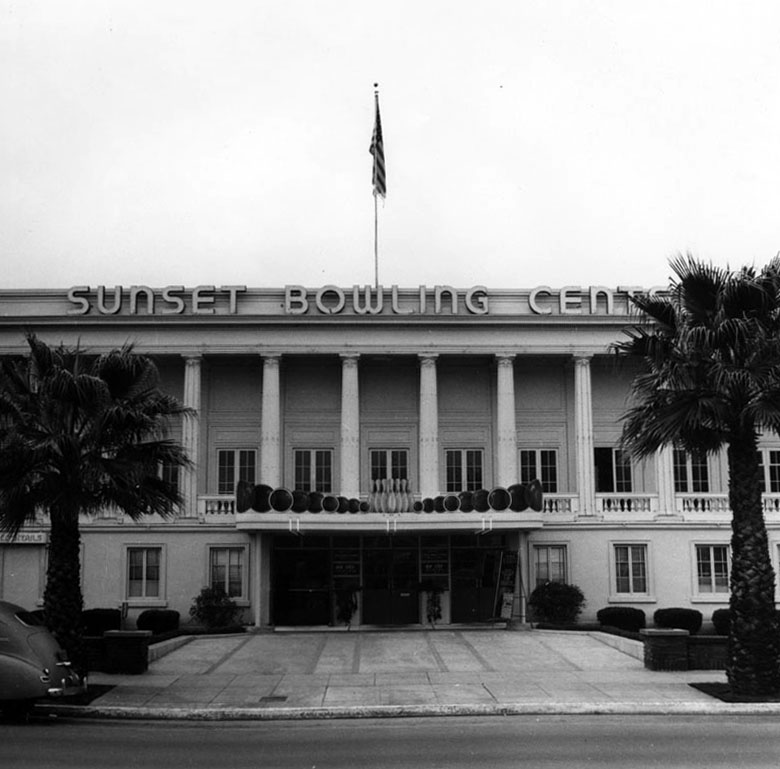 |
|
| (ca. 1940)* - Exterior view of neoclassical style Sunset Bowling Center, located at 5858 Sunset Boulevard in Hollywood. |
Historical Notes In 1954, Paramount bought the site to provide television production facilities for KTLA, which moved to the site in 1958. Gene Autry bought KTLA in 1964, and leased the space from Paramount for three years, after which he bought the property for a whopping $5 million dollars.* In June 1968, radio station KMPC, of which Autry was a principal owner since 1952, also moved to the site.***# |
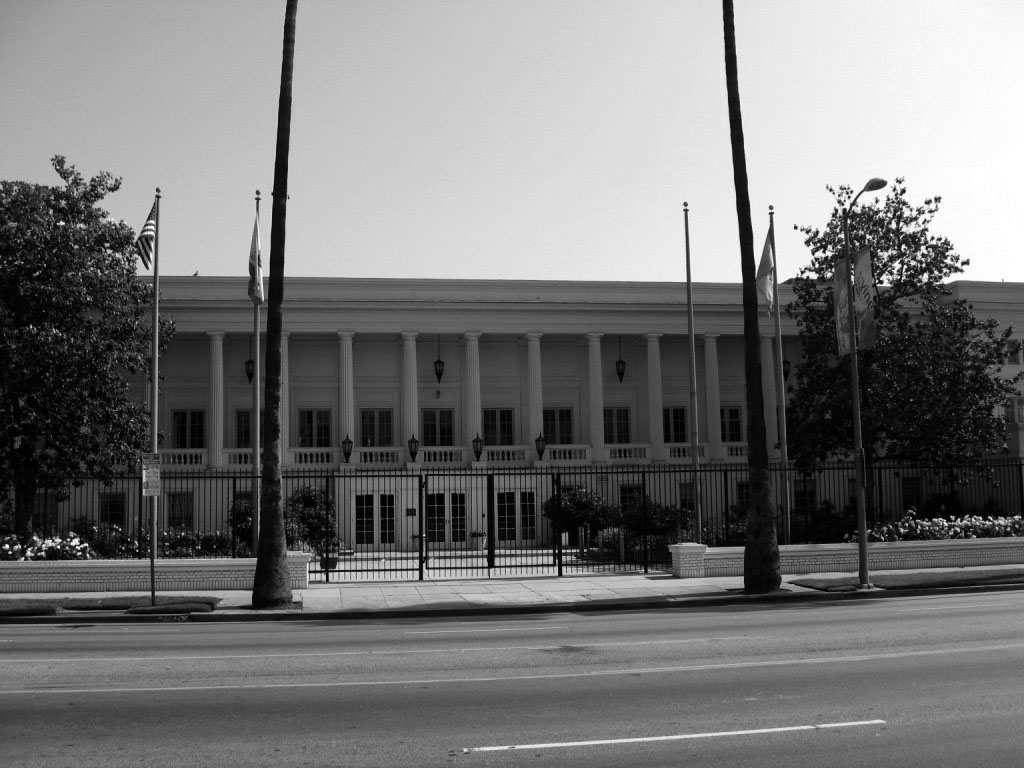 |
|
| (2008)^* - View of the Executive Office Building at the Old Warner Brothers Studio — on Sunset Boulevard, in Hollywood. It is officially called today Sunset Bronson Studios and also known as KTLA Studios and Tribune Studios. |
Historical Notes In 1982, an investment-banking firm bought the lot and KTLA, and three years later, sold out to the Tribune Company. In January of 2008, Hudson Capital purchased the landmark 1920s Warner Bros. Studio for an astounding $130 million dollars.* |
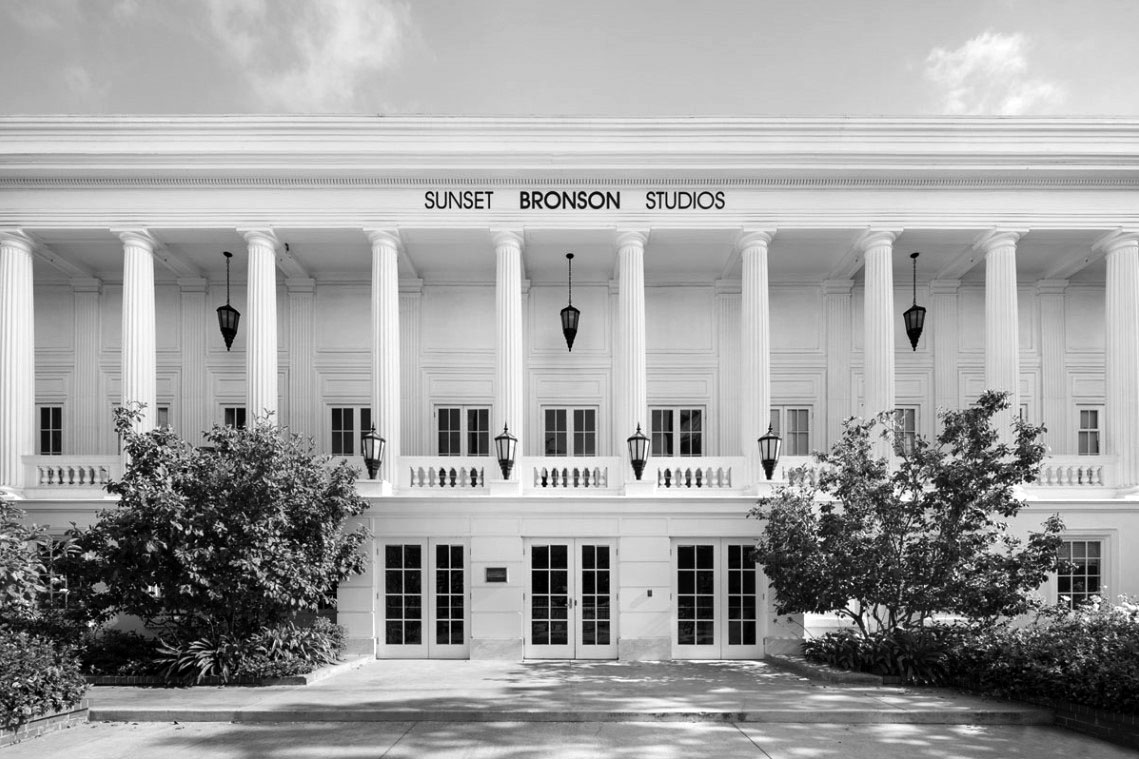 |
|
| (ca. 2014)###* - View of the Sunset Bronson Studios, also known as KTLA Studios and Tribune Studios. |
Historical Notes This beautiful building of classical design, which boasts of a big colonnade of Doric columns, was declared Historic-Cultural Monument No. 180 in 1977 by the city of Los Angeles (Click HERE to see complete listing). Being the "Site of the Filming of the First Talking Film”, the facilities were also listed on the National Register of Historic Places in 2002.^* |
* * * * * |
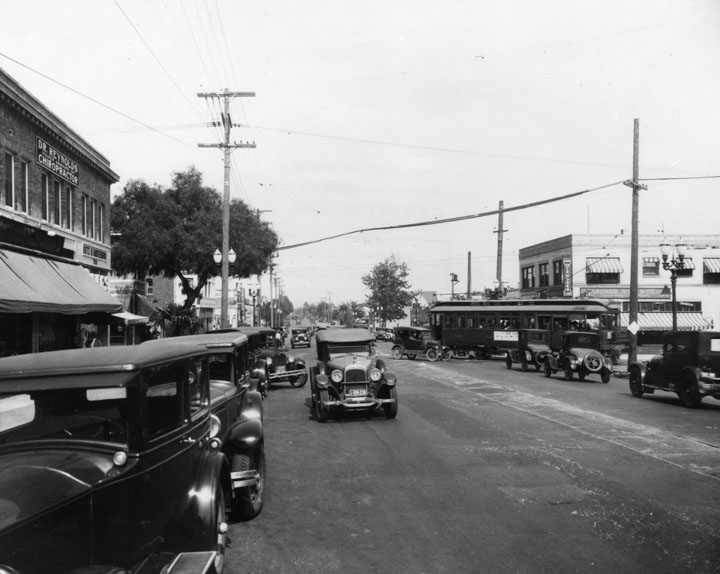 |
|
| (1927)* - A Pacific Electric "red car" is seen crossing Sunset Boulevard diagonally at Gardner Street . "Gardner Junction" was a major stop for Pacific Electric streetcars. View is looking east toward La Brea Ave. |
Historical Notes To get from Hollywood and La Brea to Santa Monica and Fairfax the PE ran on a private way diagonal to the street grid as seen in map below. |
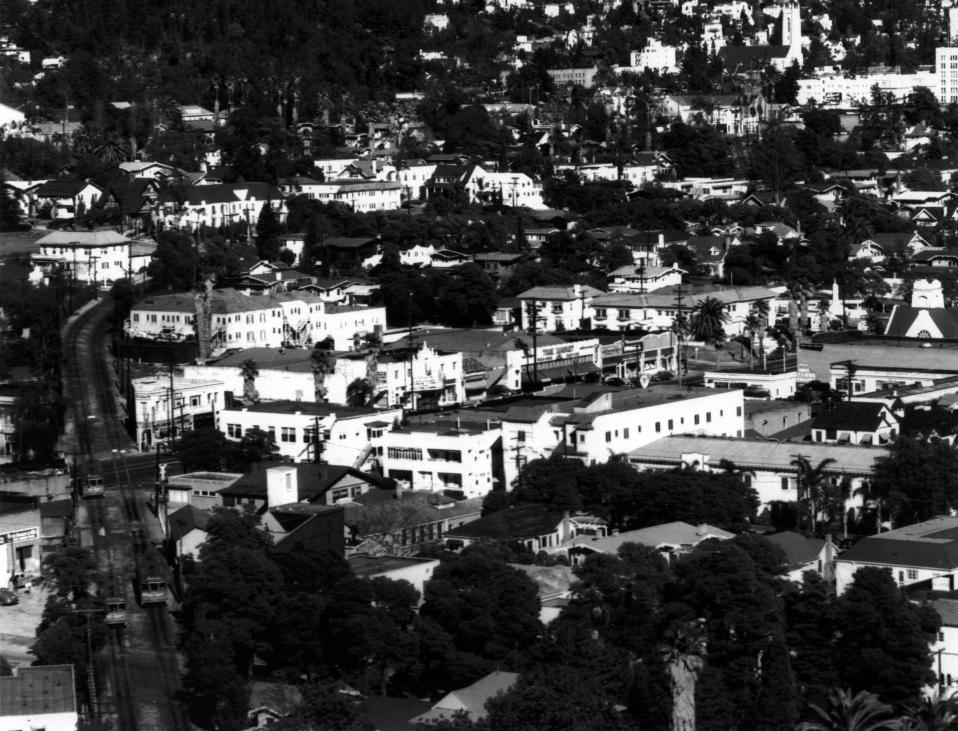 |
|
| (1954)** – Aerial view looking at the Gardner Junction. Three Hollywood streetcars can be seen at lower-left where the tracks cross Sunset Boulevard near Gardner Street. The Oriental Theater can be seen at center-left on Sunset Blvd. Photo courtesy of Ralph Cantos |
Historical Notes Gardner Junction was so named because of its location at Gardner Street and Sunset Boulevard. Click HERE to see more Early Views of Gardner Junction. |
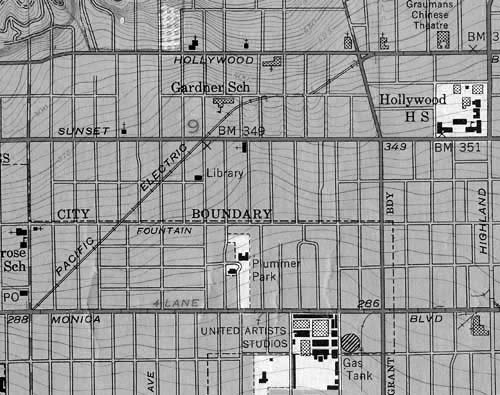 |
|
| Early map showing routing of Pacific Electric streetcars from Hollywood and La Brea (upper-right) to Santa Monica and Fairfax (lower-left). Note that the tracks make a turn near Gardner Elementary School. The 'x' marks the spot of Gardner Junction as seen in previous photo. Grauman's Chinese Theatre and Hollywood High School are located at upper-right. |
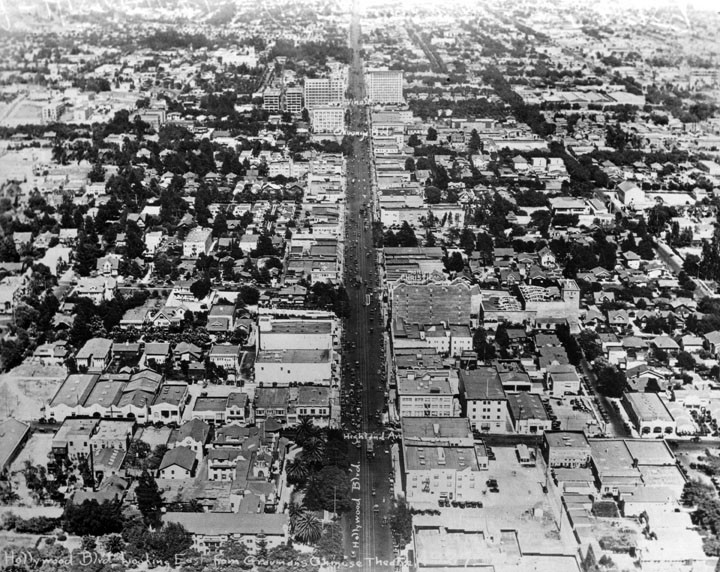 |
|
| (ca. 1926)* - Aerial view of Hollywood Blvd. looking to the east from above the Chinese Theatre. Marked on the photograph are some cross streets: Highland Ave., Cahuenga Blvd. and Vine Street. |
* * * * * |
Hollywood and Highland
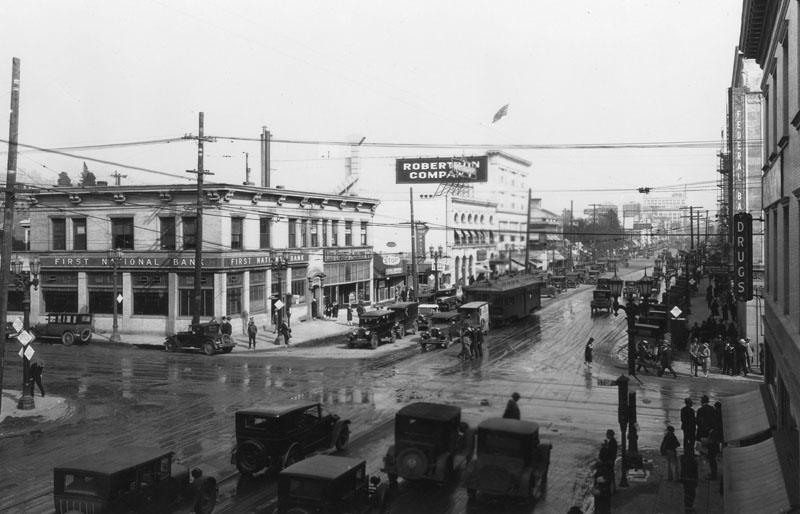 |
|
| (ca. 1926)* - View looking east on Hollywood Boulevard at the intersection of Highland Avenue. The streets are intersected by several streetcar tracks. On the northeast corner can be seen the Hollywood Branch of the Los Angeles-First National Trust & Savings Bank. |
Historical Notes Within a year of when the above photo was taken, the bank building on the northeast corner of Hollywood and Highland would be demolished to make room for the new thirteen story Art Deco First National Bank Building.* |
First National Bank
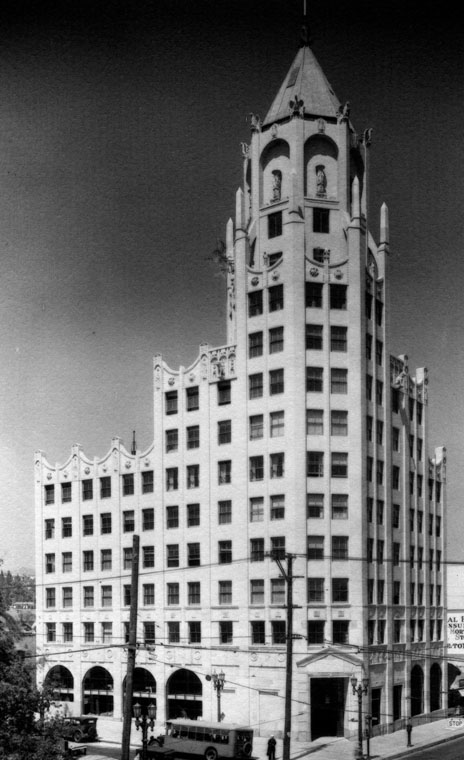 |
|
| (ca. 1927)* - Exterior view of Hollywood First National Bank, located on the northeast corner of Highland Avenue and Hollywood Blvd. |
Historical Notes Built in 1927, the First National Bank building located at 6777 Hollywood Boulevard was designed/constructed by architects Meyer and Holler who are also known for having built Grauman's Chinese Theatre, Grauman’s Egyptian Theatre, and Culver Studios. The same firm served as engineers and also did the construction.* |
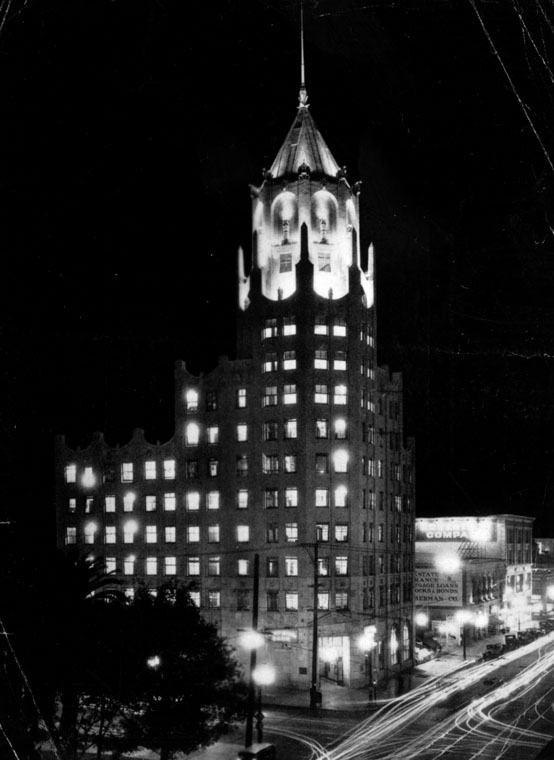 |
|
| (ca. 1928)* - Exterior night view of Hollywood First National Bank, located at 6777 Hollywood Boulevard.. |
Historical Notes The thirteen story building with Gothic/Renaissance elements a la Art Deco is one of a handful of structures in the city that is adorned with gargoyles. It was the tallest building in Los Angeles from 1927 to 1932.* |
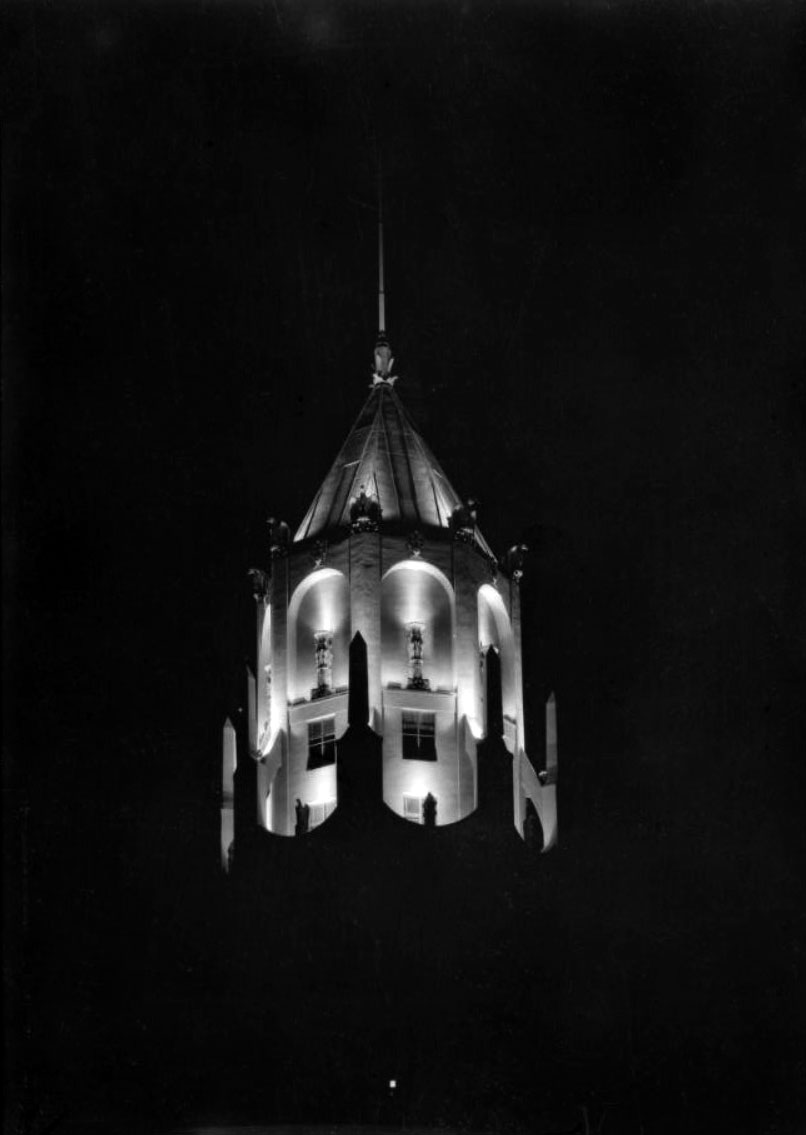 |
|
| (1928)^^ - Night view showing the illuminated Gothic-Style tower of the First National Bank Building in Hollywood. |
Historical Notes The building was occupied by Security Pacific Bank until 2008 and has been vacant since. |
* * * * * |
Hollywood Plaza Hotel
 |
|
| (1927)* - Exterior view, Hollywood Plaza Hotel, located at 1637 North Vine Street, showing the entire front of the building, with cars parked outside. |
Historical Notes Designed by architects Walker & Eisen in 1924, this building was one of four major hotels built in Hollywood in the 1920s and once housed one of the most glamorous nightspots, Clara Bow's "It" Cafe named for and operated by the silent film star.*#^# |
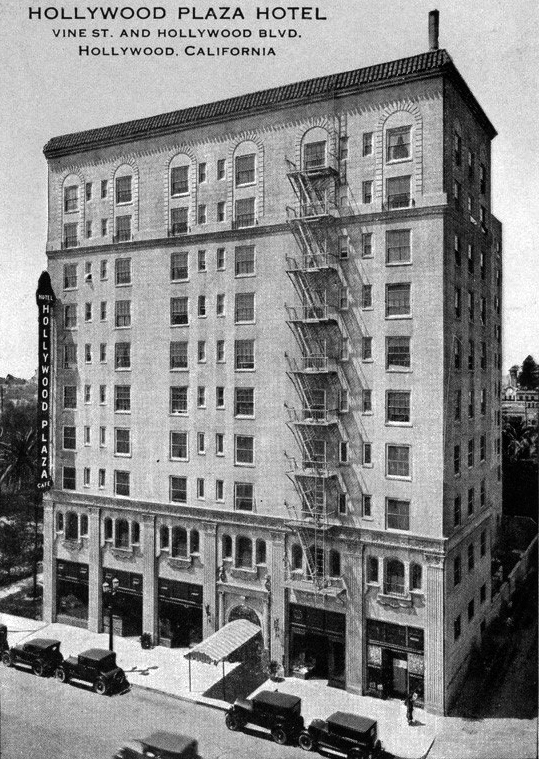 |
|
| (ca. 1927)^^^ - Postcard view showing the Hollywood Plaza Hotel with large signboard on building corner. Note that the overhead power lines have been removed on Vine Street (see previous photo). |
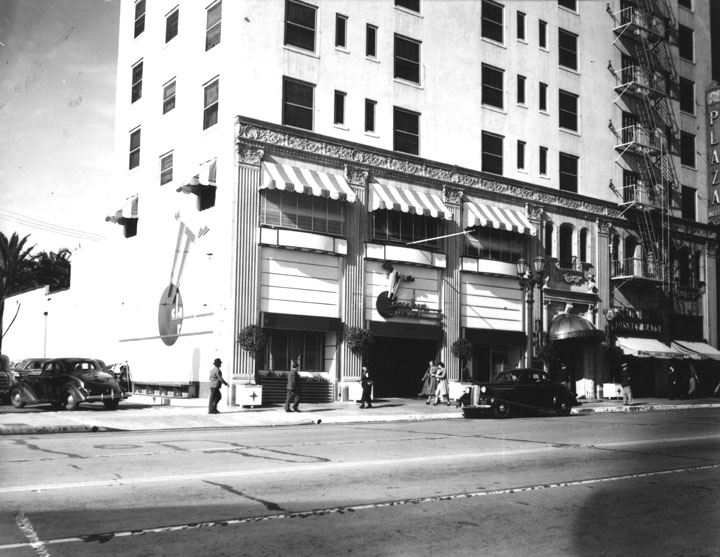 |
|
| (1937)* - View of the ground floor of the Hollywood Plaza Hotel showing Clara Bow's "IT" Cafe (bar and dining room) and Disney Hats (far right). |
Historical Notes Clara Bow and her husband and Rex Bell opened the 'It' Cafe on the ground floor of the Hollywood Plaza Hotel on October 14, 1937; it closed sometime in 1943.* Clara Gordon Bow rose to stardom in silent film during the 1920s. It was her appearance as a plucky shop girl in the film It that brought her global fame and the nickname "The It Girl". Bow came to personify the Roaring Twenties and is described as its leading sex symbol. She appeared in 46 silent films and 11 talkies, including hits such as Mantrap (1926), It (1927) and Wings (1927). She was named first box-office draw in 1928 and 1929 and second box-office draw in 1927 and 1930. Her presence in a motion picture was said to have ensured investors, by odds of almost 2-to-1, a "safe return". At the apex of her stardom, she received more than 45,000 fan letters in a single month (January 1929).*^ |
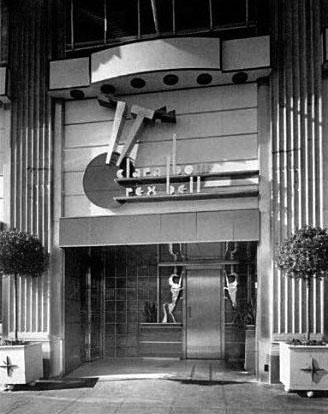 |
(ca. 1937)*# - View of the front entrance to Clara Bow and Rex Bell's "It" Cafe located on the ground floor of the Hollywood Plaza Hotel at 1637 N. Vine Street.
|
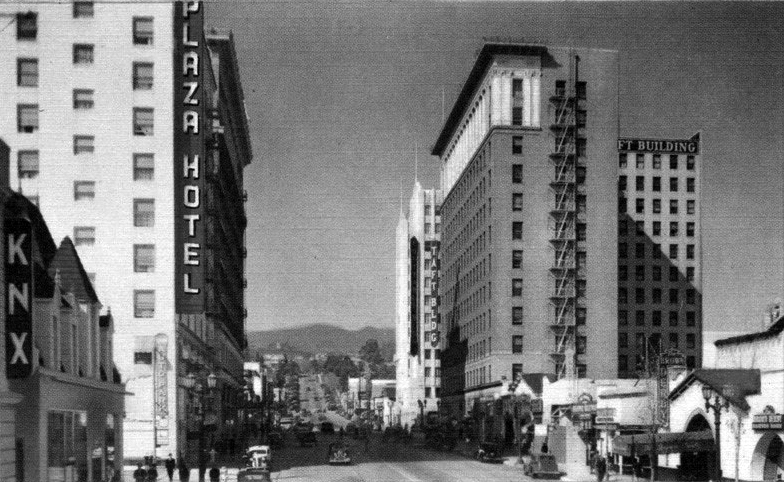 |
|
| (1930s)^^^ – Postcard view looking north on Vine Street showing the Plaza Hotel with large sign on corner of building. Also seen from left to right are: KNX (aka Vine Street Theatre), Broadway-Hollywood, Equitable Building, Taft Building, and the Brown Derby. |
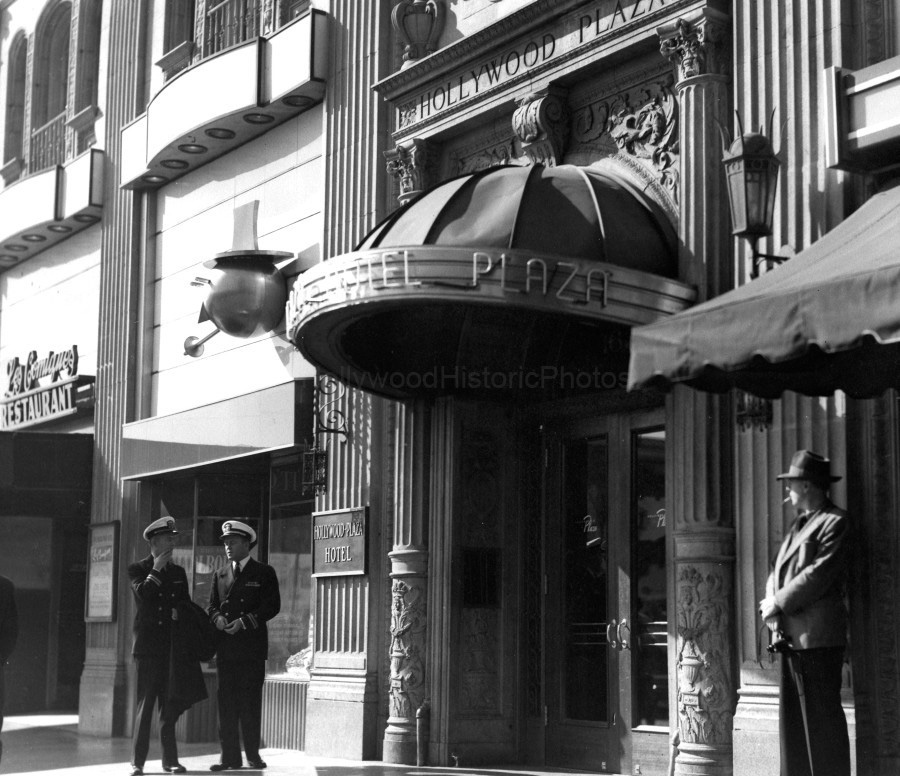 |
|
| (1944)** – View showing entrance to the Hollywood Plaza Hotel at the time of WWII. Note the men in uniform on the left. |
 |
|
| (1945)* - View looking north on Vine Street from Selma Avenue. The Plaza Hotel with its large roof-mounted PLAZA neon signboard stands between the Studio Theater (aka Vine Street Theatre) and The Broadway-Hollywood on the west side of Vine. Across the street is the Taft Building and The Brown Derby. |
Historical Notes In the 1940s and 1950s when many broadcast studios were located on or near Vine Street the Hollywood Plaza Hotel became popular with radio people. George Burns even had offices at the top of the hotel. The popular radio DJ Johnny Grant did his show from the Hollywood Plaza Bar. Grant also did a radio show from midnight - 4:00 a.m. in the nearby Ham and Eggers Restaurant. |
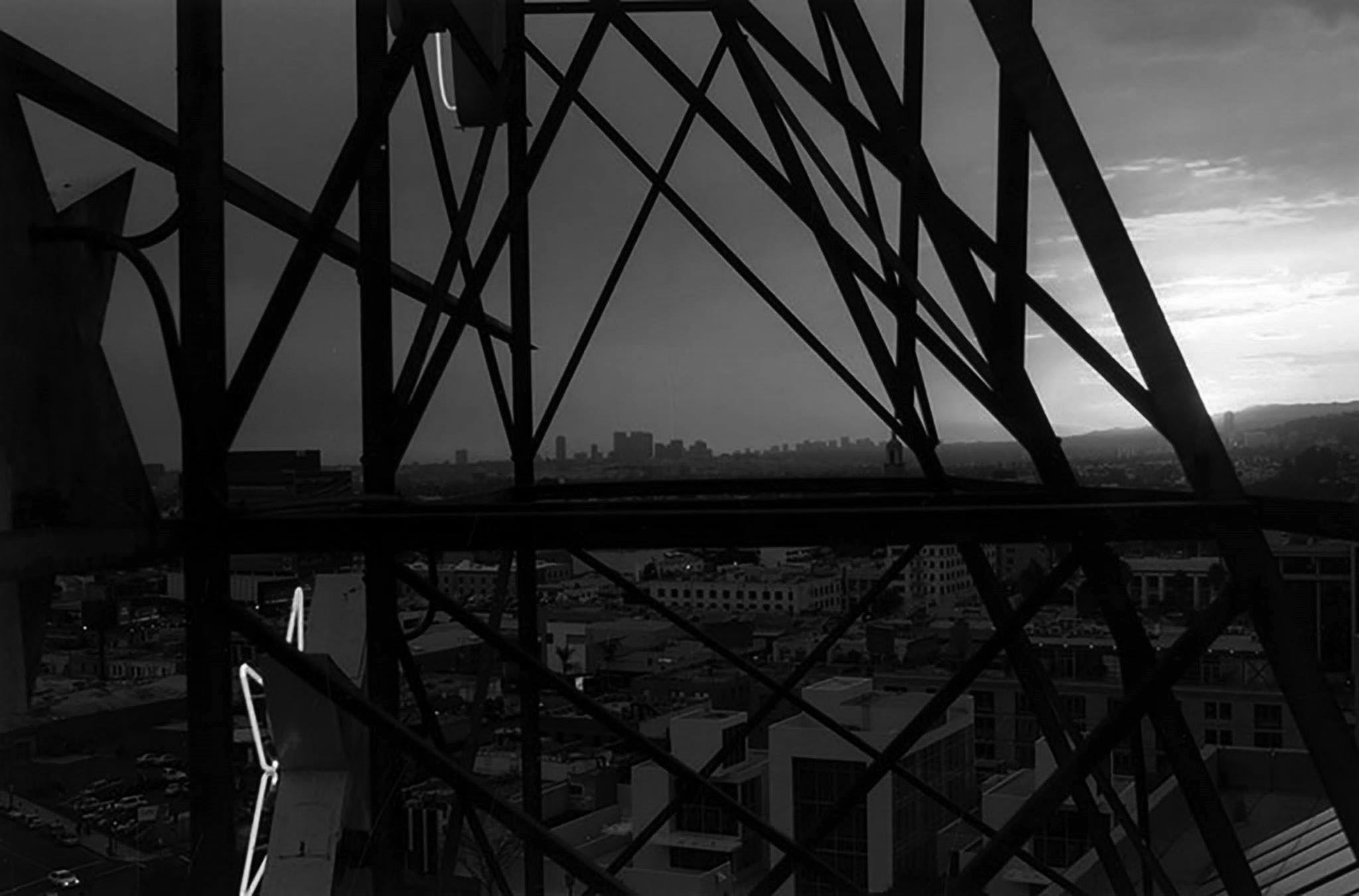 |
|
| (2005)* – View looking toward West Los Angeles at sunset through the rooftop sign of the Plaza Hotel in Hollywood. Photo by Gary Leonard |
Historical Notes The Hollywood Plaza Hotel and its neon sign were designated Los Angeles Historic-Cultural Monument No. 665 in 1999 (Click HERE to see complete listing). |
* * * * * |
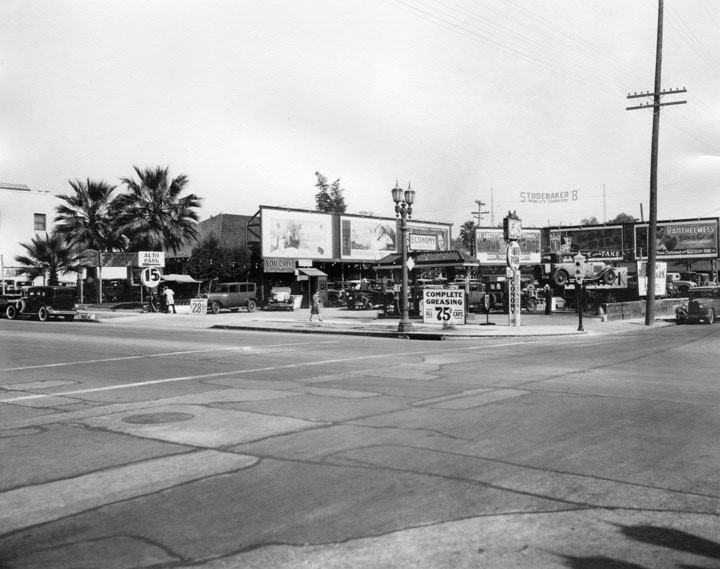 |
|
| (1930)* – View looking at the northeast corner of Vine Street and Selma Avenue showing an "auto park" where a complete greasing for all cars is seventy-five cents, and parking all day is fifteen cents. |
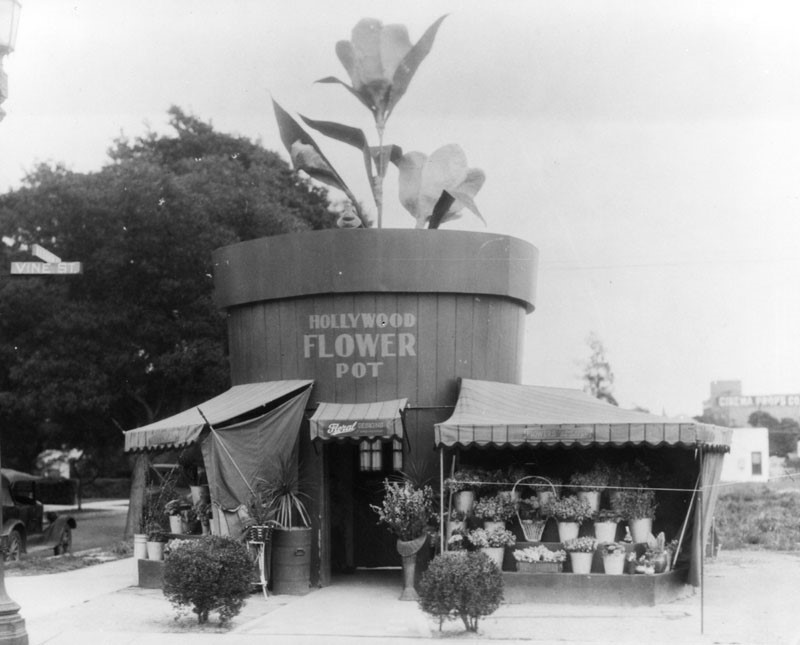 |
|
| (1920s)* - The Hollywood Flower Pot florist in the shape of a flower pot with a plant growing in it, located 1124 N. Vine Street (S/E corner of Vine St and Banner Ave). |
Historical Notes In the 1920s, as the automobile was becoming the default way to get around Los Angeles, buildings and structures in the area became more unique, often resembling the merchandise or services they hawked. These “hey-you-can’t miss-me!” buildings (referred to as Novelty or Programmatic Architecture) were made to pull automobile drivers right off the road. Click HERE to see more examples of Programmatic Architecture. |
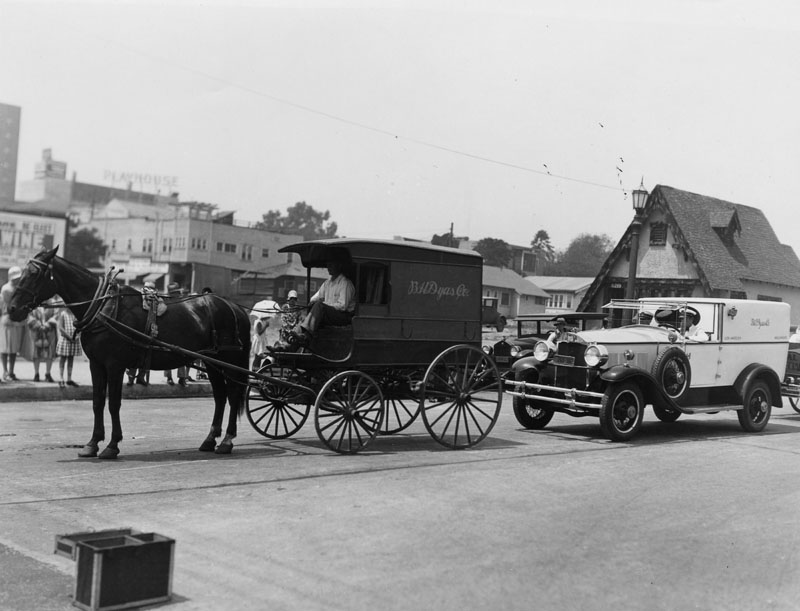 |
|
| (ca. 1927)* - Entries in either the 1927 or 1928 Hollywood Old Settlers Parade include a horse-drawn vehicle with "B.H. Dyas Co." printed on the side, followed by a light-colored truck with the same sign, driven by two uniformed men. The windshield on the truck has been cranked open. |
Historical Notes The B.H. Dyas Co. celebrated its 34th anniversary in 1927. It owned the store in Hollywood at Hollywood and Vine that was later purchased by The Broadway, as well as other stores and restaurants. At one time it owned the largest sporting goods establishment in the United States. Bernal H. Dyas was the owner.* |
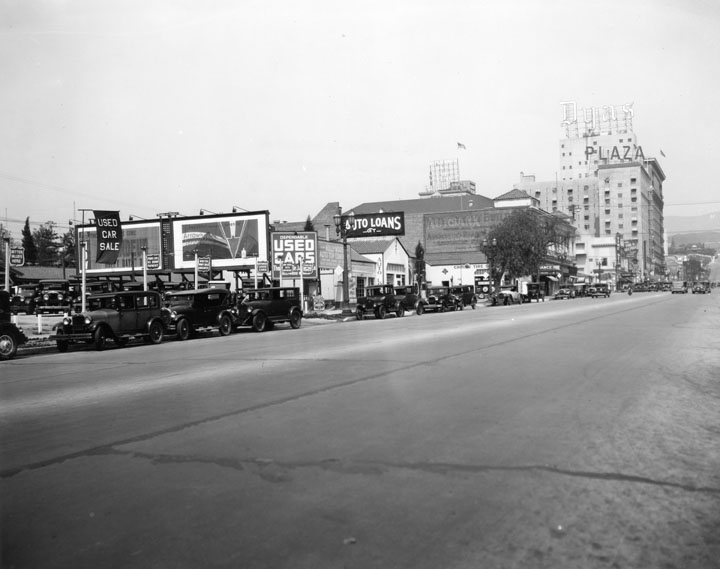 |
|
| (1930s)* - View looking north on Vine Street from Sunset Boulevard. In the distance, near Hollywood Boulevard, can be seen two tall buildings with large roof mounted signboards: The Plaza and B. H. Dyas (later Broadway-Hollywood) |
B. H. Dyas Department Store
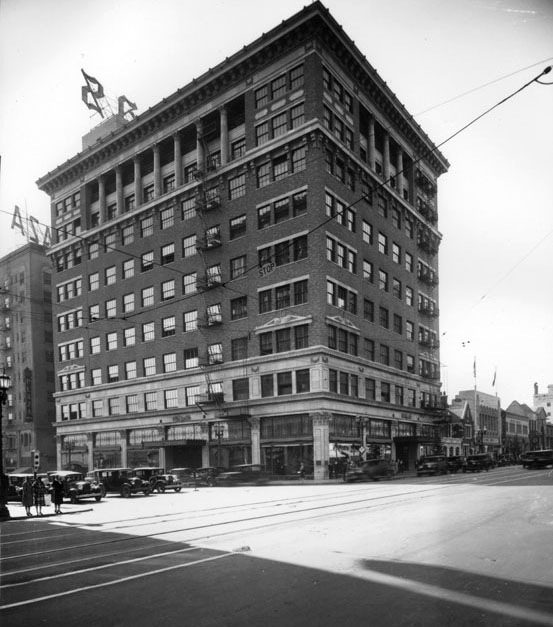 |
|
| (1929)* - View showing the B. H. Dyas Department Store located at 6300 Hollywood Boulevard, on the S/W corner of Hollywood & Vine. Street-railroad tracks run in both directions down Hollywood Blvd. This store later became Broadway-Hollywood, after Broadway purchased B. H. Dyas Co. |
Historical Notes The ten-story B. H. Dyas Building's (later the Broadway-Hollywood Building) construction in 1928 helped to usher in a spatial shift that opened the doors for large-scale retail development outside of downtown Los Angeles. It also was the first department store to introduce women’s slacks.^#* |
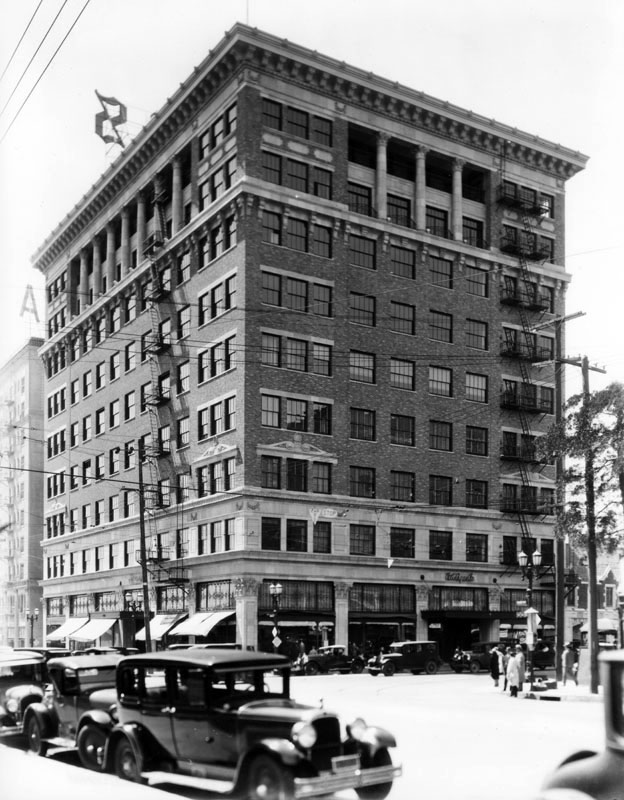 |
|
| (1929)* - View looking southwest at the B. H. Dyas Co. Department Store located on the corner of Hollywood Boulevard and Vine Street. |
Historical Notes Built by local businessman Frank R. Strong and designed in the Classical Revival Style by architect Frederick Rice Dorn, the building initially housed the B. H. Dyas Company Department Store. The move by B. H. Dyas to Hollywood was the first case of a department store developing a branch outside of the downtown core and helped to cement the idea of Hollywood as a retail destination. The store prospered for just a few short years until the Depression did the B. H. Dyas Company in and Broadway jumped in to take it over. ^#* |
 |
|
| (ca. 1932)#**# – View looking west on Hollywood Boulevard as seen from the Dyas Department Store on the S/W corner of Hollywood and Vine. Shoppers and cars fill the street with the Nichols Dollar Store and I. Magnin & Co. seen further down the block. Note the very rare 1932 Lincoln parked in left front. |
Historical Notes In 1931-32, Dyas Department Store became the Broadway-Hollywood. |
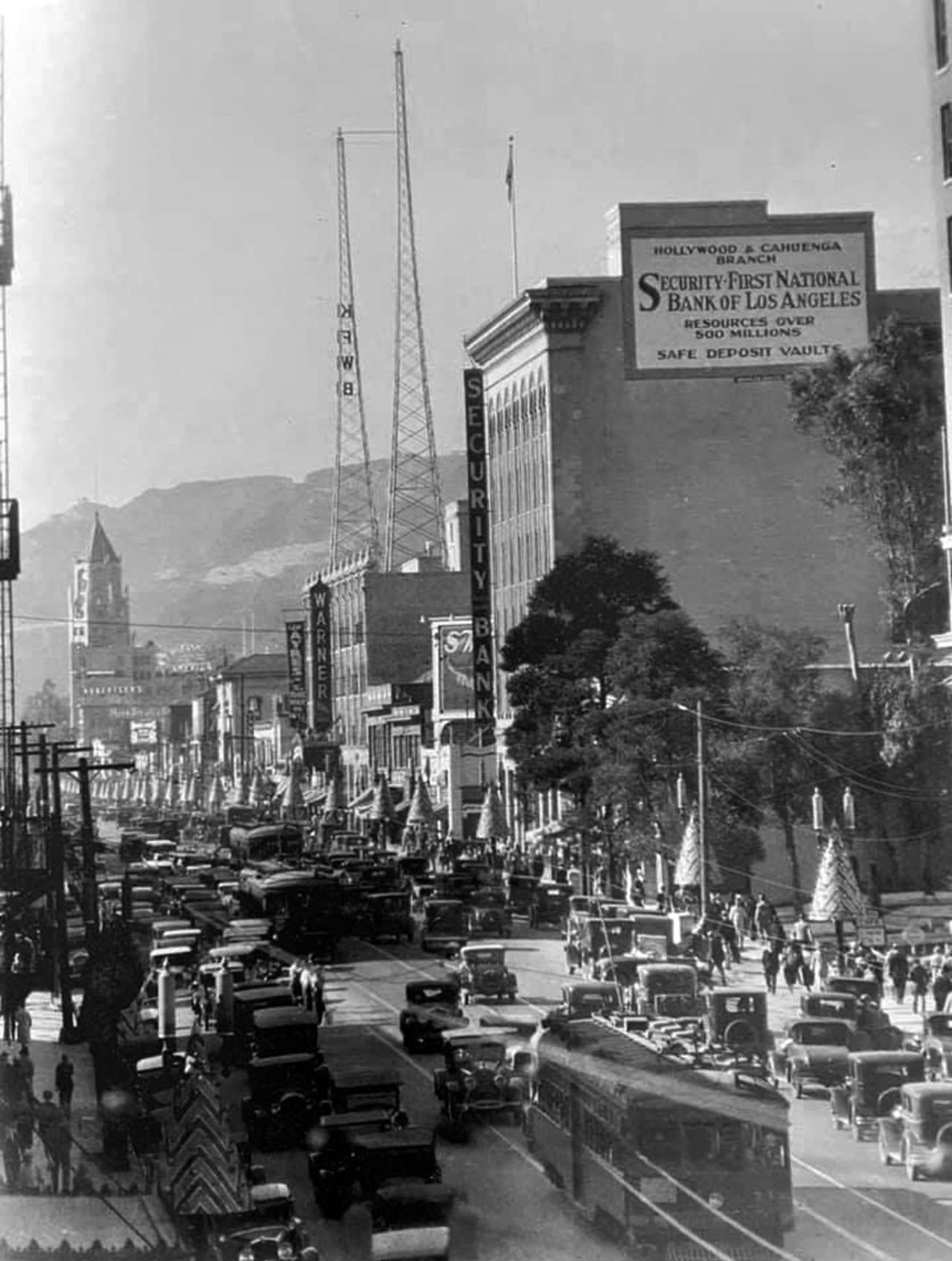 |
|
| (1930)* - View looking west on a congested Hollywood Boulevard during the holiday season. |
I. Magnin & Co.
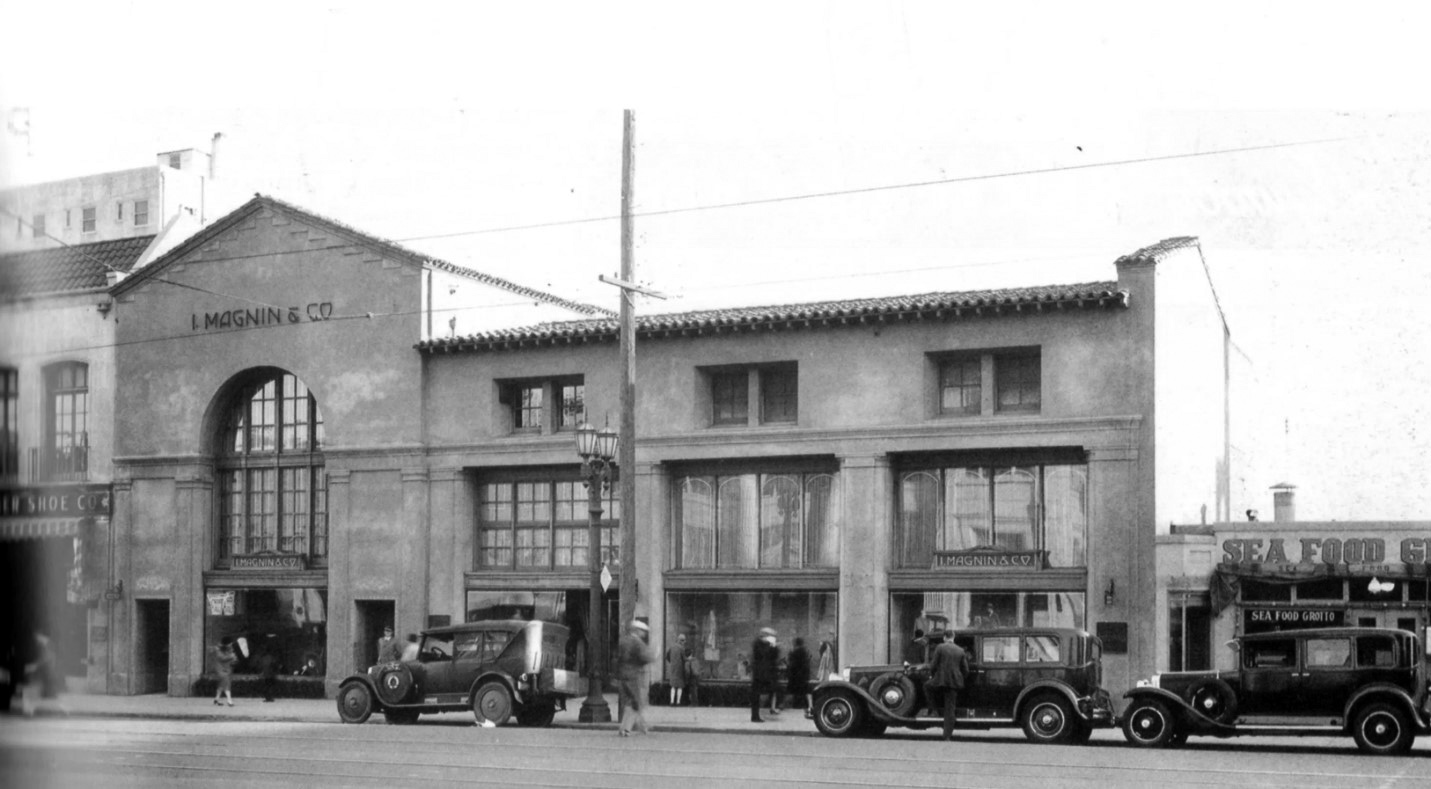 |
|
| (1930s)^.^ – View looking at I. Magnin’s & Co. located at 6340 Hollywood Boulevard, built 1923. |
Historical Notes In the early 1870s, Dutch-born Mary Ann Magnin and her husband Isaac Magnin left England and settled in San Francisco. Mary Ann opened a shop in 1876 selling lotions and high-end clothing for infants. Later, she expanded into bridal wear. As her business grew, her exclusive clientele relied on her for the newest fashions from Paris. I. Magnin imported clothing by major designers including Jeanne Lanvin, Hattie Carnegie, and Christian Dior. At the turn of the century, Mary Ann’s four sons entered the business. While John Magnin, Grover Magnin, and Sam Magnin became associated with the I. Magnin store, the fourth son, Joseph Magnin, became known for his own store (Joseph Magnin Co.). Daughter Flora married Myer Siegel, who launched a namesake department store in Los Angeles, which would later become a chain. In Los Angeles in 1897 and 1898, I. Magnin & Co. advertised its wares for retail sale at 237 S. Spring St., noting that Mr. Myer Siegel was the manager. The I. Magnin store that Siegel managed moved to 251 S. Broadway on January 2, 1899; on June 19, 1904, I. Magnin announced that the Los Angeles store would henceforth be known as "Myer Siegel". I. Magnin would return with its own Los Angeles-area retail store later when it opened boutiques in the Maryland Hotel in Pasadena and the Ambassador Hotel in Mid-Wilshire, Los Angeles, and in Hollywood (seen above). In 1939, I. Magnin left Hollywood and moved to a landmark store at 3240 Wilshire Boulevard near Bullocks Wilshire, designed by Myron Hunt, architect of the Ambassador Hotel.)^ |
The Broadway-Hollywood
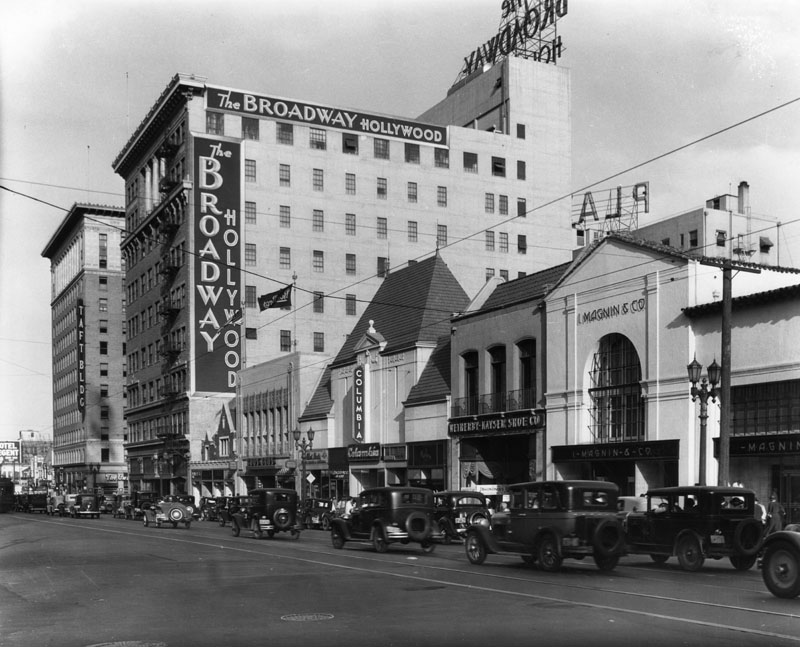 |
|
| (ca. 1932)* - View of the south side of Hollywood Boulevard looking east between Ivar and Vine. The Broadway-Hollywood Building (previously B. H. Dyas Building) is on the corner of Vine, with the Taft Building across the street. I. Magnin & Co. is seen on the right. |
Historical Notes In 1932, the building became the keystone to the Broadway Department Store chain. In 1938, fueled by increased revenues, The Broadway Department Store constructed a seven-story addition to the building’s south side providing 52,000 square feet of additional retail space. ^#* |
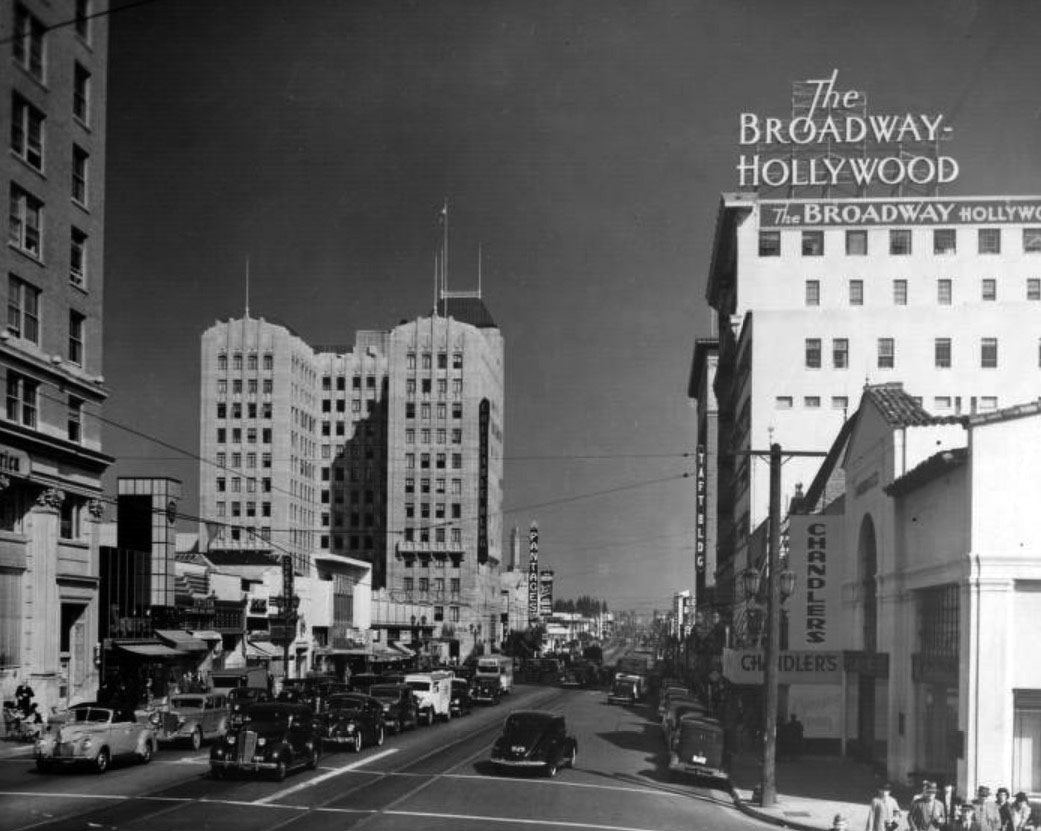 |
|
| (ca. 1939)^^ – View looking east on Hollywood Boulevard showing The Broadway-Hollywood Building with its new roof-mounted sign and its new 8-story annex to the west. The Equitable Building is seen on the left (N/E corner of Hollywood and Vine). |
Historical Notes In 1939, an eight-story modern annex designed by Parkinson and Parkinson was built immediately to the west. The Broadway Department Store served as a tenant until the 1970s. In the 1980s, the building was reconfigured for office use. By 1987 the building was abandoned.*^ |
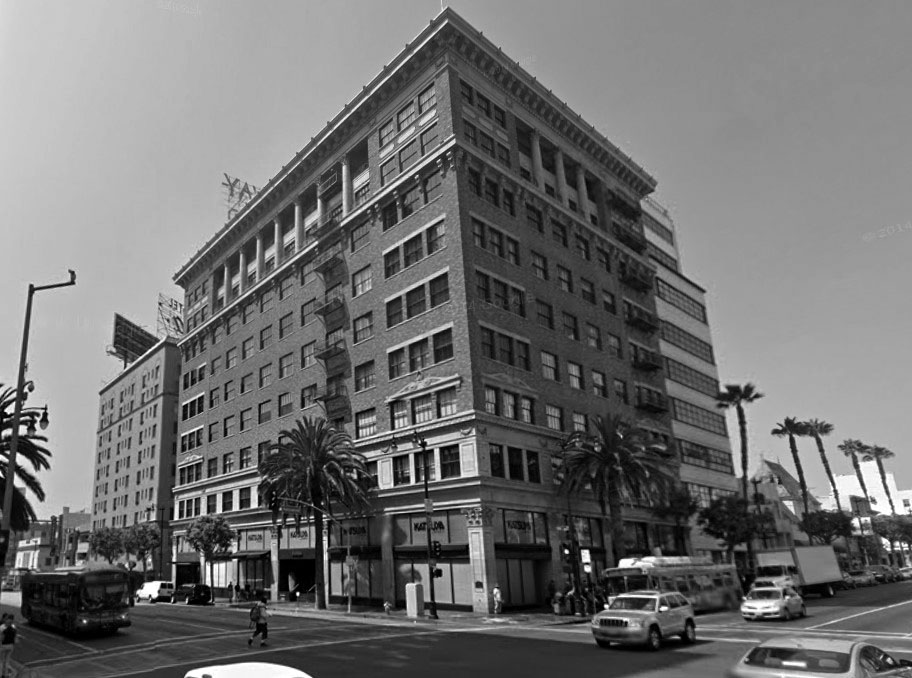 |
|
| (2014)*### – Google street view showing the Broadway-Hollywood Building located on the southwest corner of Hollywood and Vine. |
Historical Notes More recently, the building has been converted to condominiums on the top eight floors and is now called The Broadway-Hollywood. Atop the main building is the large, metal-formed, neon sign reading: “The Broadway Hollywood". ^#* |
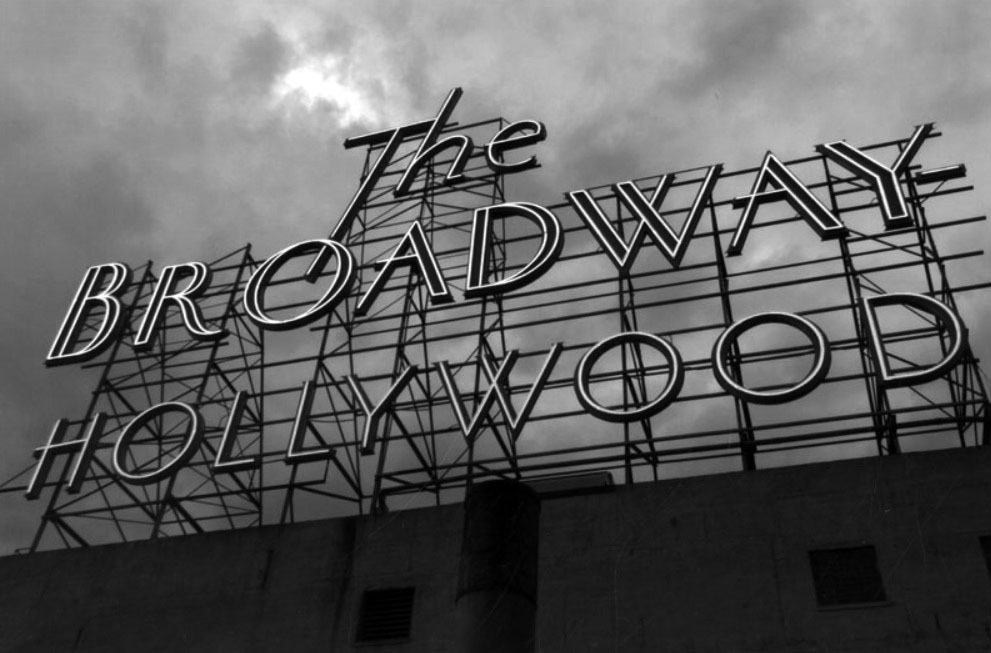 |
|
| (2005)* - Rooftop of the Broadway-Hollywood on Vine Street in Hollywood. The neon sign that reads "The Broadway - Hollywood" is lit and looks crisp against the gray sky. Architects were Walker and Eisen. |
Historical Notes In 1999, the Broadway Department Store Building and Neon Sign were designated Los Angeles Historic-Cultural Monument No. 664 (Click HERE to see complete listing). |
* * * * * |
Please Support Our CauseWater and Power Associates, Inc. is a non-profit, public service organization dedicated to preserving historical records and photos. Your generosity allows us to continue to disseminate knowledge of the rich and diverse multicultural history of the greater Los Angeles area; to serve as a resource of historical information; and to assist in the preservation of the city's historic records.
|
More Historical Early Views
Newest Additions
Early LA Buildings and City Views
History of Water and Electricity in Los Angeles
* * * * * |
References and Credits
* LA Public Library Image Archive
^*California Historic Landmark Listing (Los Angeles)
^ California Historical Society Digital Archive
**Retronaut - Hollywoodland Sign
^#Selig Film News - Hollywoodland Sign
***The Story of Hollywood by Gregory Paul Williams
**^Table Magazine: LA Observatory
^**Huntington Digital Library Archive
**+Hollywood Renegades Archive: "The Lot"
^^*Cinema Treasures: Granada/Oriental Theater
^##The Los Angeles Travel Guide: Hollywood Architecture
##*The Daily Mirror: Garden Court Apartments; Security Trust and Savings Bank
**#Daily News: Hollywood Sign Celebrates its 90th Birthday
*^*MTA Transportation and Research Library Archives
^v^Discover Los Angeles: The Story of An LA Icon
*^^*Vintage Los Angeles - Facebook.com: Bernheimer Japanese Mansion
*^#*Calisphere: University of California Image Archive
*^#^Hollywood High School – National Register of Historic Places Application
^^**Flickr.com: Floyd Bariscale - Sunset Bowling Center
**##MartinTurnbull.com: Judy Garland; Warner Bros Studios
#**#Facebook.com: Garden of Allah Novels, Martin Turnbull
##++Pinterest.com: Historical and Vintage Photos of Los Angeles and Hollywood
#^^*DWP - LA Public Library Image Archive
##^#LAist.com: Why Vine Becomes Rossmore
*#*#Facebgook.com - Great Photos from Los Angeles' Past: Hollywoodland Sign
^*^#Facebook.com - Bizarre Los Angeles
^##*Flickr.com: Michael Ryerson
^#**A Brief Egyptian Theatre History
^#*^Flickr.com: espensorvik: Hollywood High School Mural
**^*^Pacific Coast Architecture Database; Bard's Hollywood Theatre (Vista Theatre)
^^^##Sunset Bronson Studios: Hudson Pacific Properties
^###*Big Orangle Landmarks: Warner Bros
*# Skyscraperage.com. - Griffith Observatory; Hollywoodland Sign; Oriental Theater; "It" Cafe; Aerial of Burbank and Hollywoodland Sign; Pickford-Fairbanks Studio Lot; Shakespeare Bridge; Prospect Studios; Byrn Mawr; Outpost Sign
*^ Wikipedia: Hollywood; Hollywood Athletic Club; Hollywood Bowl; Grauman's Chinese Theatre; Grauman's Egyptian Theatre; Pantages Theatre (Hollywood); John Hanson Ford Theatre; 20th Century Fox; Samuel Goldwyn.Studio; Barnsdall Art Park; Greek Theatre; Griffith Observatory; Cinerama Dome; Ralphs; Hollywood Palladium; Hollywood and Vine; Hollywood Masonic Temple; Hollywood Pacific Theatre; Max Factor; West Hollywood; Brown Derby; Hollywood Christmas Parade; Clara Bow; Decoration Day; Charlie Chaplin Studios; Metro Studios; Old Warner Bros. Studio; Lasky-DeMille Barn; Typewriter; Prospect Studios; Broadway-Hollywood
< Back
Menu
- Home
- Mission
- Museum
- Major Efforts
- Recent Newsletters
- Historical Op Ed Pieces
- Board Officers and Directors
- Mulholland/McCarthy Service Awards
- Positions on Owens Valley and the City of Los Angeles Issues
- Legislative Positions on
Water Issues
- Legislative Positions on
Energy Issues
- Membership
- Contact Us
- Search Index